Early Views of Hollywood (1920 +)
Historical Photos of Early Hollywood |
.jpg) |
|
| (1928)* - View of Hollywood Bowl's shell, stage, seating and adjacent hills with development. Built in 1928. Architect: Lloyd Wright. |
Historical Notes For the 1928 season, Lloyd Wright built a fiberglass shell in the shape of concentric 120-degree arches, with movable panels inside that could be used to tune the acoustics. It was designed to be easily dismantled and stored between concert seasons; apparently for political reasons this was not done, and it did not survive the winter.*^ |
 |
|
| (1929)* - Close-up view of the Hollywood Bowl. An orchestra rehearses on stage. Photograph dated July 12, 1929. |
Historical Notes For the 1929 season, the Allied Architects built the shell that stood until 2003, using a transite skin over a metal frame. Its acoustics, though not nearly as good as those of the Lloyd Wright shells, were deemed satisfactory at first, and its clean lines and white, almost-semicircular arches were copied for music shells elsewhere. As the acoustics deteriorated, various measures were used to mitigate the problems, starting with an inner shell made from large cardboard tubes (of the sort used as forms for round concrete pillars) in the 1970s, which were replaced in the early 1980s by large fiberglass spheres (both designed by Frank Gehry) that remained until 2003. These dampened out the unfavorable acoustics, but required massive use of electronic amplification to reach the full audience, particularly since the background noise level had risen sharply since the 1920s. The appearance underwent other, purely visual, changes as well, including the addition of a broad outer arch (forming a proscenium) where it had once had only a narrow rim and the reflecting pool in front of the stage that lasted from 1953 till 1972. Sculptor George Stanley designed the Muse Fountain. He had previously done the Oscar statuette.*^ |
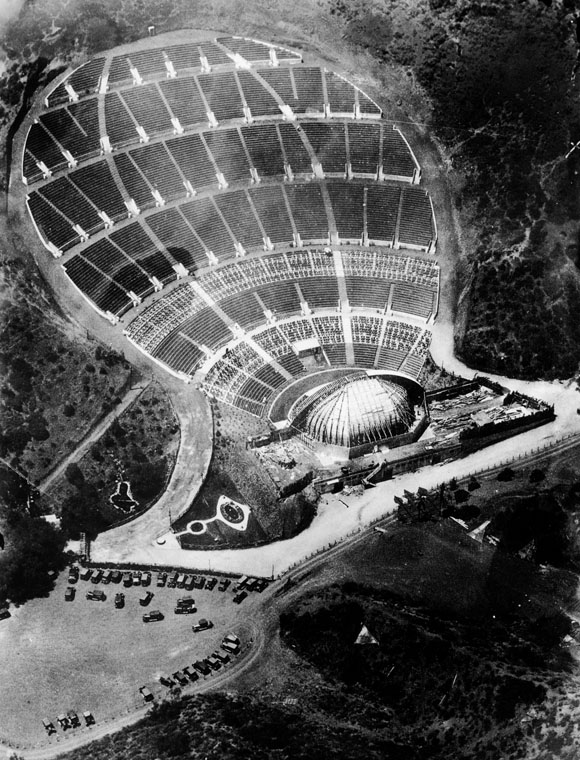 |
|
| (1929)* - Closeup view of the Hollywood Bowl. An orchestra rehearses on stage. Photograph dated July 12, 1929. |
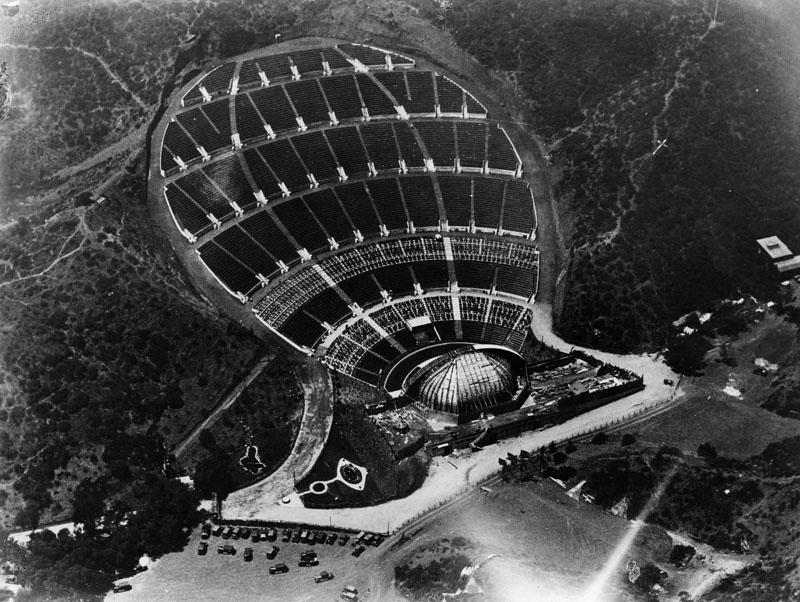 |
|
| (1929)* - A slightly higher aerial view of the Hollywood Bowl during the same rehearsal. |
Click HERE to see more in Early Views of the Hollywood Bowl |
Santa Monica Boulevard
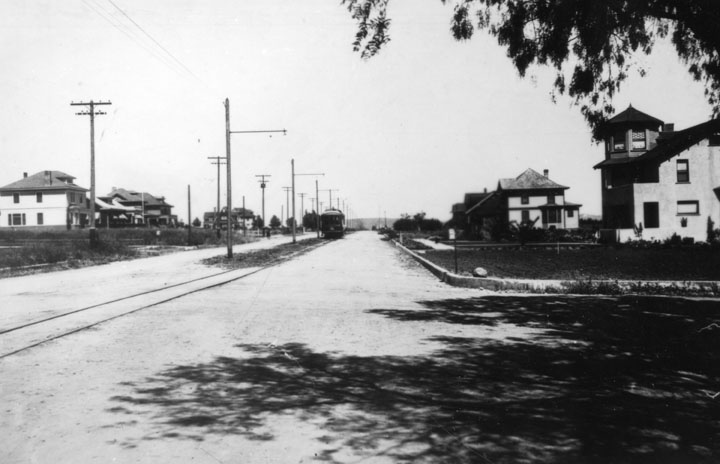 |
|
| (1929)* - An early picture of Hollywood looking northeast from Santa Monica Boulevard and Highland Avenue. An electric steetcar is seen in the distance. |
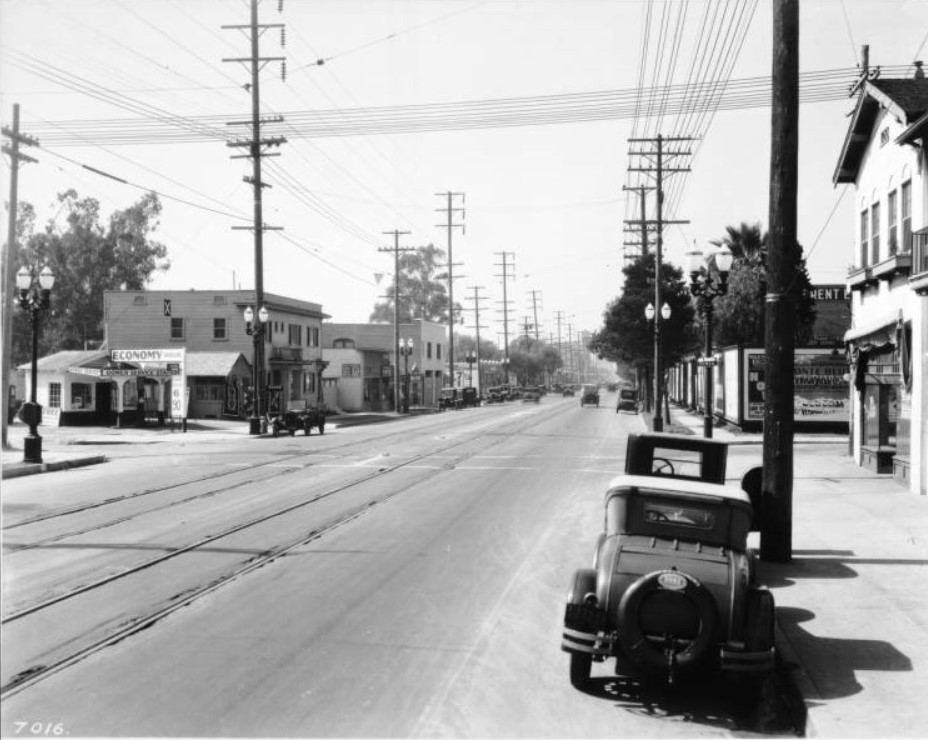 |
|
| (1929)^^ - View looking west on Santa Monica Boulevard from Gower Street. Cable-car tracks are seen running though its center. |
* * * * * |
Vine Street
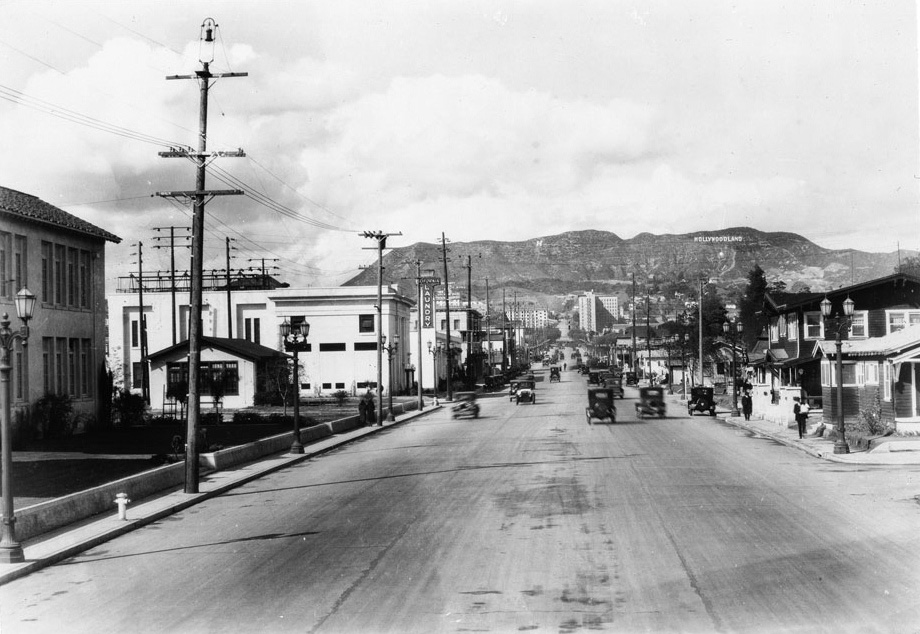 |
|
| (ca. 1925)^^ - View looking north on Vine Street from Barton Avenue* with the Hollywoodland Sign seen in the distance at the top of the Hollywood Hills. On the left is Vine Street Elementary School. Further up on the northwest corner of Vine and Romaine streets stands DWP's Power Distribution Station No. 6. (Click HERE to see more Early Power Distribution Stations). |
Historical Notes *Barton Avenue was named for Barton Jones, grandson of Cornelius Cole. Cornelius Cole owned one of the original Spanish/Mexican landgrants, what is now known as Hollywood, then was dubbed Colegrove after his wife, Olive Colegrove. There are several streets now named after the family; Cole St., Willoughby Ave., Eleanor St. and Seward St.*^ |
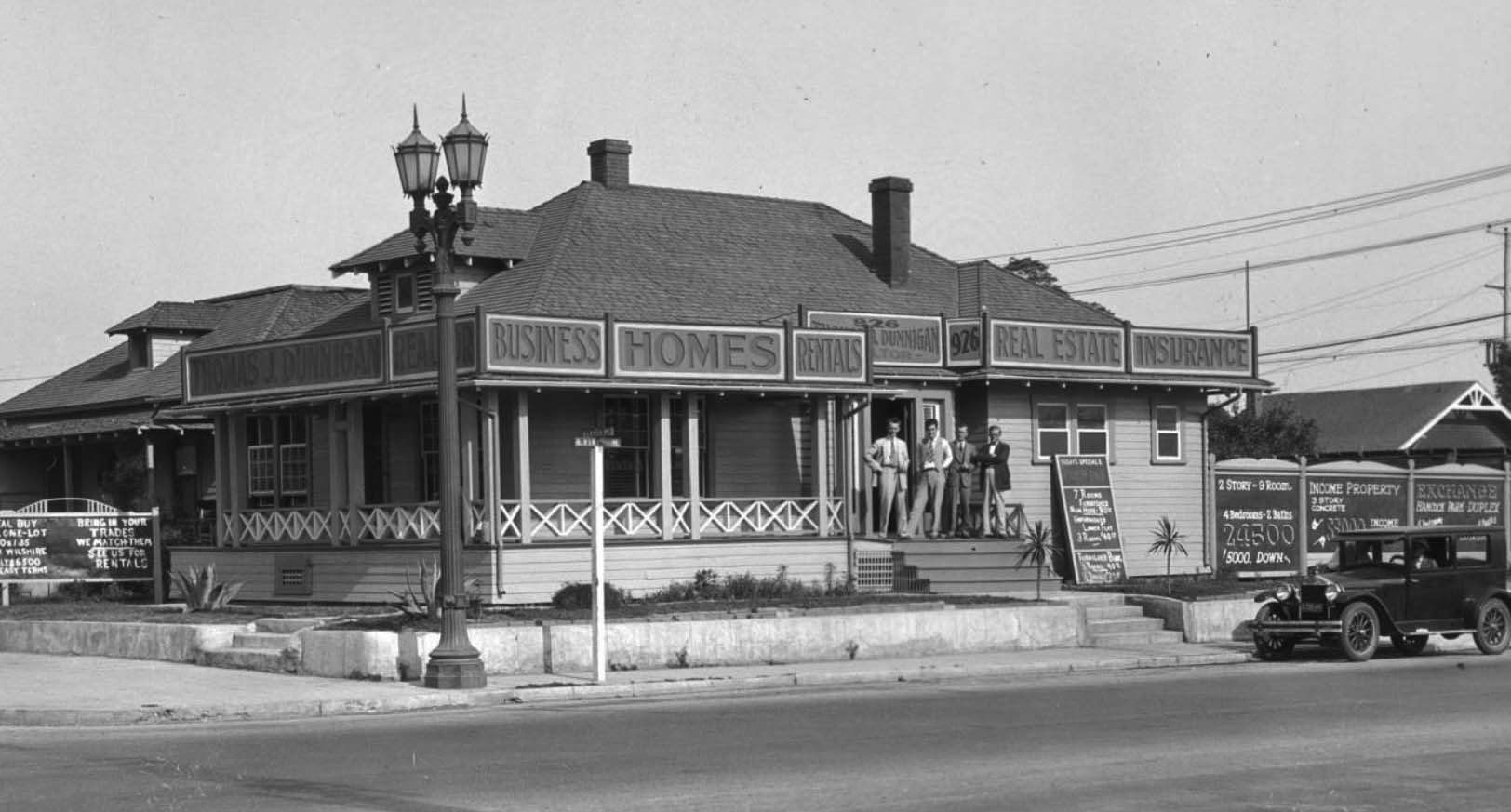 |
|
| (ca. 1929)^^ – View showing four men standing by the entrance to the Thomas J. Dunnigan Real Estate Office located at 926 Vine Street, on the southeast corner of Vine and Barton. Click HERE for contemporary view. |
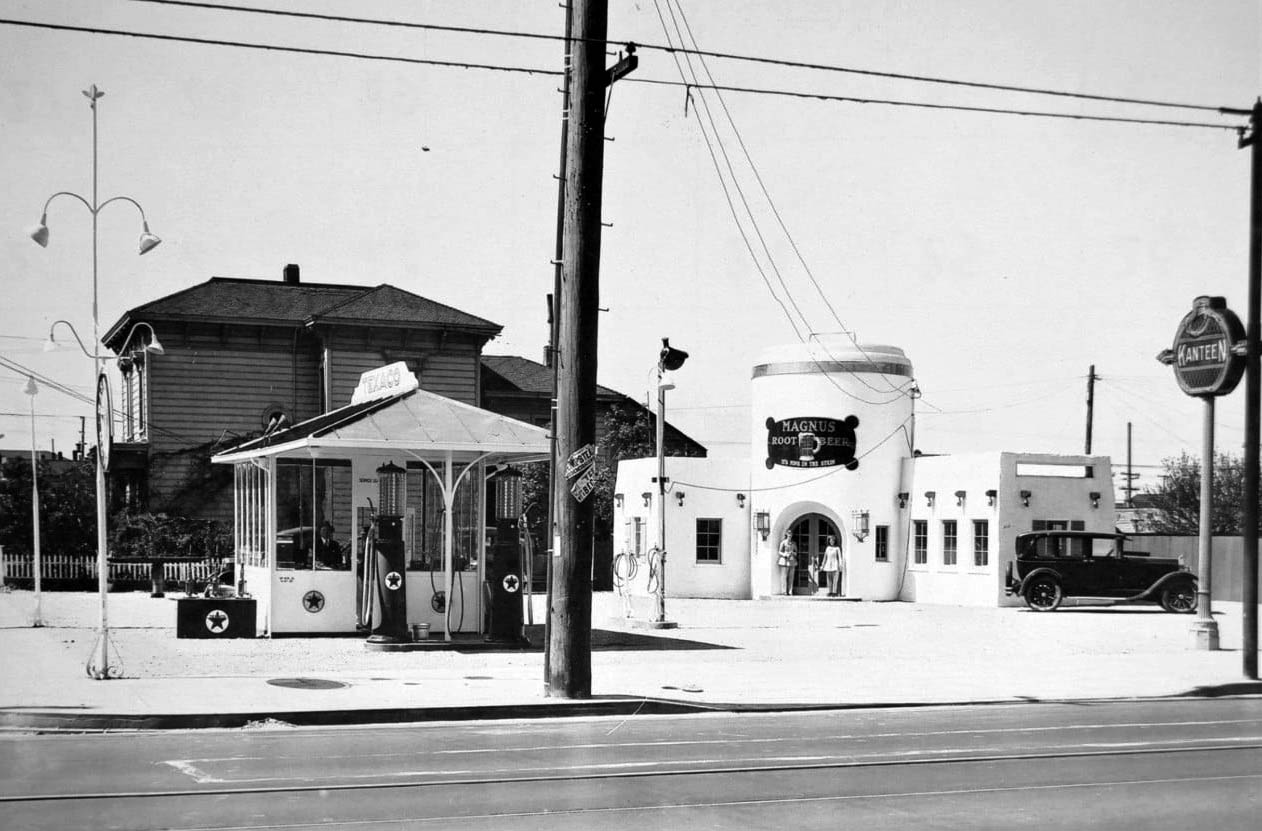 |
|
| (ca. 1929)^.^ – View showing a two-pump Texaco gas station teamed with a Kanteen - Magnus Root Beer Restaurant with car service located at 766 N. Vine Street (just south of Waring Ave), in Hollywood. Today the Oinskter Restaurant can be found where the combo Texaco sation and Magnus restaurant once stood. Click HERE for contemporary view. |
Historical Notes The National Kanteen Company was based in Oakland. An Oakland Tribune article dated January 27, 1929 talks about the new chain of Magnus Root Beer Restaurants (aka Kanteen Stations): “Kanteen stations are rapidly being built in various parts of California….the buildings are unique in that the top of the cylinder affords a complete ladies’ dressing room. The floor plans allow for counter, booth and car service by one person. Each feature in the building is specifically designed to render kanteen quick service. The stations are 100 per cent electrically equipped by California manufacturers. All equipment is bout in California.”* |
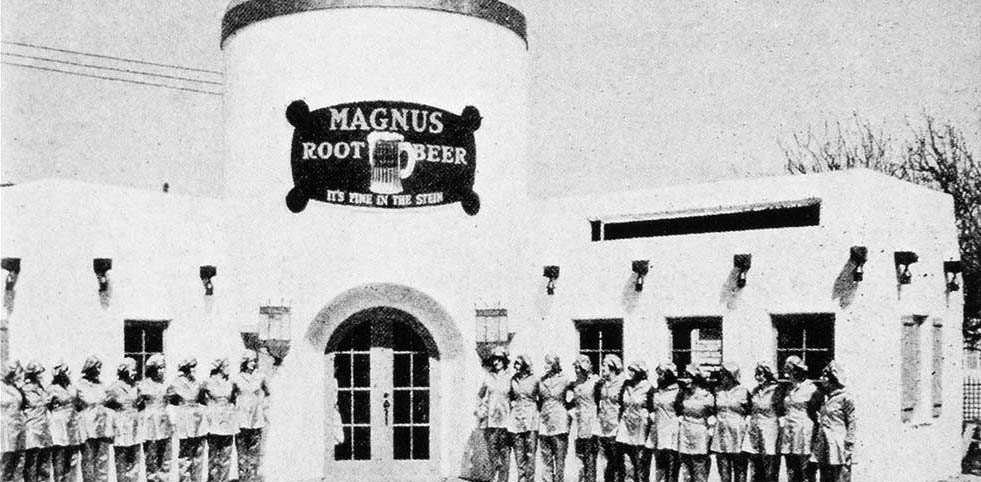 |
|
| (ca. 1929)^ – View showing the Magnus Root Beer Drive-in restaurant located near the corner of Waring Ave and Vermont Street in Hollywood. The center of the building was built to resemble a large beer mug. The sign on the face of the larger than life mug reads: Magnus Root Beer, “It’s fine in the stein”. The National Kanteen Co. built a number of Magnus Root Beer drive-ins throughout California including two of which were located in Hollywood. |
Historical Notes The National Kanteen Co built two of these eye-catching Mangnus Root Beer drive-in restaurants in Hollywood in 1929 including the one seen above. This building falls under the category of Programmatic Acrchitecture. |
* * * * * |
Vine Street Theatre
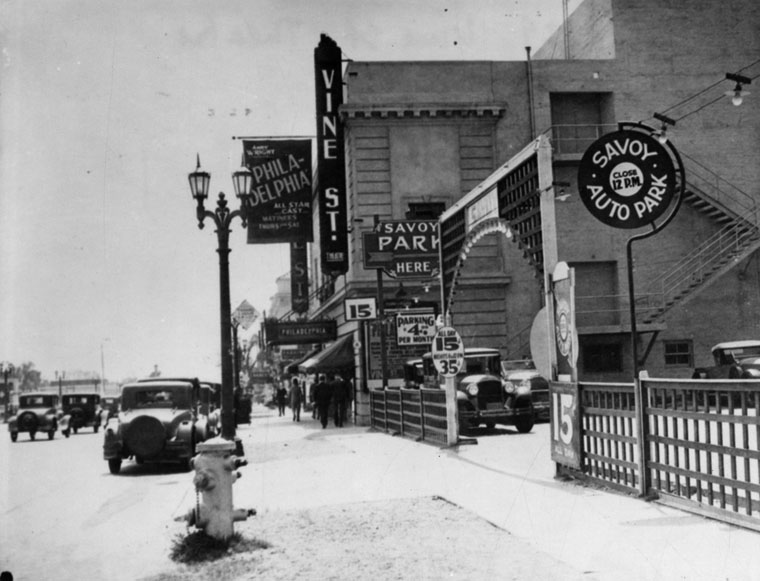 |
|
| (1929)* - View looking south on Vine Street showing the Vine Street Theatre (today the Ricardo Montalbán Theater) located at 1615 North Vine Street. Banner hanging from the front of the theatre reads. "Andy Wright presents, Philadelphia, all star cast. Matinees, Thurs. and Sat." Note the Savoy Auto Park adjacent to the theatre. Parking rates are 15 cents a day or $4.00 a month. |
Historical Notes Named the Wilkes Brothers Vine Street Theatre in honor of its builders, the Beaux Arts live-performance theater was built in 1926-1927. It was the first legitimate Broadway-style theatre in Hollywood. The theatre was designed by architect Myron Hunt, also known for other notable buildings including the Rose Bowl, Cal Tech, and the Ambassador Hotel. The premier performance was “An American Tragedy” by Theodore Dreiser. The theater also had a memorable run of the play “Philadelphia” during its early years. The theater features orchestra, mezzanine, loge and balcony seating.^^* |
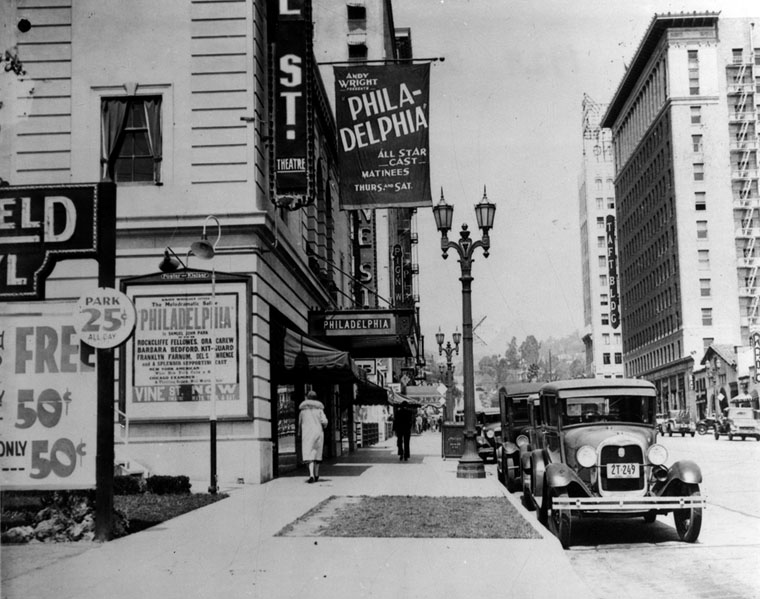 |
|
| (1929)* - View looking north on Vine Street showing the Vine Street Theatre. The Taft Building is seen on the right, located at the southeast corner of Hollywood and Vine. Banner reads, "Andy Wright presents, Philadelphia, all star cast, Matinees Thurs. and Sat." |
Historical Notes During the depression of the 1930’s, the theater was renamed Mirror and became a cinema. It later became the Lux Theatre when it was purchased by the Columbia Broadcasting (CBS) for local affiliate KNX radio and was used as a live performance radio auditorium and local radio station.^^* |
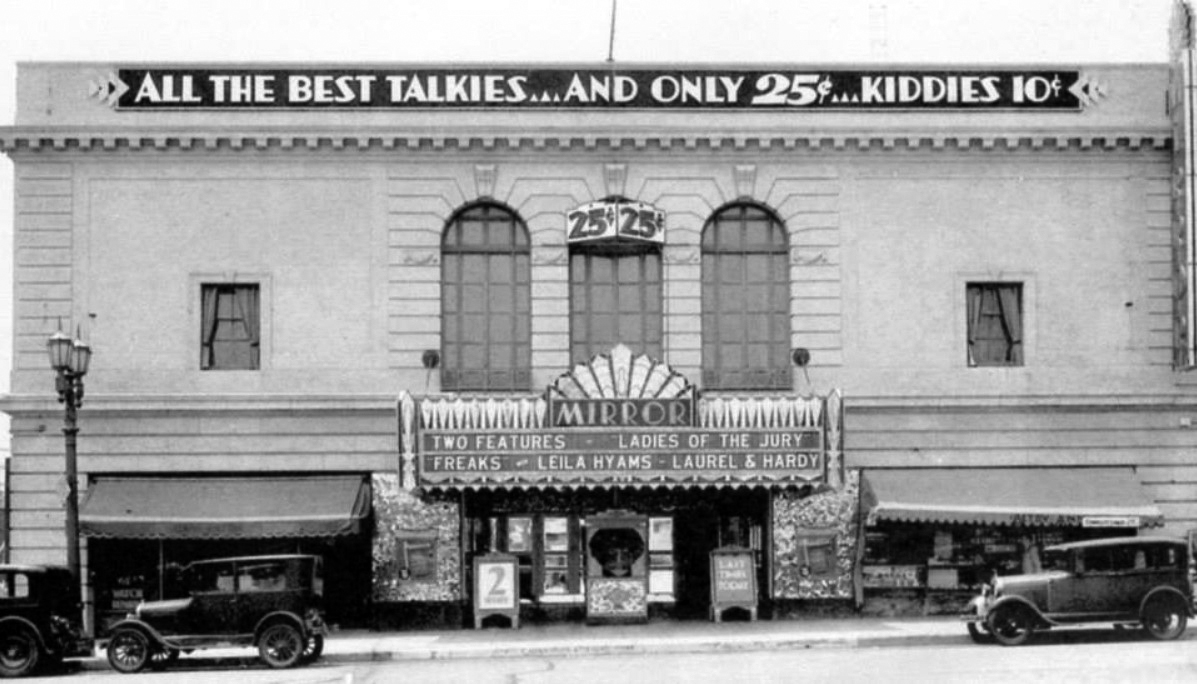 |
|
| (1932)#**# – Panoramic view showing the Mirror Theatre (previously Vine Street Theatre). Now showing: “Ladies of the Jury”, “Freaks” with Leila Hyams, and a Laurel & Hardy short. Large sign on top face of building reads: "ALL THE BEST TALKIES...AND ONLY 25 CENTS.....KIDDIES 10 CENTS" |
Historical Notes When the Vine Street Theater opened at 1615 Vine St, just south of the Hollywood and Vine corner, it was a legitimate live theater. In March, 1931 it became a cinema called the Mirror, under the direction of Howard Hughes' Hughes-Franklin circuit. #**# In 1936 the theatre became the Lux Radio Playhouse where the long-running “Lux Radio Theater” hosted by Cecil B. DeMille was made.*^ |
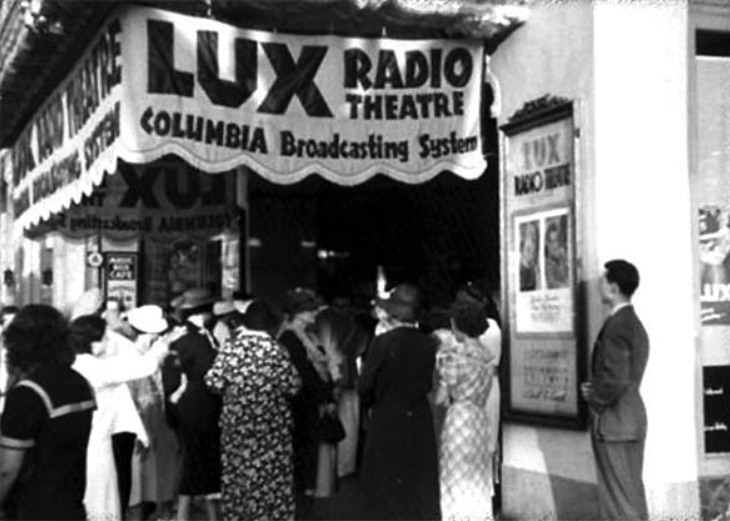 |
|
| (ca. 1930s)*^ - A studio audience gathers prior to a live production at Hollywood's Lux Radio Playhouse (previously the Vine St. Theatre and Mirror Cinema). |
Historical Notes Lux Radio Theatre was a long-run classic radio anthology series that was broadcast on the NBC Blue Network (1934-35); CBS Radio (1935-54), and NBC Radio (1954-55). Initially the series adapted Broadway plays during its first two seasons in New York before it began adapting films after moving to its Hollywood Vine Street location (1936). These hour-long radio programs were performed live before studio audiences. The series became the most popular dramatic anthology series on radio, broadcast for more than 20 years and continued on television as the Lux Video Theatre through most of the 1950s.*^ |
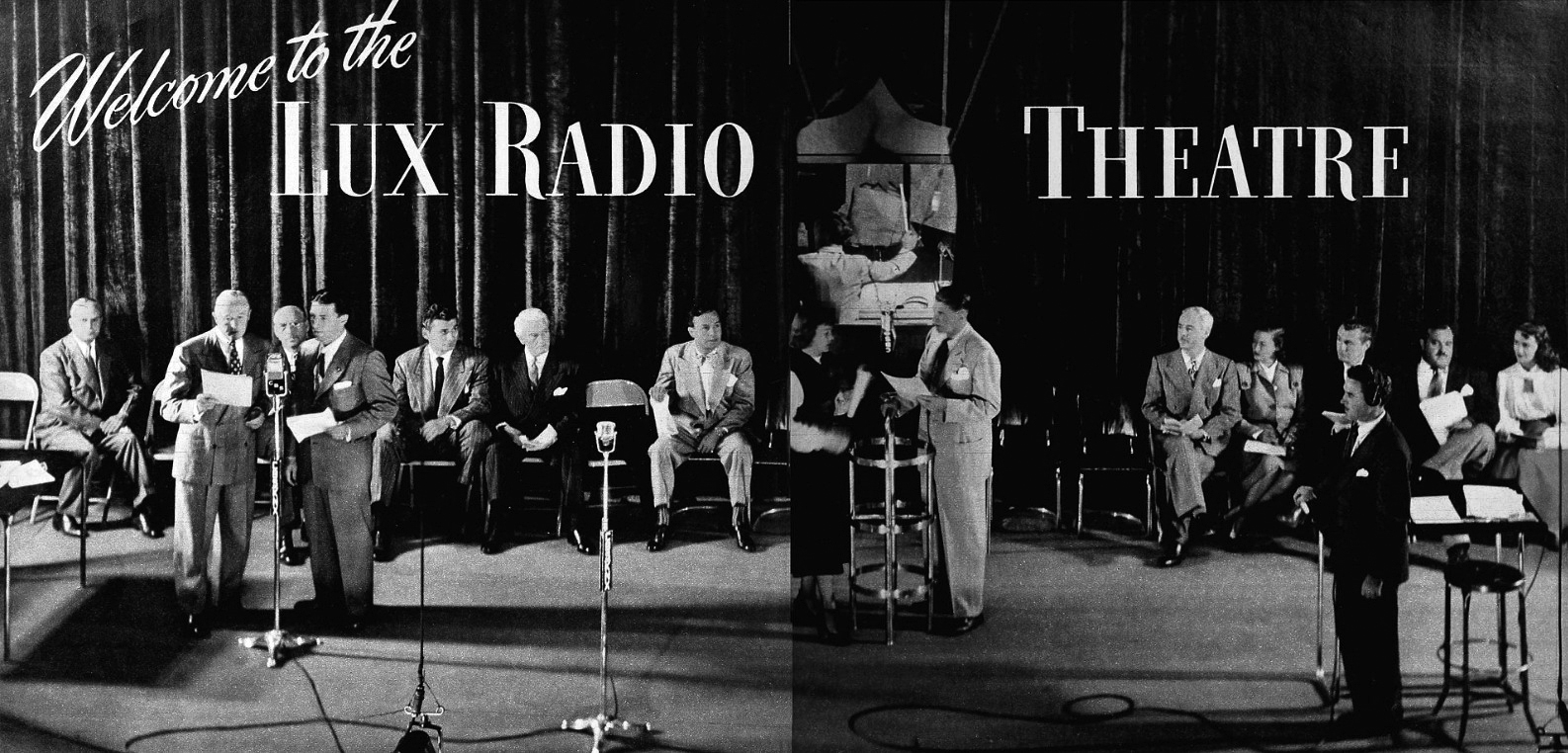 |
|
| (1948)*^ - Composite wide-angle view showing performance of Lux Radio Theatre before a studio audience. The actor standing at center-right is future U.S. President Ronald Reagan. |
Historical Notes Lux Radio Theatre strove to feature as many of the original stars of the original stage and film productions as possible, usually paying them $5,000 an appearance. In 1936, when sponsor Lever Brothers (who made Lux soap and detergent) moved the show from New York City to Hollywood, the program began to emphasize adaptations of films rather than plays. The first Lux film adaptation was The Legionnaire and the Lady, with Marlene Dietrich and Clark Gable, based on the film Morocco. That was followed by a Lux adaptation of The Thin Man, featuring the movie's stars, Myrna Loy and William Powell.*^ |
 |
|
| (1954)* - Opening night--celebrities and first nighters are shown arriving at the new million dollar theater, the Huntington Hartford Theater, for its premiere performance. Movie fans standing in bleachers cheer as screen stars enter the lobby of the theater. Photo dated: October 2, 1954. |
Historical Notes In 1954, George Huntington Hartford bought the building for $200,000 from Columbia Broadcasting and extensively remodeled and “modernized” the theater at an additional cost of $750,000. He streamlined the building from the facade, to the lobby and through the auditorium. Hartford ran the theater successfully for ten years.^^* |
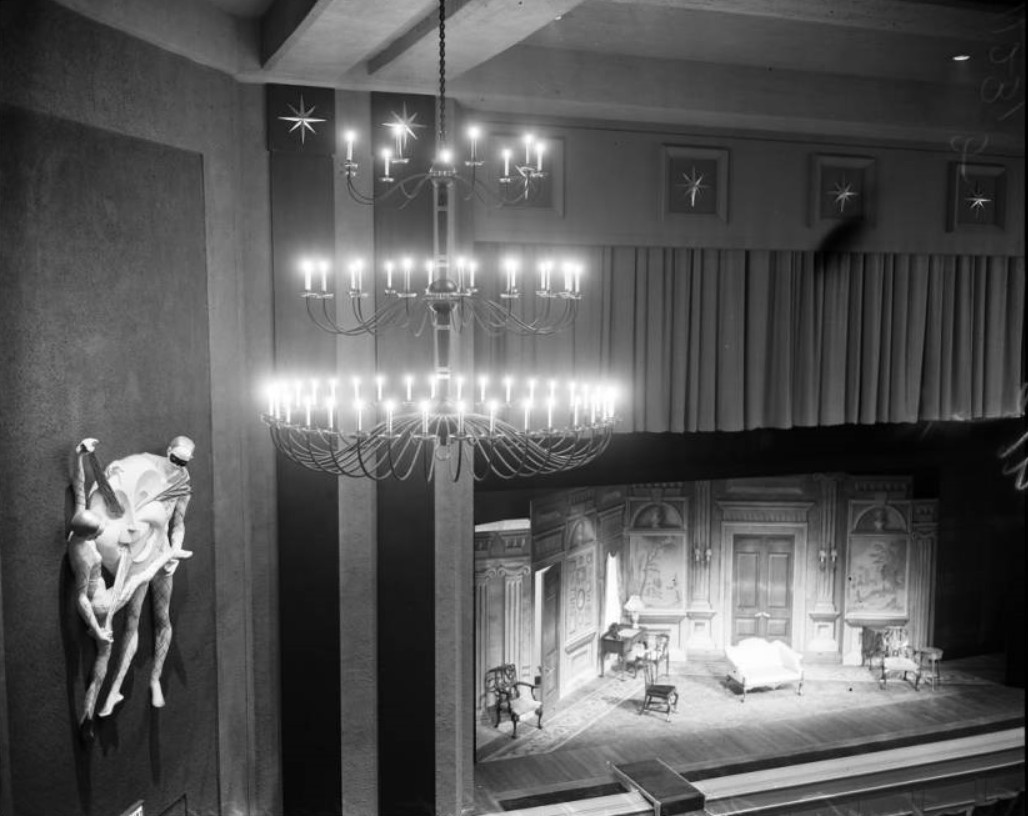 |
|
| (1954)^^ – Interior view of the Huntington Hartford Theater during the opening of "What Every Woman Knows" with Helen Hayes. |
Historical Notes In 1964 Hartford sold the theater to James Doolittle (owner of the Greek Theater in the Hollywood Hills) for $850,000. Cary Grant had tried to buy the building, but lost over Doolittle. The theater was (not surprisingly) renamed the Doolittle Theater. Eventually, the theater would run down into disrepair. Until bought in 2000 by the U.C.L.A. performing arts group “Nosotros”, an organization founded in 1970 by actor Ricardo Montalban “to help fulfill the goals of persons of Spanish-speaking origin in the motion picture and television industry”. The founding board included members Desi Arnaz, Vicki Carr and Anthony Quinn. In May 2004 the theatre reopened as The Montalbán. ^^* |
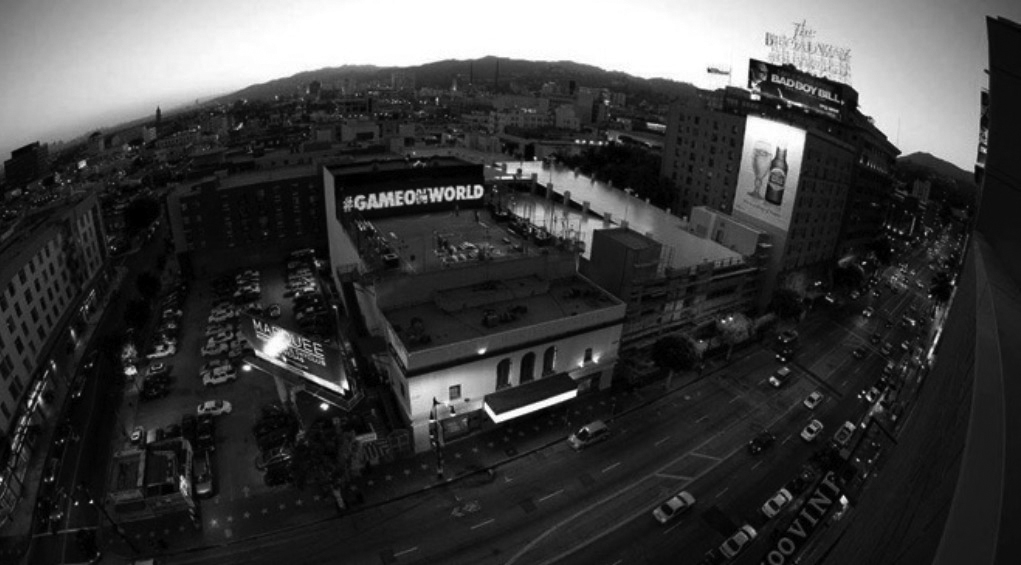 |
|
| (2010s)* - Bird's-eye view of the Montalbán Theatre located at 1615 N. Vine Street. The Broadway-Hollywood can be seen on the southwest corner of Hollywood and Vine. Photo courtesy of Ricardo Montalbán Theatre |
Historical Notes In 2005, Nike entered into a partnership with the Montalbán Theatre and the theatre has since been used for special venues such as promotional events. |
* * * * * |
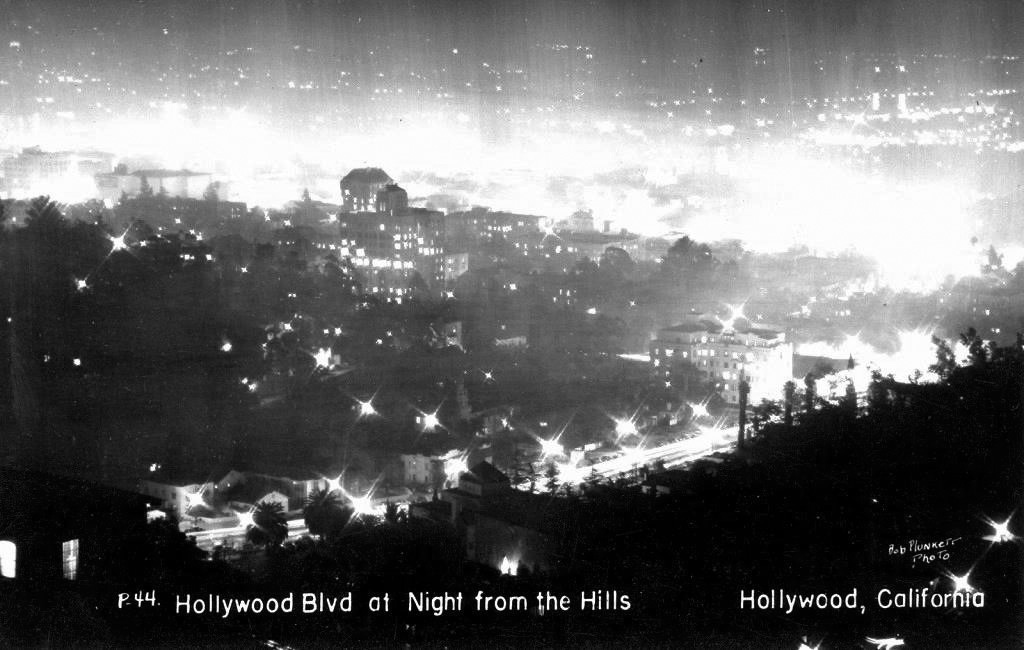 |
|
| (1930s)* – A shot taken from up in the Hollywood hills overlooking a nighttime Hollywood, its glowing lights illuminating the brightest and shiniest, while its shadows cloaks its secrets and shame. The American Legion Building (built in 1929), with its pyramid-shaped roof, can be seen in the foreground. |
* * * * * |
American Legion Building
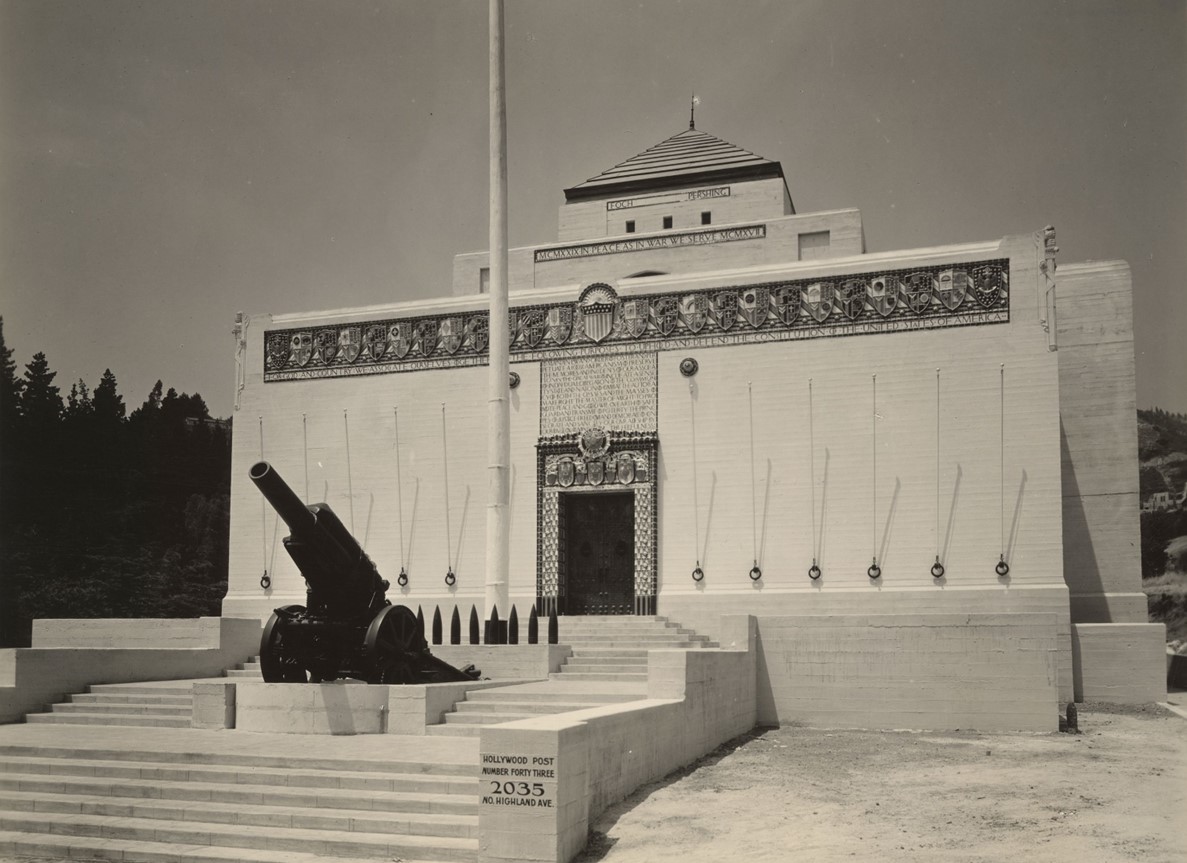 |
|
| (1929)* – View of the American Legion Building, Post No.43, located at 2035 North Highland Avenue in Hollywood. |
Historical Notes Hollywood Post 43 began in an old church building on El Centro Street near Hollywood Boulevard and grew to the largest in the State, having 1,285 registered members. It was organized in 1920. The American Legion is an organization of U.S. war veterans formed in Paris on March 15–17, 1919, by delegates from all units of the American Expeditionary Forces. Their main mission is to sponsor programs that improve veterans communities, such as scholarships, veterans help programs (i.e. ending veterans homelessness), and youth sports. They also promote national security, patriotism, and devotion to veterans. |
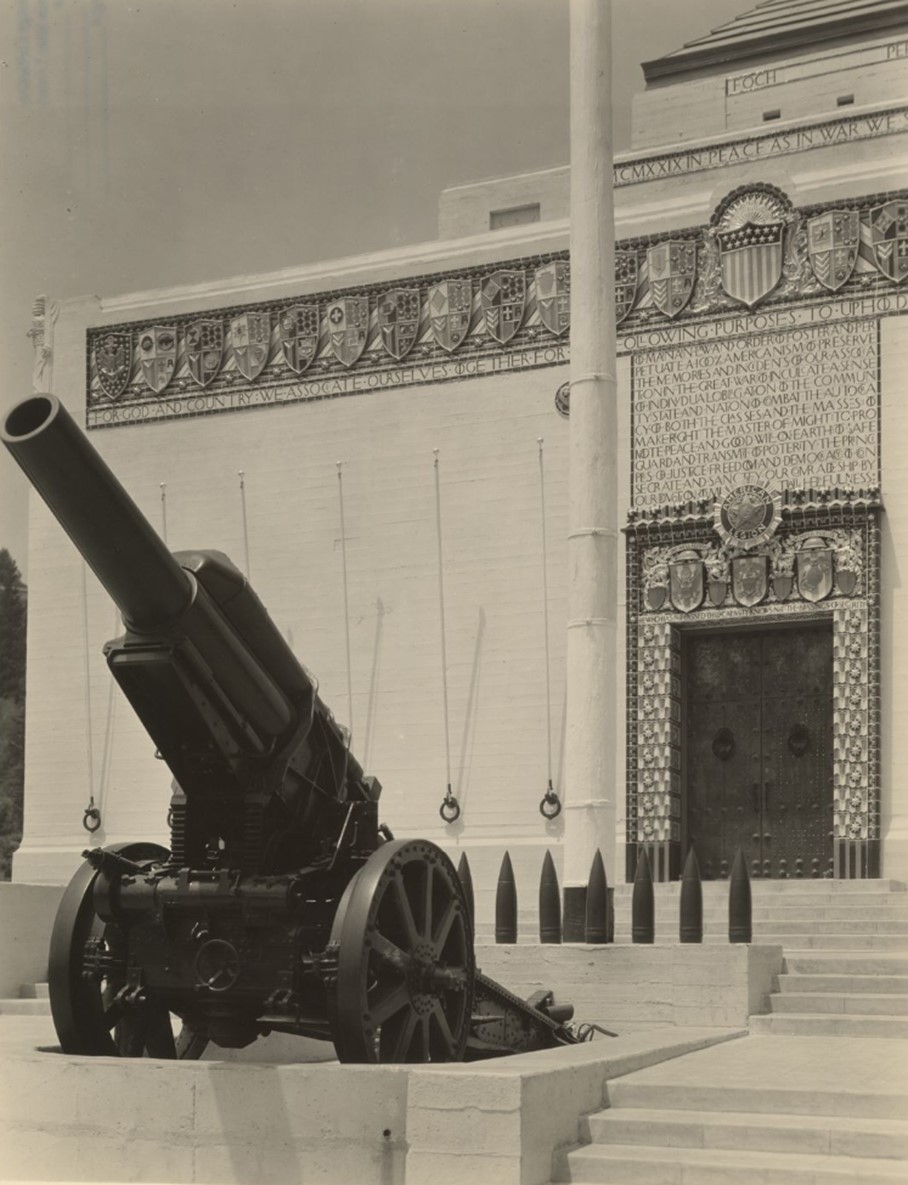 |
|
| (1929)* – Close-up view showing the artillery canon and decorative facade of the American Legion Building, Post No. 43. |
Historical Notes The Egytian Revival-Morroccan Deco building was designed by architects Gene and Joe Weston and completed in 1929 at a cost of $270,000. The three-story 33,000 square foot facility has an ornamental entrance of colored terra cotta, set in a solid concrete, with broad steps and terraces in the foreground and graceful tower and pyramid surmounting it. |
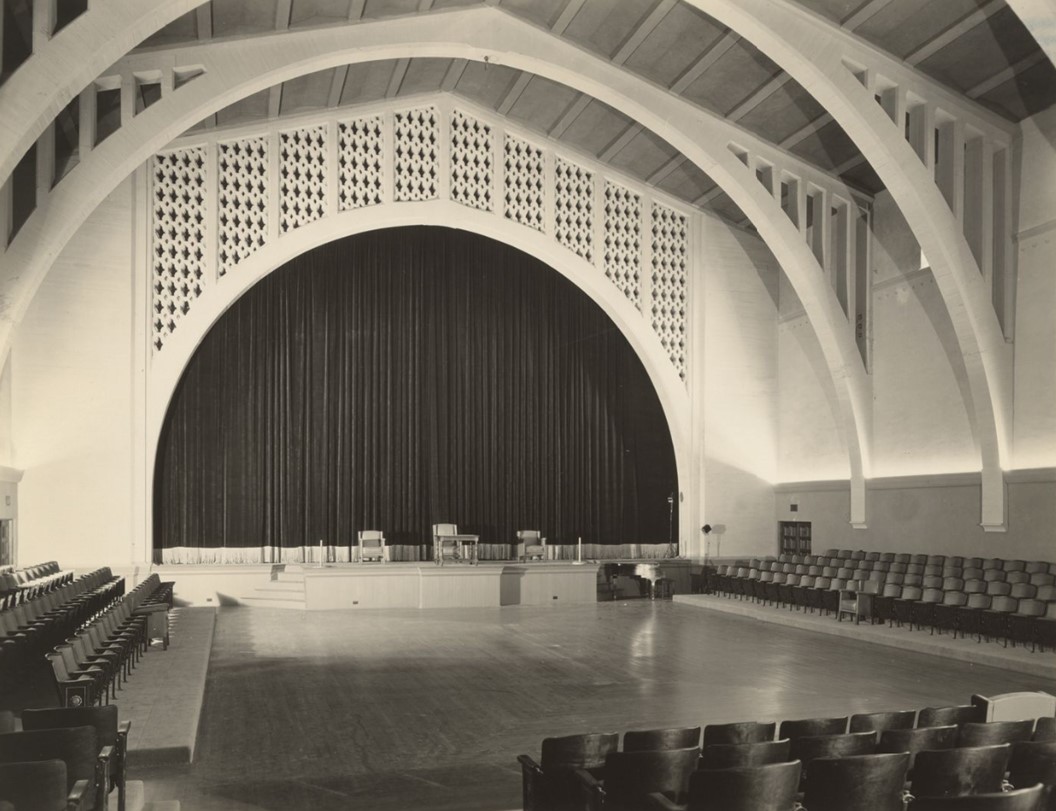 |
|
| (1929)* – Interior view showing the main auditorium. The Hall features large vaulted ceiling with curtained stage and open floorspace surrounded by tiered seats. |
Historical Notes Hollywood Post 43 began in an old church building on El Centro Street near Hollywood Boulevard and grew to the largest in the State, having 1,285 registered members. It was organized in 1920. The American Legion is an organization of U.S. war veterans formed in Paris on March 15–17, 1919, by delegates from all units of the American Expeditionary Forces. Their main mission is to sponsor programs that improve veterans communities, such as scholarships, veterans help programs (i.e. ending veterans homelessness), and youth sports. They also promote national security, patriotism, and devotion to veterans. |
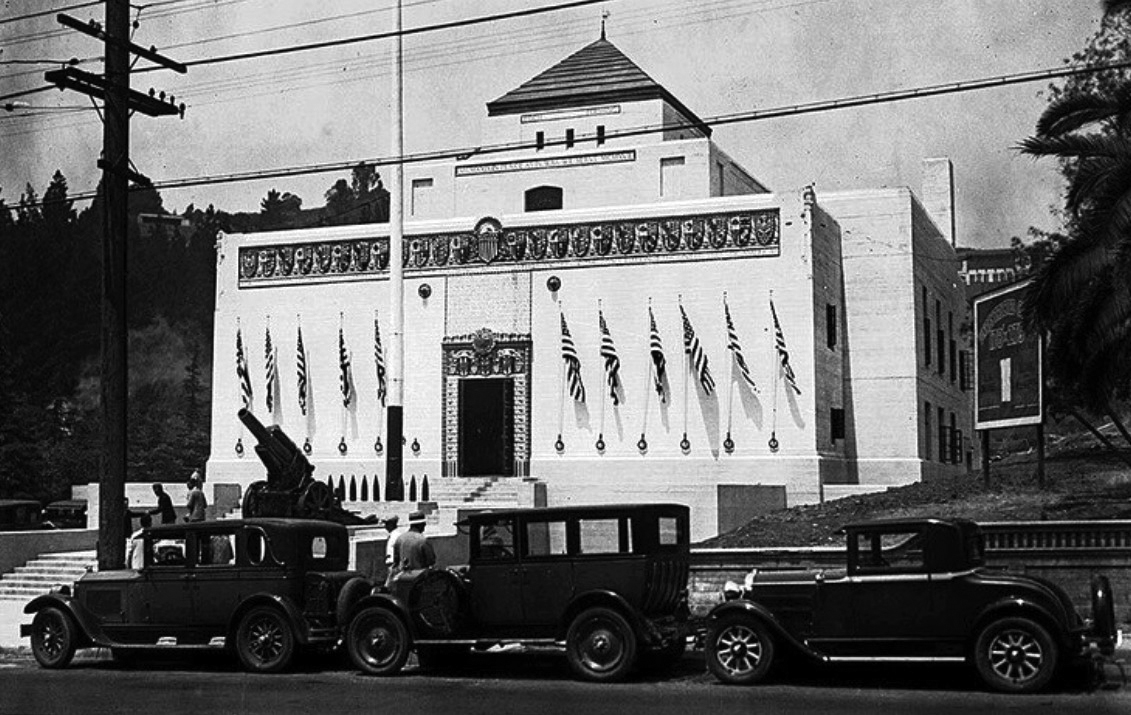 |
|
| (1929)* – Front view of the new American Legion Building located at 2035 N. Highland Avenue on the day of its dedication, July 4, 1929. |
Historical Notes Known as the "Post to the Stars," Post 43 has had notable members such as Clark Gable, Ronald Reagan, and Stan Lee. |
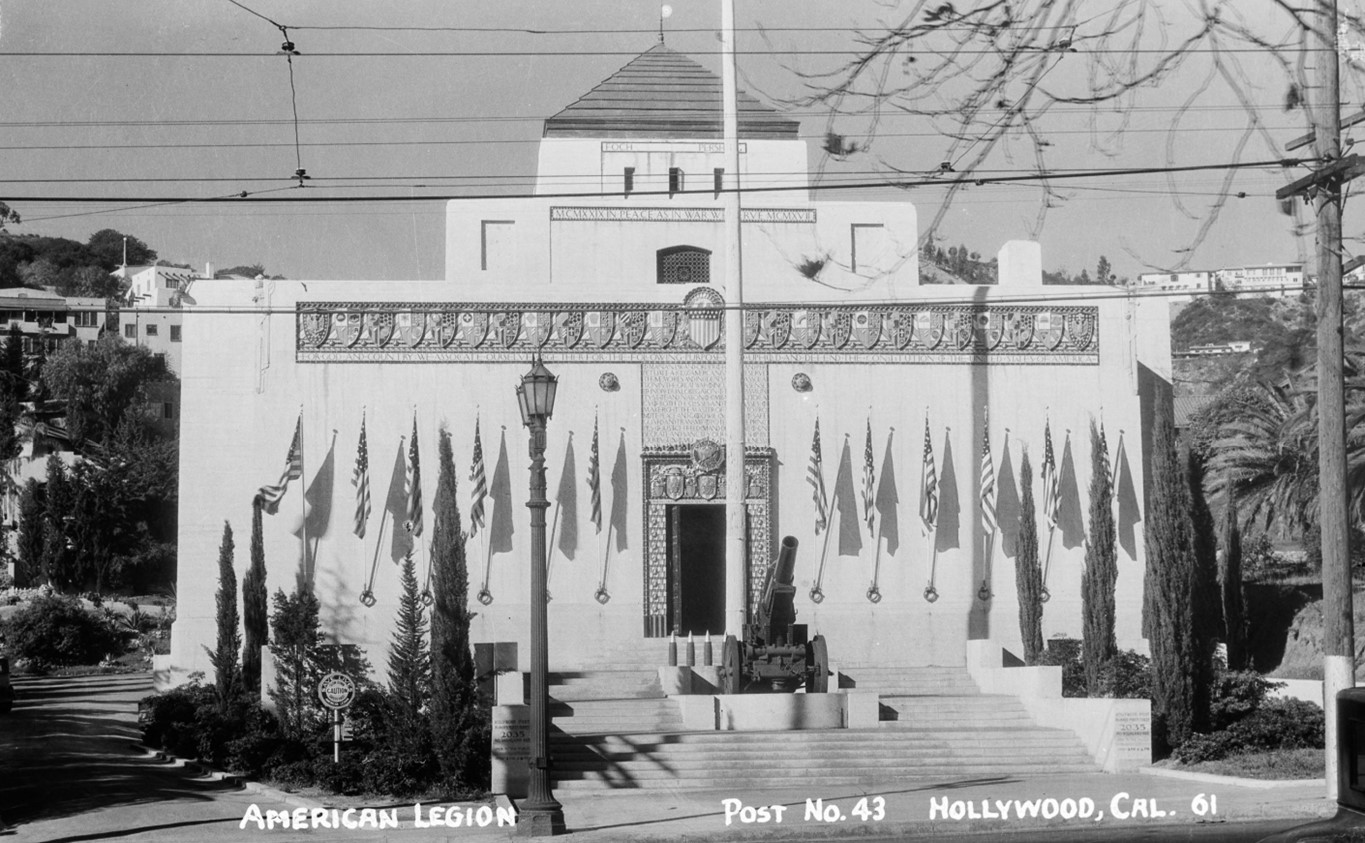 |
|
| (1930s)* - Postcard view of American Legion Post No. 43 in Hollywood. Photo by Bob Plunkett from the Ernest Marquez Collection. |
Historical Notes American Legion Post 43, located at 2035 North Highland Avenue in Hollywood, Los Angeles, was established in 1919 by World War I veterans from the film industry. This historic venue has played a significant role in Hollywood's culture for over a century, becoming a gathering place for veterans and community members alike. |
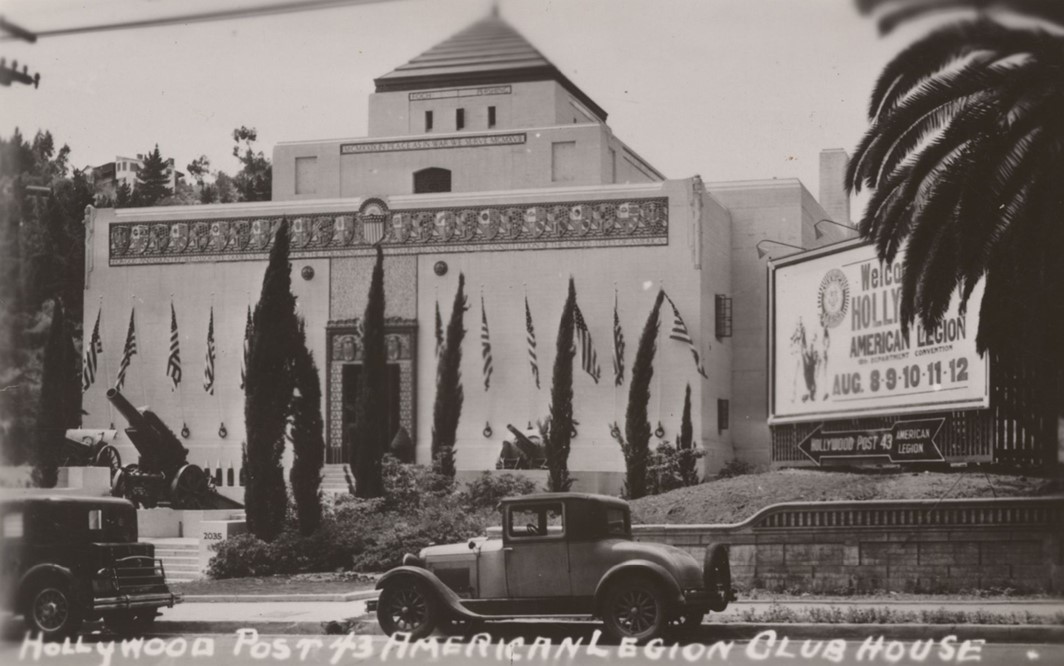 |
|
| (1930s)* - Postcard view of Hollywood Post No. 43 of the American Legiion on Highland Avenue. |
Historical Notes The post's clubhouse, built in 1929, is a striking example of "Morocco Egyptian Art Deco Revival" architecture and spans 30,000 square feet. Recognized as a Los Angeles Historic-Cultural Monument in 1989, it features various spaces including a state-of-the-art cinema, a banquet hall, and an Art Deco bar. |
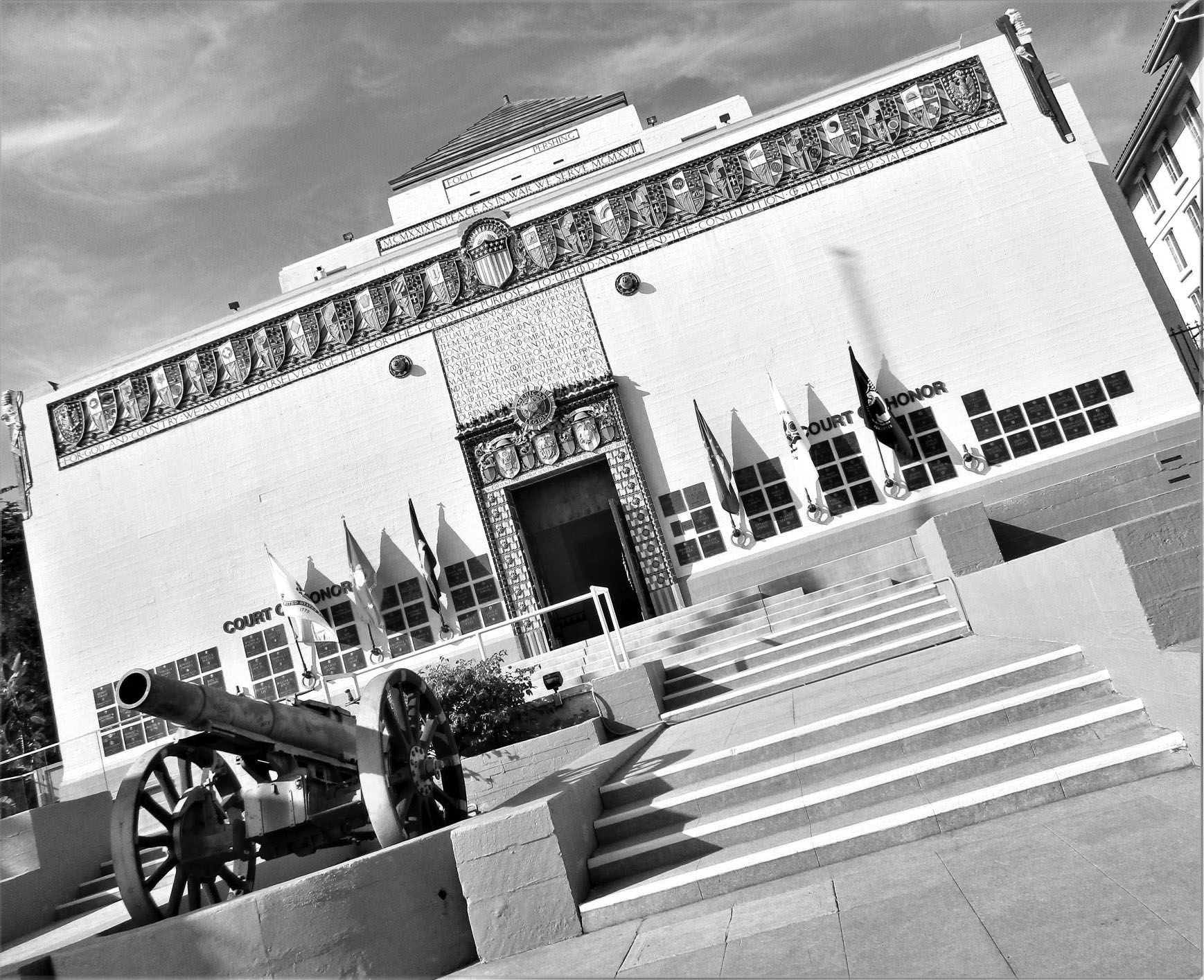 |
|
| (2018)* - View showing the American Legion Hollywood Post 43 as it appears today. Photo courtesy of Howard Gray. |
Historical Notes In 1989, the Hollywood American Legion Building was dedicated LA Historic-Cultural Monument No. 462 (Click HERE to see complete listing). Regular meetings are held on the first and third Mondays of each month, fostering camaraderie among veterans. The post serves as a community center while also attracting recent veterans from Iraq and Afghanistan, ensuring its continued relevance. |
Then and Now
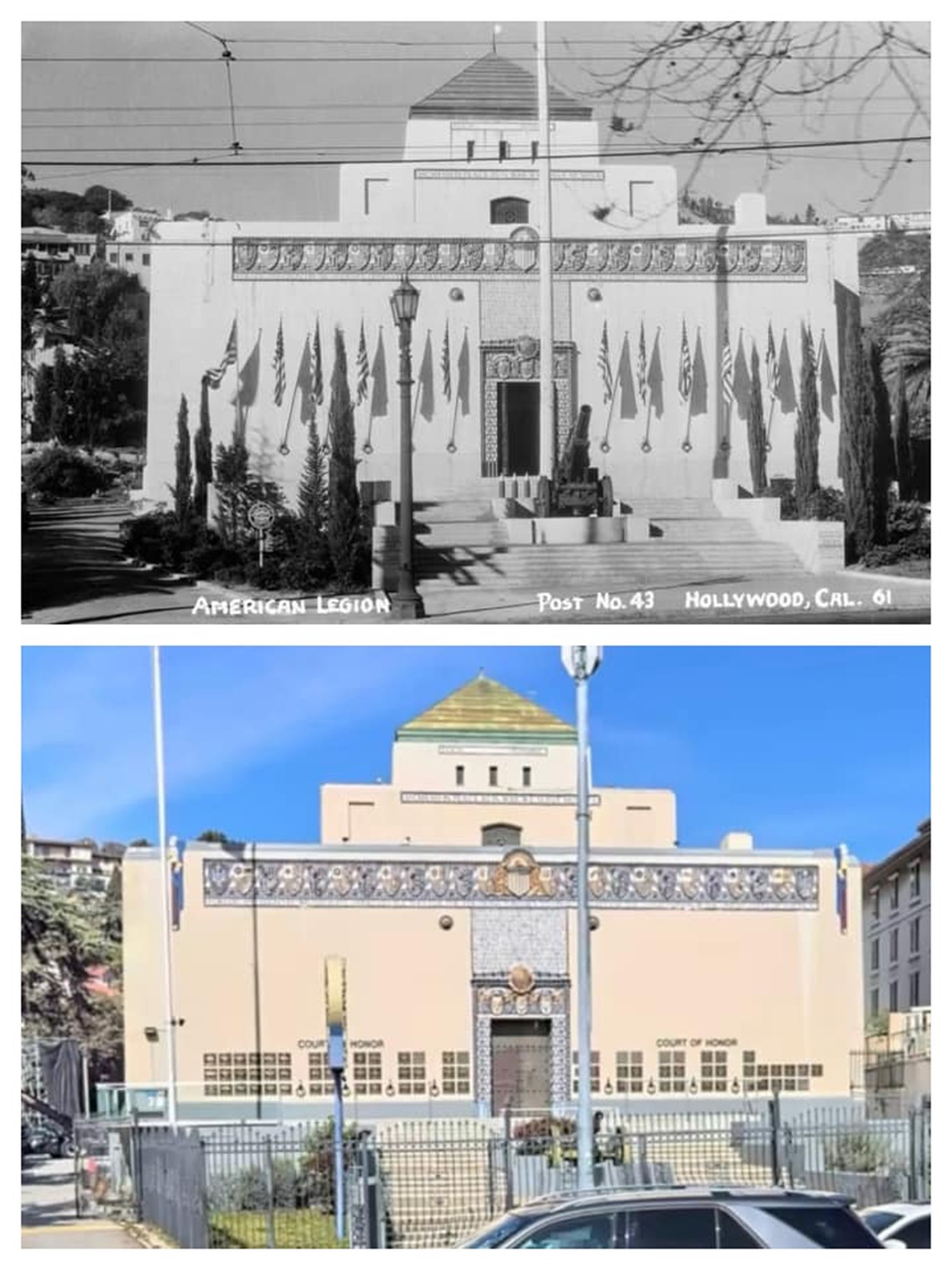 |
|
| (1930s vs. 2020s)* - A ‘Then and Now’ comparison showing the American Legion Building at 2035 N. Highland Avenue in Hollywood. Photo comparison by Trey Callaway. |
Historical Notes The American Legion Building at 2035 N. Highland Avenue in Hollywood is a striking example of Egyptian Revival architecture, completed in 1929 as a tribute to World War I veterans. Designed by the firm of Weston & Weston, the structure features bold columns, intricate friezes, and a commanding presence near the Hollywood Bowl. It remains a key landmark, serving as both a veterans' hall and an event venue. |
* * * * * |
Hollywood Ralphs
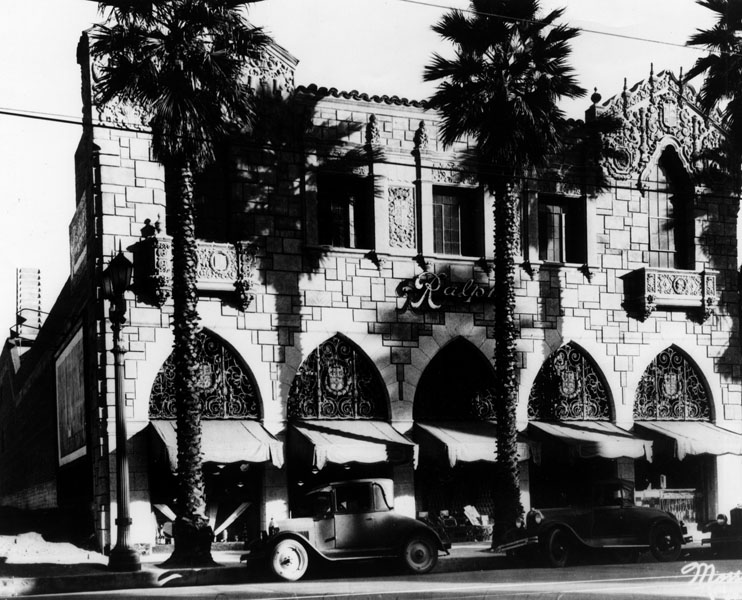 |
|
| (1929)* - Exterior view of a Ralphs Grocery Store located at 5711-17 Hollywood Boulevard, in Hollywood. The market, built in 1929, was designed by Morgan, Walls & Clements in a Gothic and churrigueresque revival design. |
Historical Notes Ralphs Grocery Company was founded in 1873 by George Albert Ralphs with the original store being located at Sixth and Spring Streets. The company employed notable architects in designing its stores. |
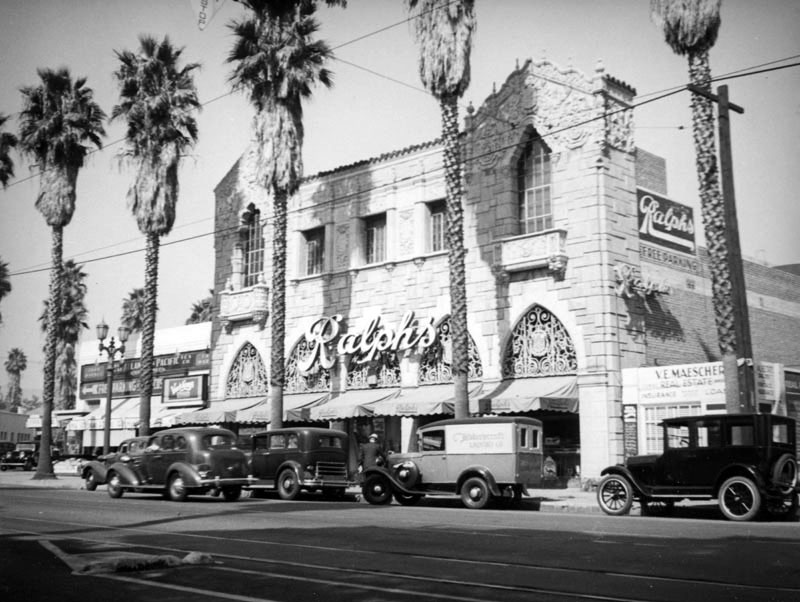 |
|
| (ca. 1937)* - View of the Ralphs Market on Hollywood Boulevard as it appeared circa 1937. Photo by Herman J. Schultheis. |
Historical Notes Click HERE to see an 1886 photo of George Ralphs standing in front of his original store in the Early LA Buildings (1800s) Section. |
* * * * * |
Hollywood Mandarin Market
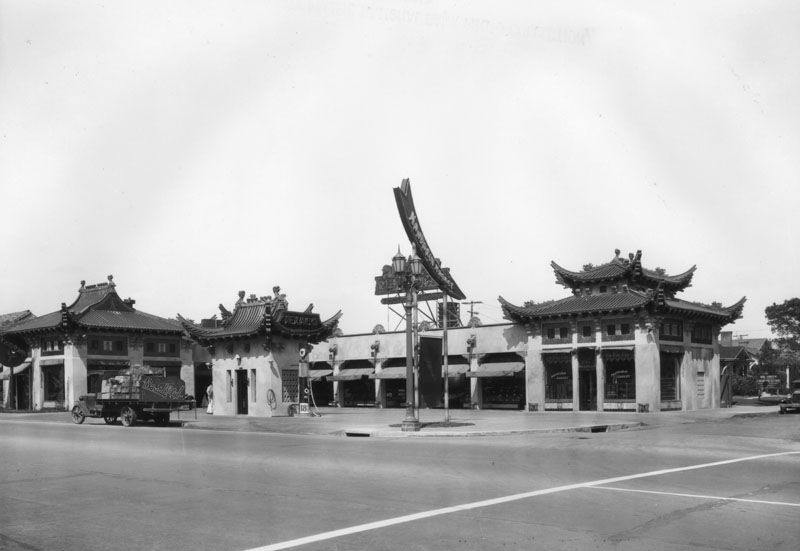 |
|
| (1929)* - Corner view of the Mandarin Market, a Chinese-style drive-in market located at 1234-1248 Vine Street, in Hollywood. A delivery truck full of crates of "Dorado Club," a brand of club soda, is parked on the street. |
Historical Notes Built in 1929, the Mandarin Market was touted as being one of the first drive-in markets of its kind in Los Angeles. The architect was Henry L. Gogerty, who later designed "gliding acoustical walls" for classrooms, and assembly line buildings for Howard Hughes' Spruce Goose project. Southern California was the principal center for the development of drive-in markets between the mid-1910s to the early 1940s. Other notable early drive-in markets included: Aurora Market (Glendale), Plaza Market (LA), and the Sunset Clock Market (Beverly Hills). |
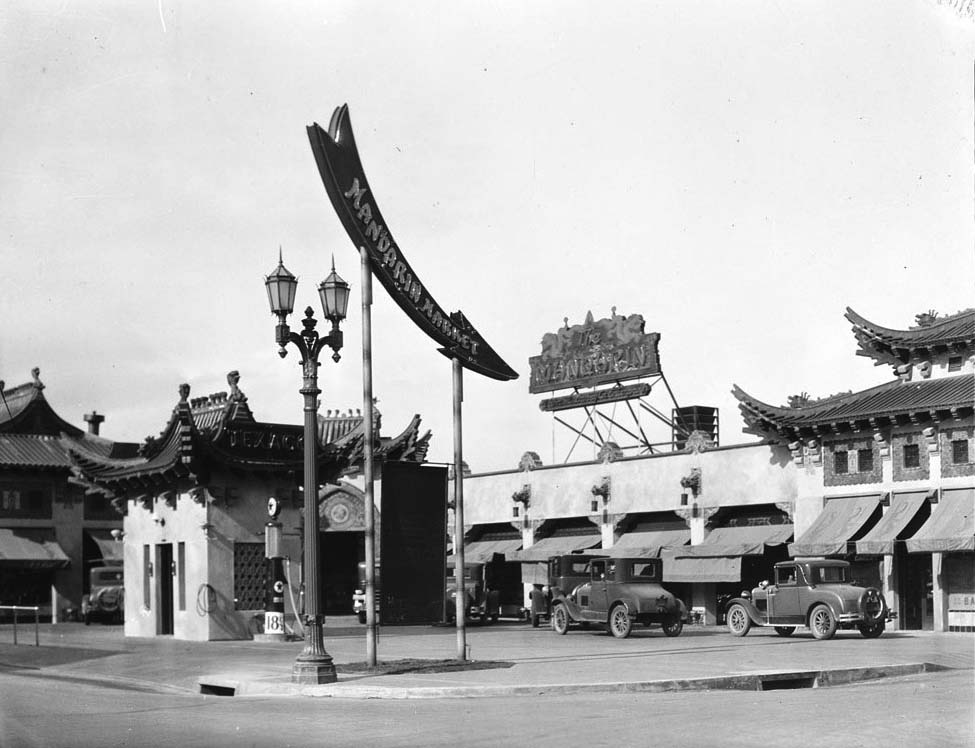 |
|
| (ca. 1929)^^ - Closer view of the Mandarin Market located on the northeast corner of La Mirada Avenue and Vine Street. The complex includes a Texaco service kiosk (center), a bakery (far right), a full meat and produce market, and a restaurant (left) known at this time as "Chinatown." Note the ornate two-lamp streetlight on the corner. |
Historical Notes In the late 1920s and 1930s, the two-lamp streetlight seen above was installed at various locations throughout the City, but nowhere more than in the Hollywood area. Click HERE to see more in Early Los Angeles Streetlights. |
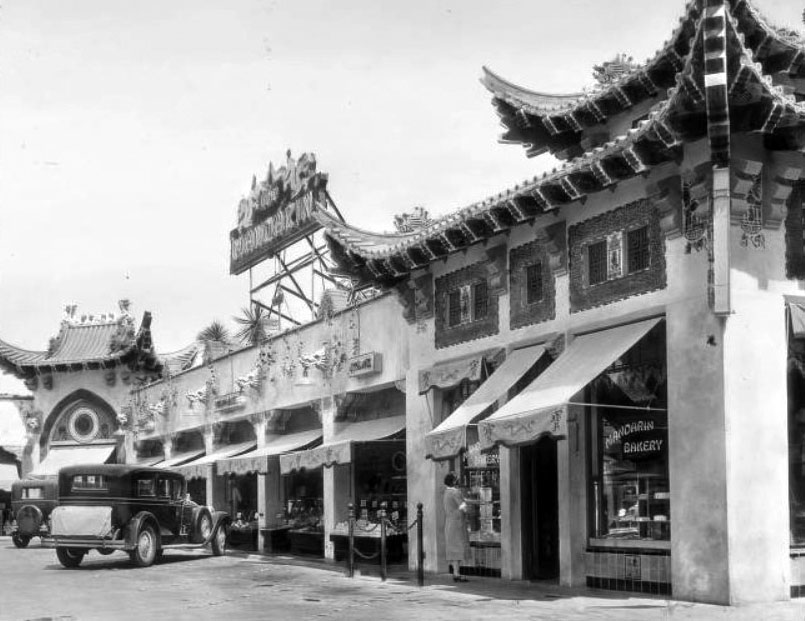 |
|
| (1931)^ – Postcard view of the Mandarin Market showing the details of its pagoda-style design. In the foregrond can be seen the Mandarin Bakery. |
Historical Notes Rather than have delivery trucks crowding the front of the marketplace, each store had a back entrance for deliveries.^*^# |
 |
|
| (1929)* - View of the Mandarin Market, a Chinese-style drive-in market located at 1234-1248 Vine Street, in Hollywood The meat and produce sections, identified by signs placed up high near the roof line, are labeled from left to right: Meats, Vegetables and Fruits. The market's "The Mandarin" sign mounted on the roof states that the market is a "Wm. M. Davey Co. Enterprise." |
Historical Notes The property sold in 1932 for $175,000 and, after some modifications, became Hollywood Ranch Market. |
Hollywood Ranch Market (Mandarin Market)
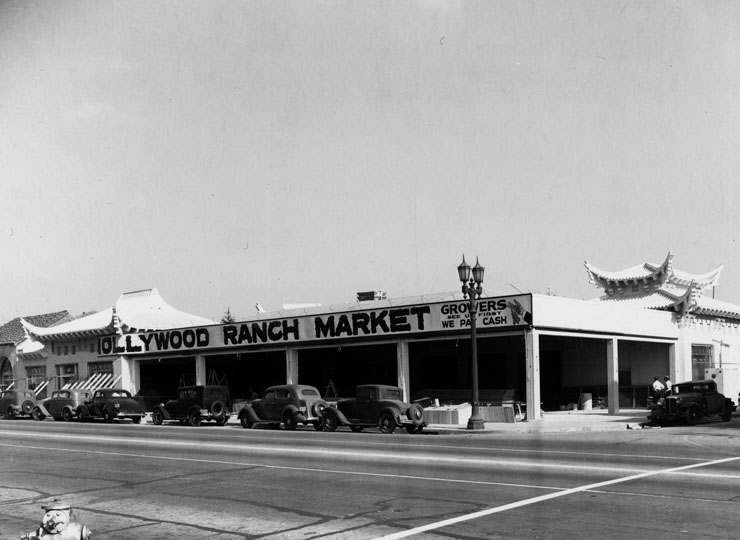 |
|
| (ca. 1932)* - Street view of the Hollywood Ranch Market (previously Mandarin Market). Note how the rooftop pagoda-style elements remain from the original structure. |
Historical Notes The Hollywood Ranch Market (Mandarin Market) took on a new look when the original outdoor area was enclosed. The Pagoda-style roofline remained intact around the periphery. |
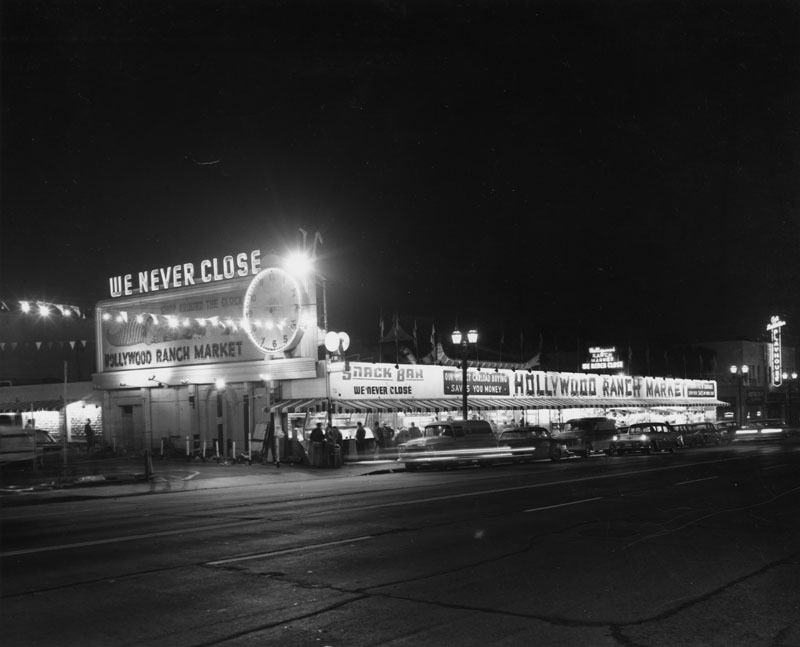 |
|
| (1961)* - Exterior view of the Hollywood Ranch Market, located at 1234-1248 Vine Street. The market with its large neon sign and the neighboring Art Linkletter Playhouse are clearly visible. Remnants of the original Chinese influenced architecture from when the building served as the Mandarin Market are visible above the roof line in the center of the photograph. |
Historical Notes It wasn’t unusual to see such personalities as Frank Sinatra, Ava Gardner or Red Skelton or at the Hollywood Ranch Market’s snack bar. Steve Allen used to broadcast his shows from his studio close by. ^#^^ Click HERE to see more Early Views of the Hollywood Ranch Market. |
* * * * * |
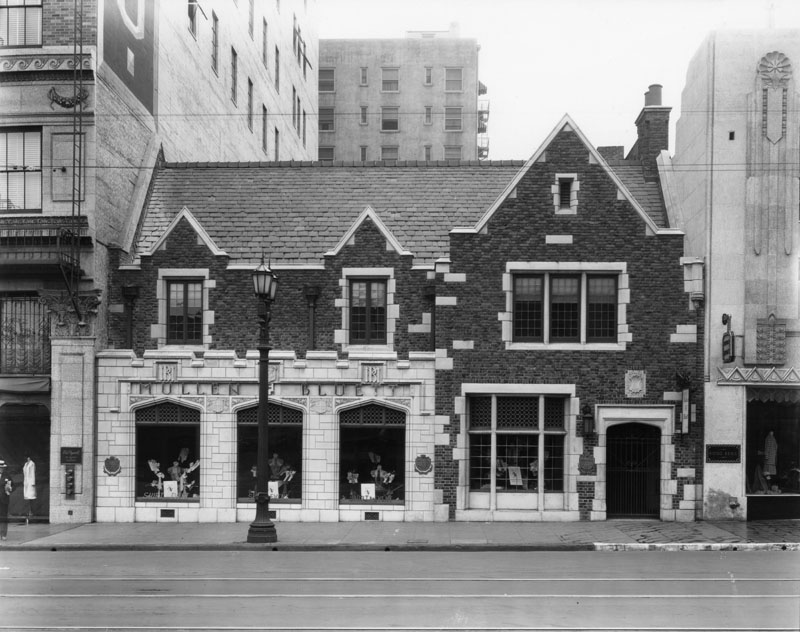 |
|
| (1929)* - Exterior view of Mullen and Bluett Clothing Company, located on Hollywood Boulevard and Vine. It is a two-story brick building with shingled roof showing three prominent peaks and numerous windows. A plaque for Roos Bros. is located on the building to the right, and a plaque for B. H. Dyas Co. is located on the building to the left. Note the street-railroad tracks in middle of the main road. |
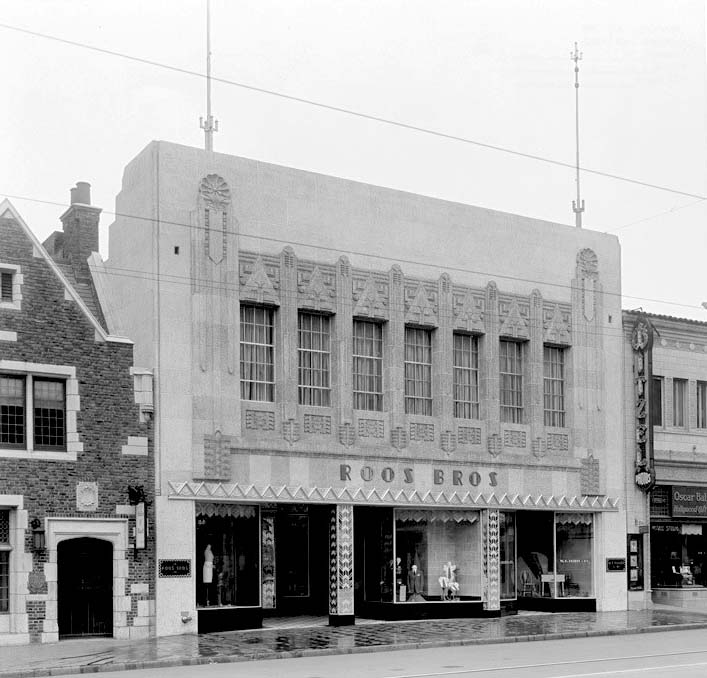 |
|
| (1920s)**## – View showing the upscale clothing store, Roos Brothers at 6320 Hollywood Boulevard near Vine Street. Note the Art Deco detailing applied to the façade of the building. The Mullen & Bluett Building is at left. |
Historical Notes In a later incarnation, the Roos Brothers building became the second Newberry five-and-dime located in Hollywood. Click HERE to see the first J.J. Newberry in Hollywood. |
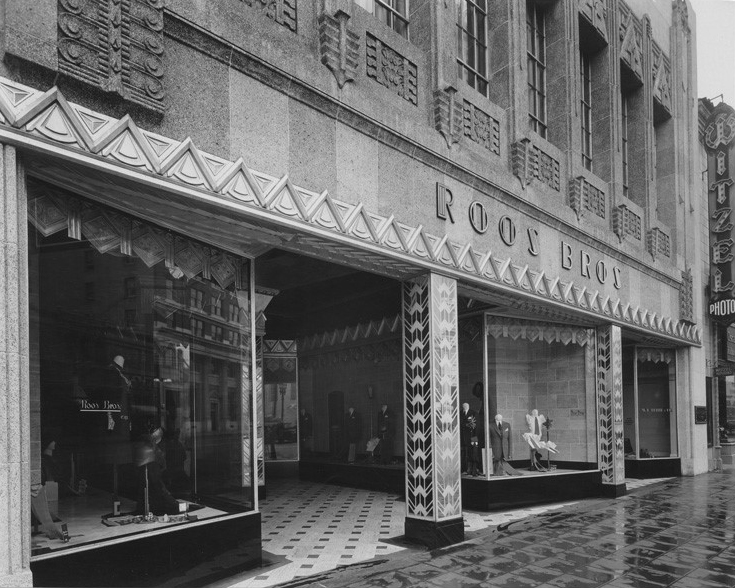 |
|
| (ca. 1930)^^^ - Close-up view showing the Roos Bros storefront entrance with its Art Deco zig-zag columns. |
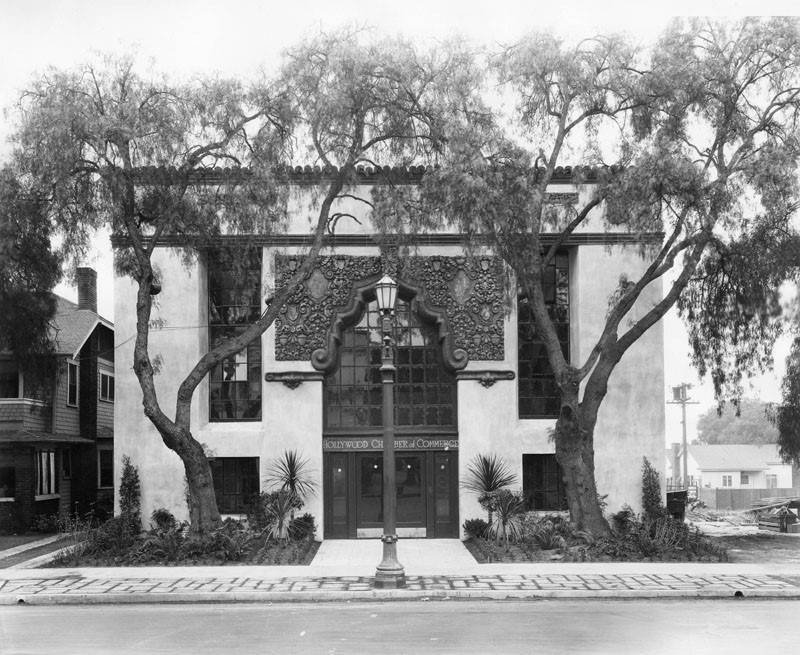 |
|
| (ca. 1929)* - Exterior view of Hollywood Chamber of Commerce at 6520 Sunset Boulevard. View shows the cast stone ornament over the main entrance and lower windows. Designed by Morgan, Walls & Clements, the building has a Spanish Colonial Churriqueresque design. Date built: 1925. |
Historical Notes The Hollywood Chamber of Commerce was formed in 1921 to replace the old Board of Trade. A five-day membership drive resulted in 2,517 members. The first order of business for the new organization was to raise funds for the grading and installation of 20,000 seats to create the Hollywood Bowl. In 1932, the Santa Claus Lane Parade was first sponsored by the Chamber. In 1978, the parade was given a new look, renamed the Hollywood Christmas Parade and grew to national prominence as the nation’s largest celebrity parade with national television distribution for the first time. In 1949, the Chamber entered into an agreement with the Department of Recreation and Parks to repair and rebuild the Hollywood Sign and to remove the “land” so that it would spell “Hollywood”. The cost was $4,000. A second restoration was done by the Chamber in 1973. #*^ |
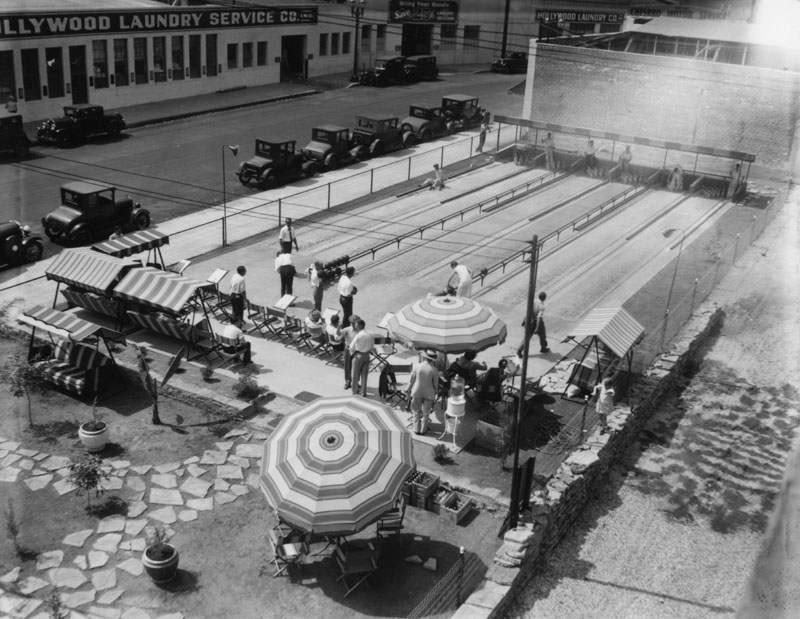 |
|
| (1929)* - View of the Out of Door Bowling Alley, located on Sunset Boulevard and Ivar Street. Several people are shown standing at the base of their lanes, taking aim with their bowling balls. Behind them, bowlers wait for their turn or just watch the progress of the game. The Hollywood Laundry Service Co., Inc., a very large laundry and dry cleaning building, can be seen across the way, which runs the length of the street. |
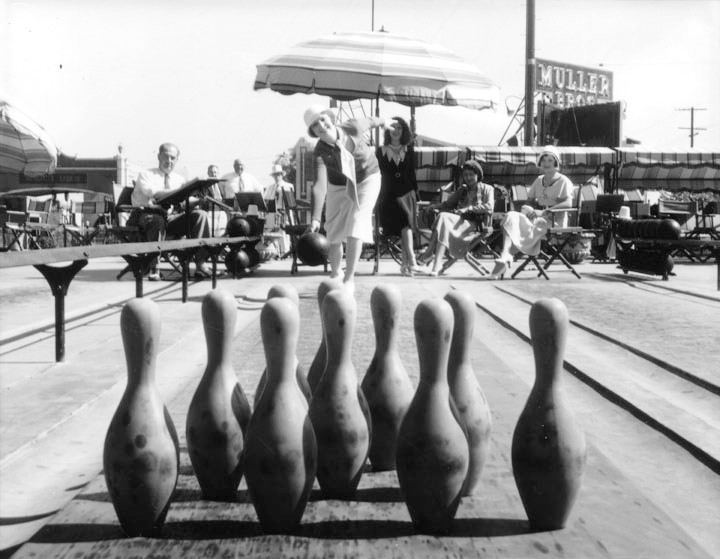 |
|
| (1929)* - Ten pins are neatly lined in the foreground as if anticipating their doom. A woman with a hat can be seen ready to release her bowling ball down the lane. |
Historical Notes The Muller Bros. Service Station can be seen in the background. It was located on Sunset Boulevard right where the Cinerama Dome stands today. |
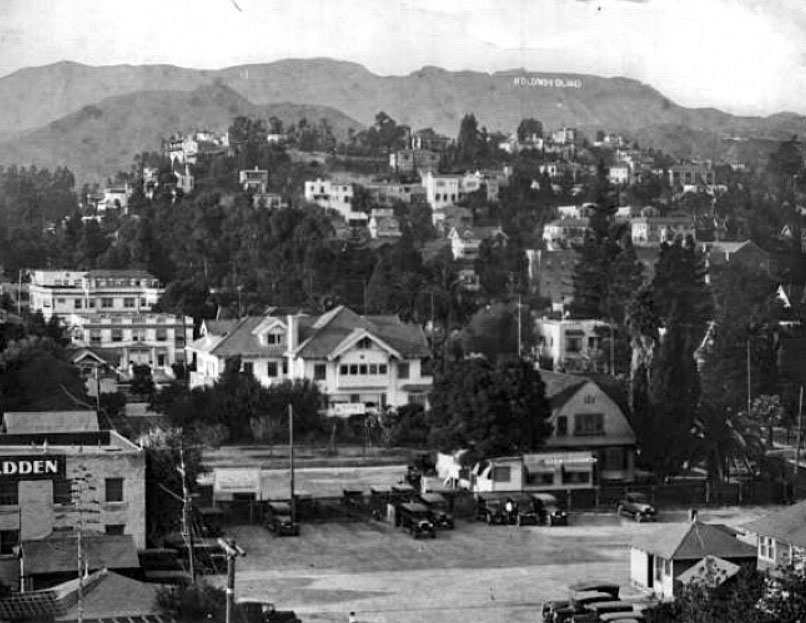 |
|
| (ca. 1928)#**# – View looking northeast at the Hollywood Hills and the ‘Hollywoodland Sign’ from McCadden Place south of Yucca Street. |
 |
|
| (ca. 1928)* - View looking north of the Hollywood Hills from the Hollywood Athletic Club on Sunset. The white structure in the upper right of the photo is the Mulholland Dam. |
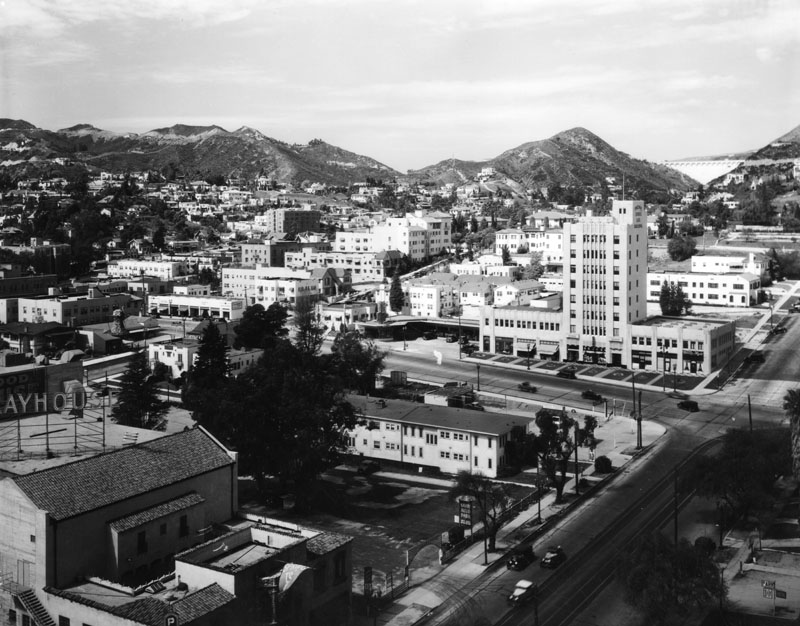 |
|
| (1929)* - Panoramic view of Hollywood and its surrounding areas. Partial view of the Hollywood Playhouse at 1735 N. Vine Street, is in the lower-left corner of this photo. The tall building at center-right, with several storefronts, is the Mountain States Building. The Mulholland Dam is in the far background (upper-right). |
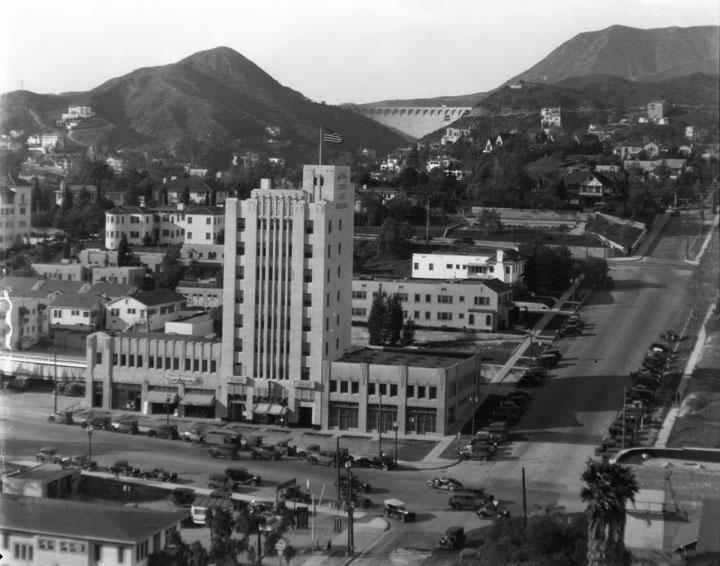 |
|
| (1928)* - Looking towards the Art Deco style Mountain States Building (now Yucca Vine Tower), located at 6305 Yucca Street. Architect: H. L. Gogerty, 1928. The building to the left is a Piggly Wiggly market and the Mulholland Dam is visible in the upper-center. |
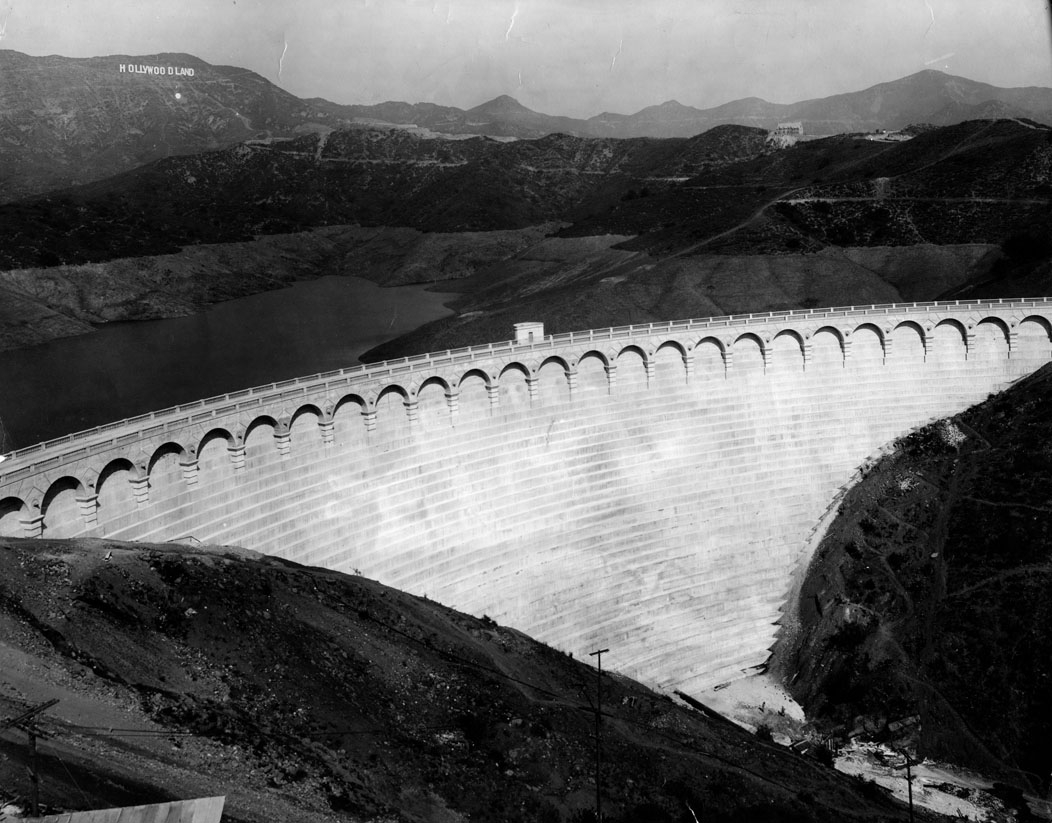 |
|
| (1929)* - Front view of Mulholland dam in the Hollywood Hills, the most beautiful of a score of storage basins in Los Angeles' water system. The HOLLYWOODLAND sign can clearly be seen in the background. |
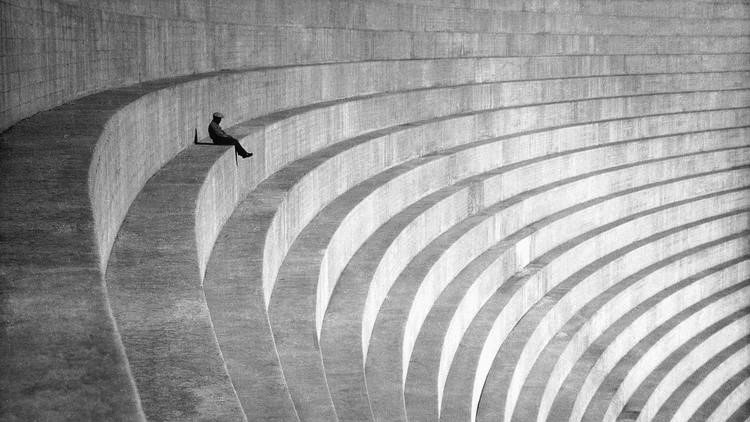 |
|
| (ca. 1930)^^# – Photo by Hiromu Kira titled “The Thinker," showing a man sitting on the vast, elegantly curved wall of the Mulholland Dam. |
Click HERE to see more in Early Views of the Mulholland Dam and Hollywood Reservoir |
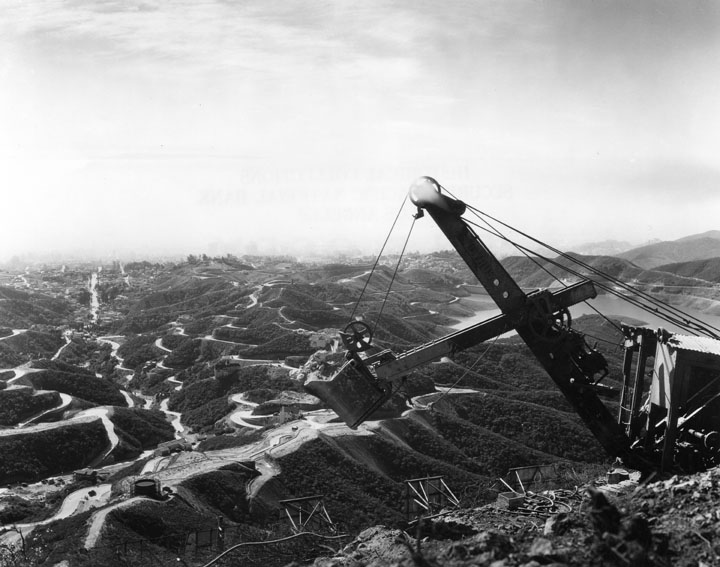 |
|
| (ca. 1929)* - An overview of the hills with a Mulholland Dam and Hollywood Reservoir off on the right, partially hidden by the steamshovel sitting at the top of the near hill. The back of the HOLLYWOODLAND sign and its supporting brackets can be seen in the bottom of the photo. |
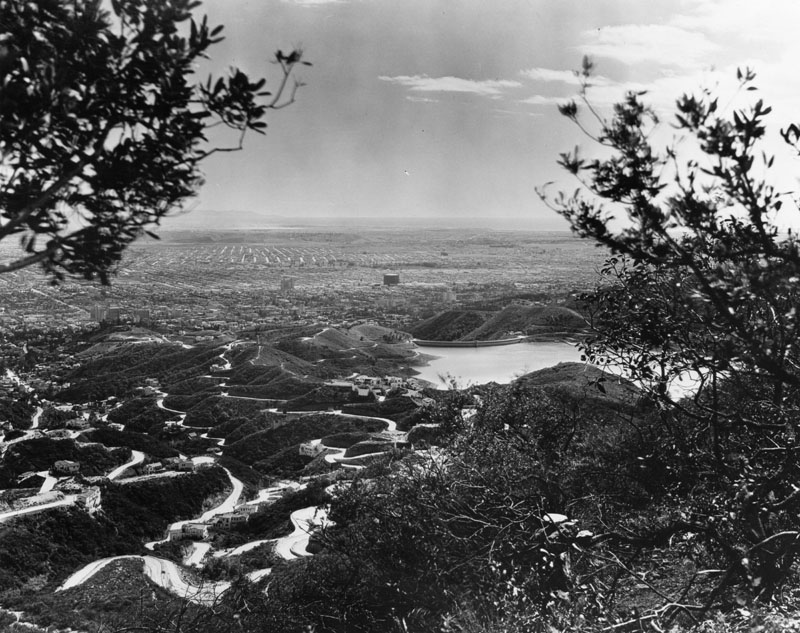 |
|
| (ca. 1929)* - Panoramic view of Hollywood and West Los Angeles, as seen from Mt. Lee. Lake Hollywood (Hollywood Reservoir) and “Hollywoodland” is in the foreground. |
Chateau Elysée
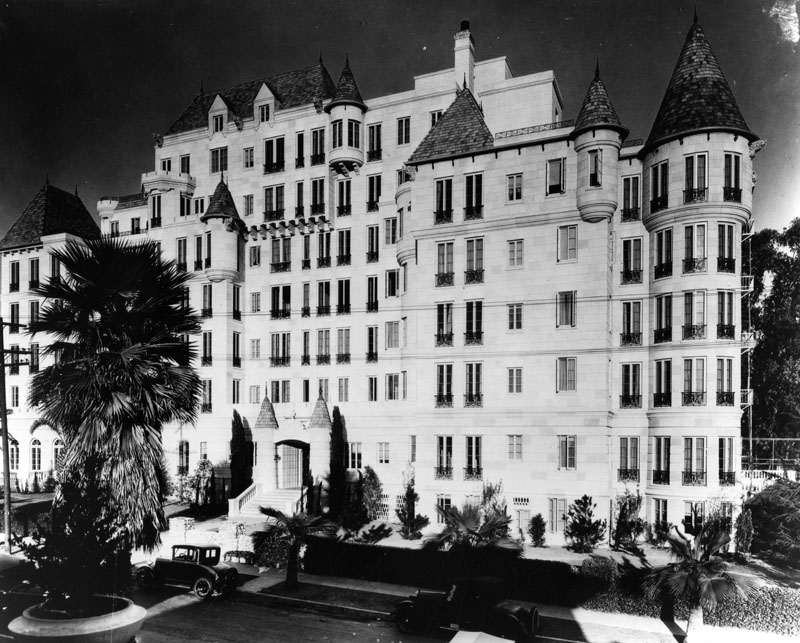 |
|
| (1929)* - Exterior view of the French style Chateau Elysée, located at 5930 Franklin Avenue in Hollywood. |
Historical Notes The Chateau Elysée was built as a luxury hotel/apartment house in 1929 by Eleanor Ince, the widow of Thomas H. Ince, the successful pioneer silent film producer. Designed by eminent architect Arthur E. Harvey as a prominent seven story replica of a 17th Century French-Normandy castle, the Chateau Elysée remains as the most impressive of several Hollywood chateaux built during the area's booming 1920s.*^ |
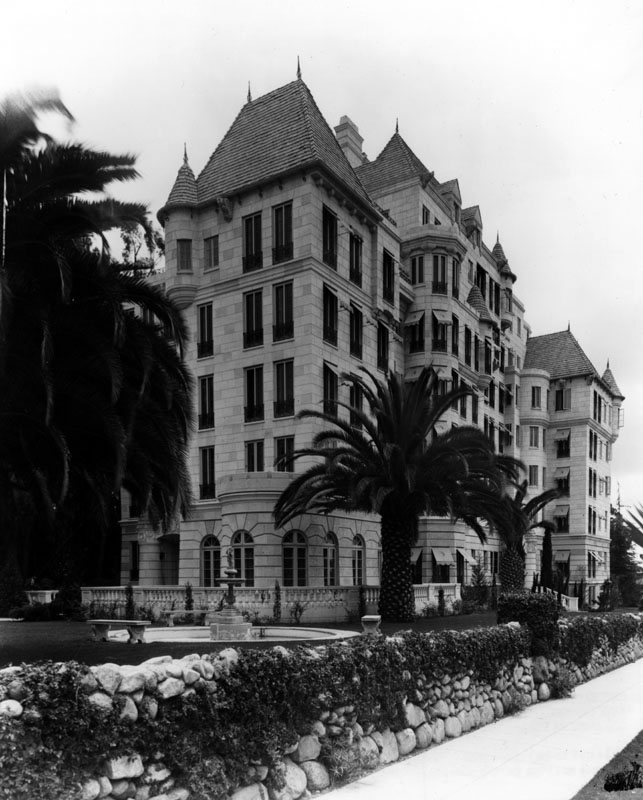 |
|
| (1929)* - Street view looking up toward the Chateau Elysée in Hollywood. |
Historical Notes The Chateau Elysée Hotel provided a home for many of the artists that were then being drawn to Hollywood. Residents included some of the most famous names of the 1930s and 40s. Most notably Bette Davis, Errol Flynn (room 211), Edward G. Robinson (room 216), Carol Lombard (room 305), Edgar Rice Burroughs (room 408), Humphrey Bogart (room 603), Clark Gable (room 604), Ginger Rogers (room 705), Ed Sullivan (room 501), Gracie Allen and George Burns (room 609) along with Lillian Gish, Katharine Hepburn, George Gershwin, and Cary Grant.*^ |
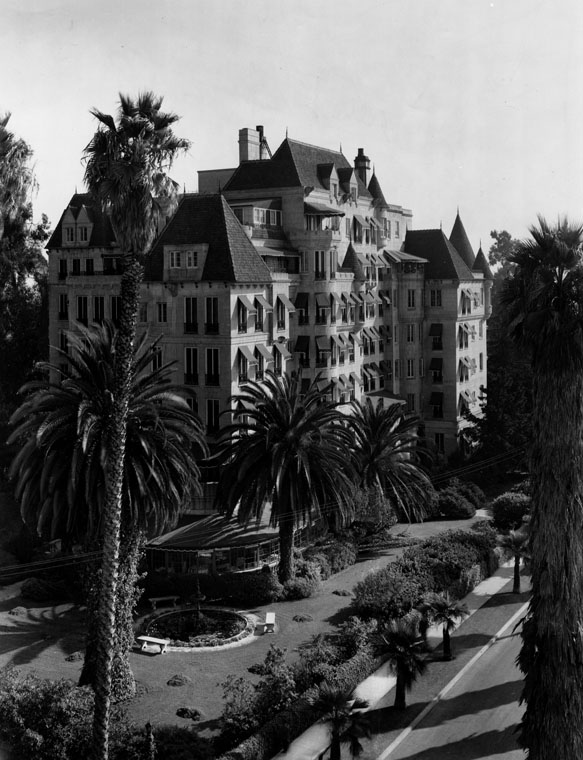 |
|
| (1951)* - Exterior view of the Chateau Elysée as it appeared in 1951. |
Historical Notes In 1969 the building began being used as the Church of Scientology's home for its Celebrity Centre; since 1973 the building has been owned by the Church. Several floors are now hotel rooms (for church members only), with the building's topmost stories serving as offices. Free guided tours of the historic building are available to the general public. The Château's conservatory building houses the acclaimed French rococo-styled restaurant, Renaissance.*^ On September 23, 1987, the City of Los Angeles declared the building as Historical National Monument No.329 (Click HERE to see complete listing). |
Villa Carlotta
 |
|
| (1926)*** – View showing the Villa Carlotta Apartment Building located on the northwest corner of Franklin and Tamarind avenues. |
Historical Notes The developer Luther T. Mayo built the 50-unit Spanish Colonial-style apartment house in 1926 from a design by architect Arthur E. Harvey, with rumored financing from William Randolph Hearst. Upon completion, it belonged to Eleanor Ince, widow of silent-film magnate Thomas Ince. According to legend, Hearst gave her the building as a gift after accidentally killing her husband on his yacht in 1924. The bullet, so the story goes, was intended for Charlie Chaplin, whom Hearst suspected was having an affair with his mistress, Marion Davies (Rosebud herself). Supposedly, Ince’s wife received the luxury residence hotel for her grief.** |
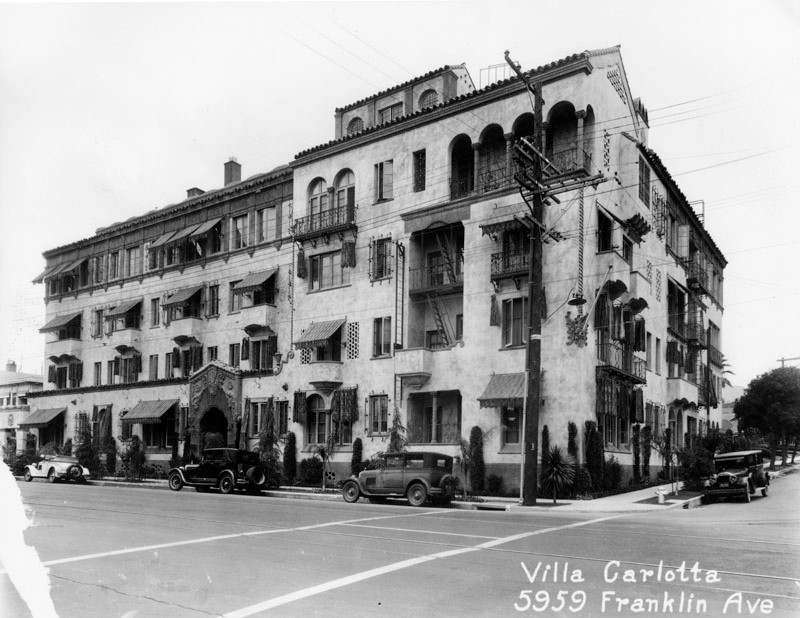 |
|
| (1929)* - Street view of the 4-story Spanish style Villa Carlotta apartment building, located at 5959 Franklin Ave. Pacific Electric streetcar tracks are visible on Franklin Avenue outside the building. |
Historical Notes Edward G. Robinson, George Cukor, and Marion Davies were among its early celebrity tenants. Louella Parsons, the most famous gossip writer of the era, penned her column from a two-story apartment on the courtyard. A personal favorite of Hearst’s, Parsons was on the yacht the night of Thomas’s alleged shooting, and is said to have received The Carlotta’s finest apartment for her silence.** |
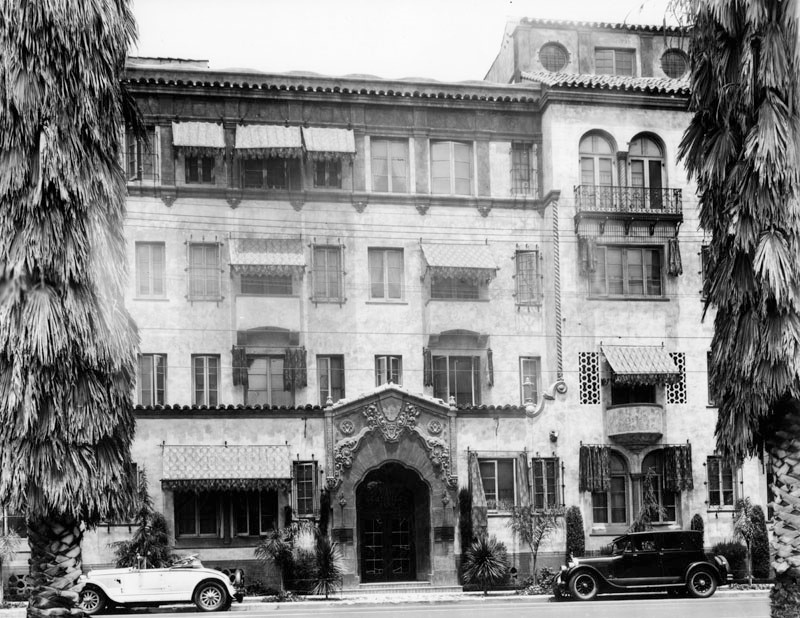 |
|
| (1929)* - Front view showing the main entrance of the 4-story Spanish style Villa Carlotta apartment building as seen from acroos the street. |
Historical Notes The four-story building was designed by Arthur E. Harvey, who also designed the nearby Chateau Elysée located across the street. |
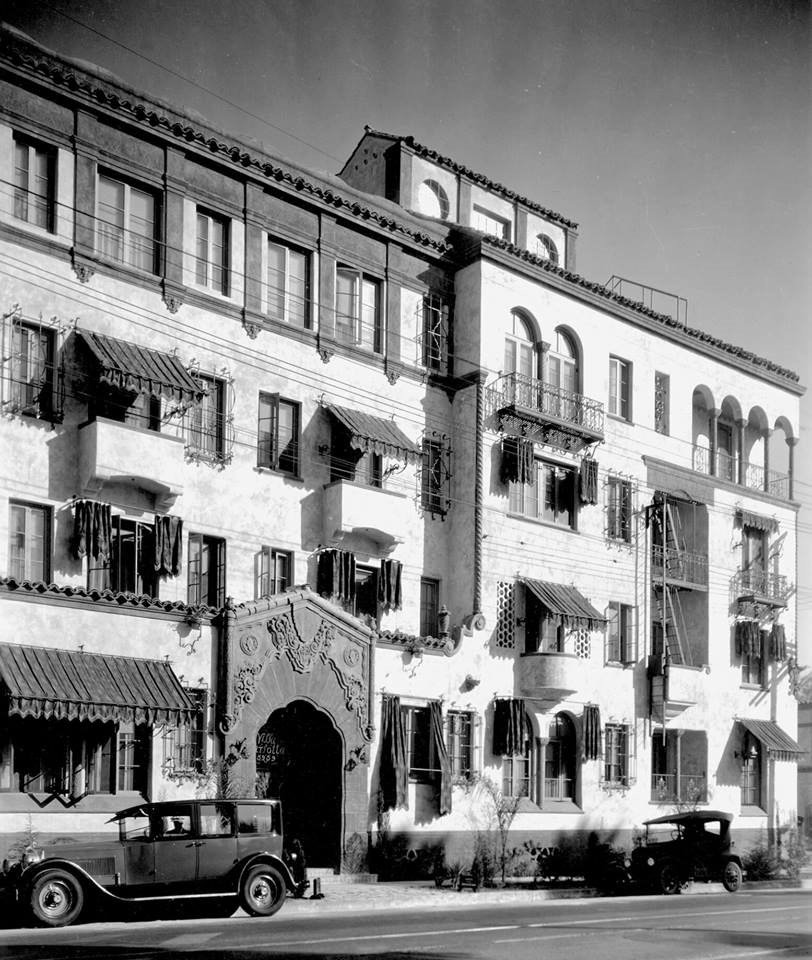 |
|
| (ca. 1929)#**# – Closer view of the Villa Carlotta apartment building at 5959 Franklin Avenue in Hollywood. |
Historical Notes The building is a Churrigueresque wonder of late Spanish baroque and filled with detailing they just don’t do anymore. |
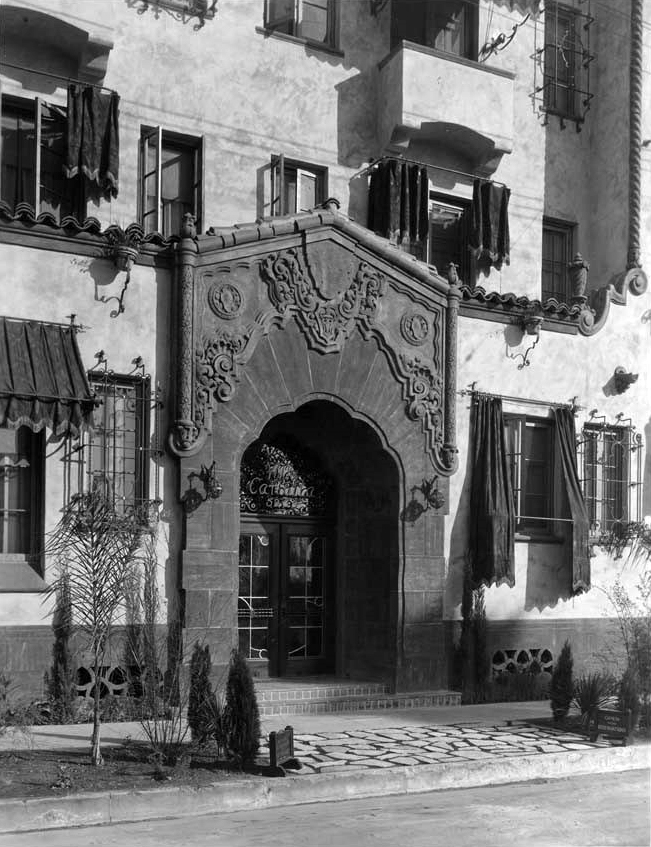 |
|
| (ca. 1928)*** – Close-up view showing the entrance to the Villa Carlotta apartment building. Note the Baroque Churrigueresque design. |
 |
|
| (2015)** – Night view of the illuminated front entrance to the Villa Carlotta, 5959 Franklin Ave. Photo by Stinson Carter / Vanity Fair. |
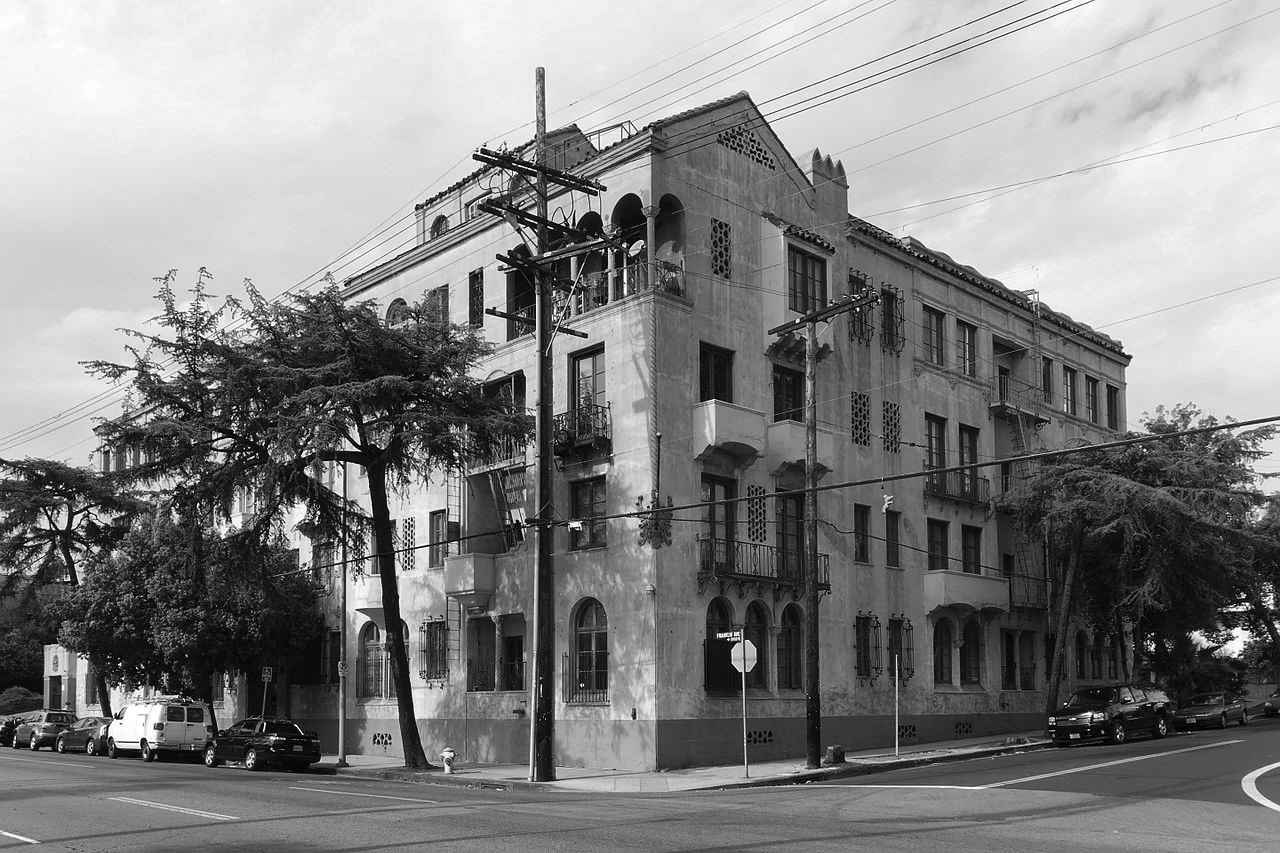 |
|
| (2015)*^ - The Villa Carlotta apartments, Los Angeles Historic-Cultural Monument 315, viewed from the southeast. |
Historical Notes The Lesser family trust owned the building from the 1950s to 2014, when it was bought by investment firm CGI Strategies. The new owner is restoring and renovating the historic building with a focus on preserving its architectural heritage, including keeping and refreshing the features and fixtures that made it a special place for so many residents and visitors.*^ |
Castle-Argyle Arms Apartments
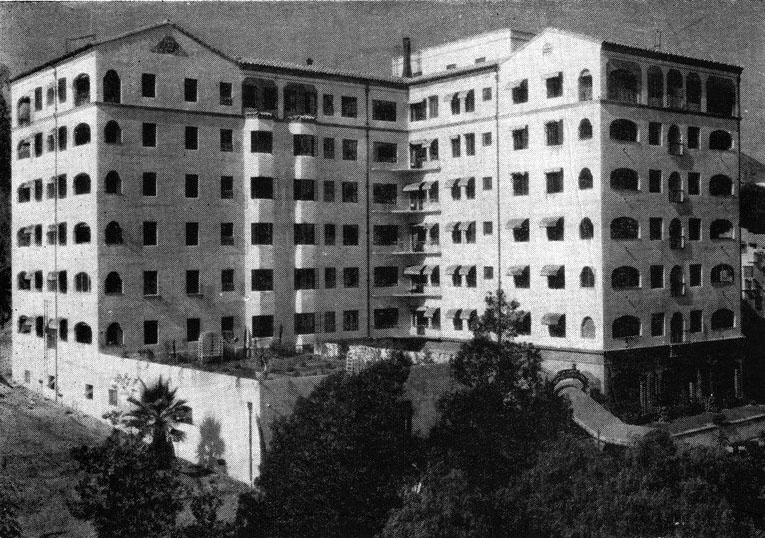 |
|
| (ca. 1930s)^^^ – Caption reads: Castle-Argyle Arms, "The finest address in Hollywood", located on the NW corner of Franklin and Argyle. |
Historical Notes In 1928, Dr. A. G. Castles tore down his large castle-like home on the northwest corner of Franklin and Argyle (called Castle Sans Souci) and built the Castle Argyle Arms Apartments. Over the next two decades it would attract major movie makers including: Clark Gable, Howard Hughes, Ronald Reagan and Cecil B. DeMille. Castles died five years after construction of the seven-story luxury apartments that still stands, proudly bearing the builder's name.^ |
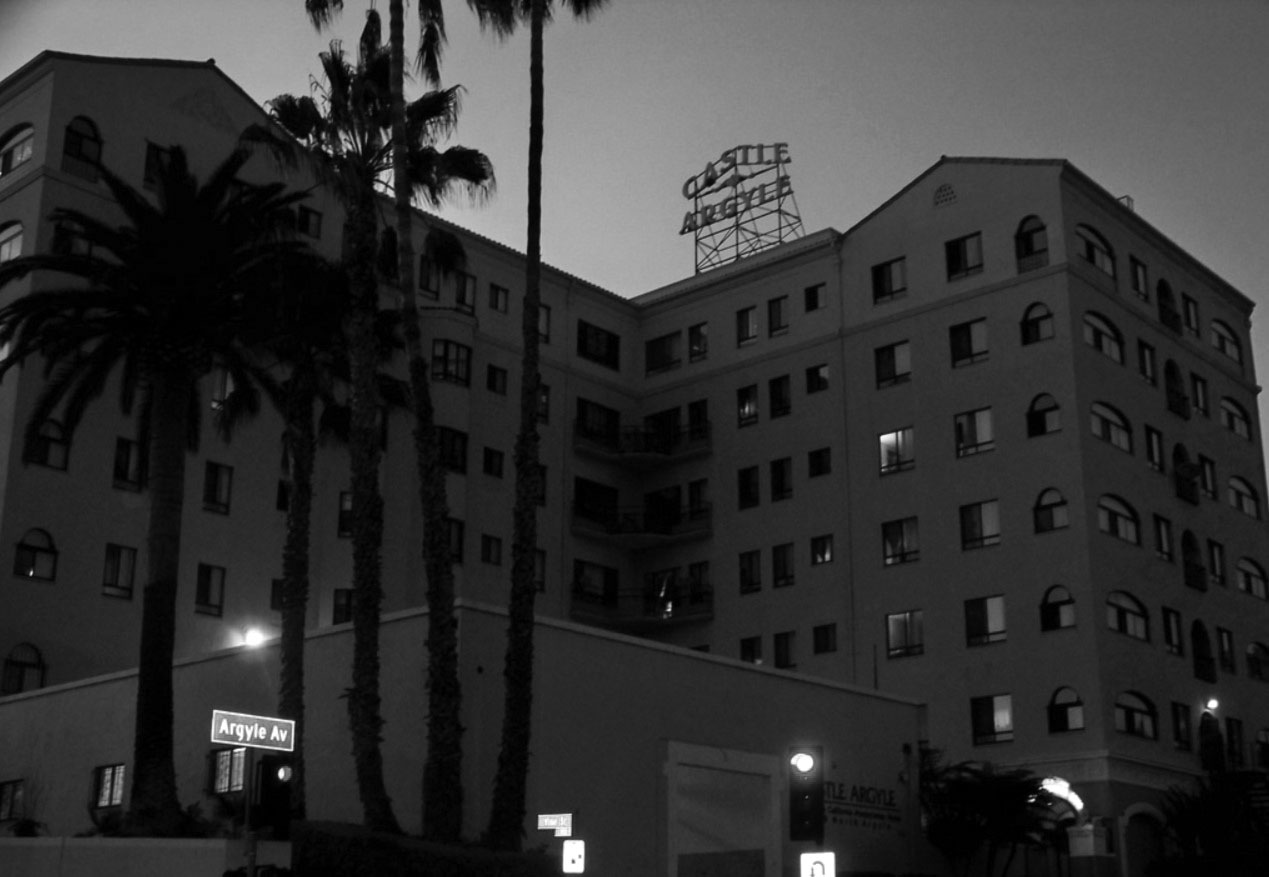 |
|
| (2009)^.^ – View looking northwest showing the Castle Argyle Apartments located at 1919 Argyle Avenue in Hollywood. Photo by Loren Javier |
Historical Notes The “Castle" once housed the likes of Clark Gable, Howard Hughes. But like other buildings in the area, it fell into disrepair. Today, it's a Presbyterian apartment house, which mainly serves low-income seniors. The Castle Argyle Sign was recently restored (Click HERE to see more). |
La Leyenda Apartments
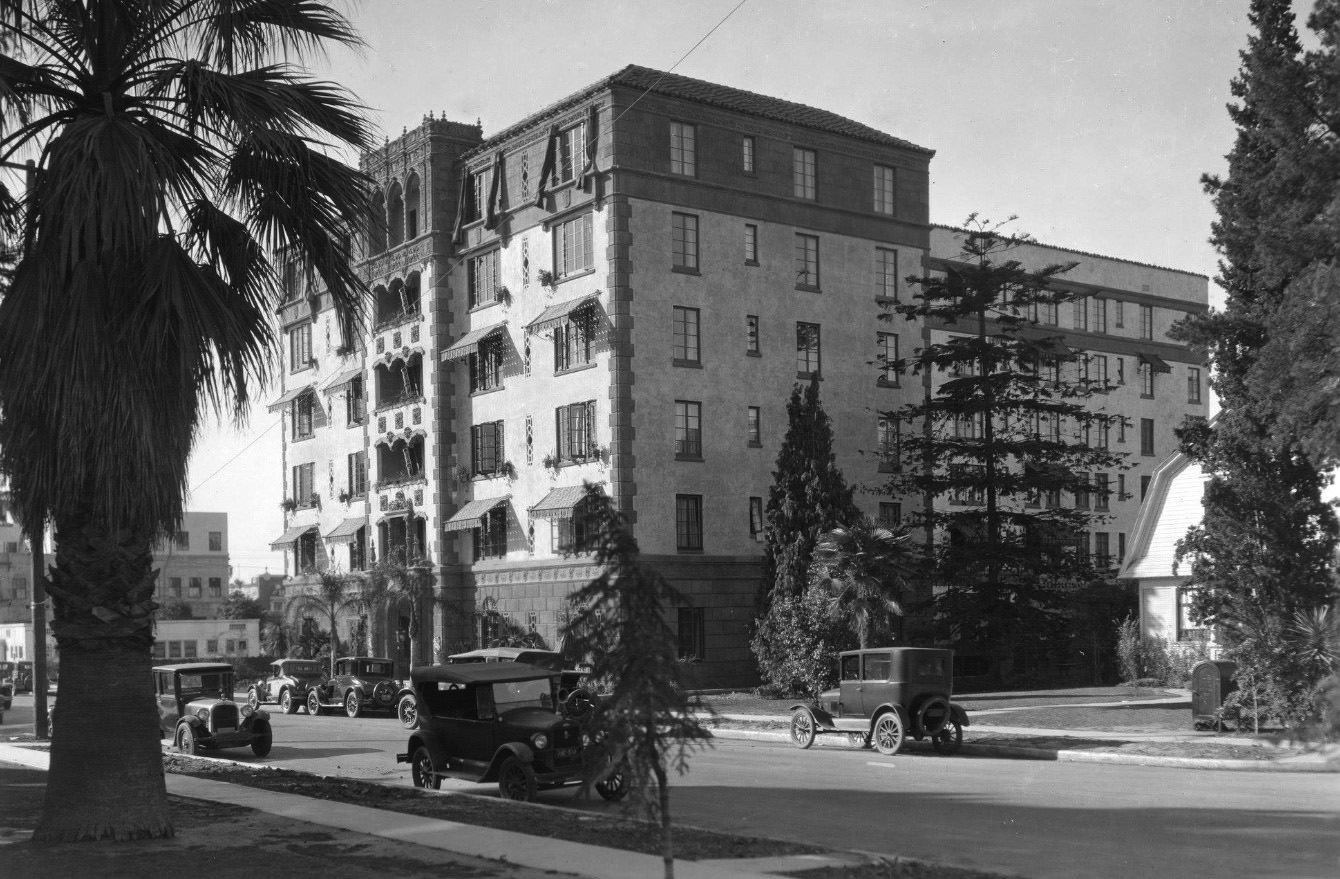 |
|
| (ca. 1929)^^^ – View looking southwest showing the La Leyenda Apartments located at 1737 Whitley Avenue in Hollywood. |
Historical Notes Built in 1927, the 6-story La Leyenda Apartment Building is located in the residential neighborhood of Whitley Heights in the Hollywood Hills. |
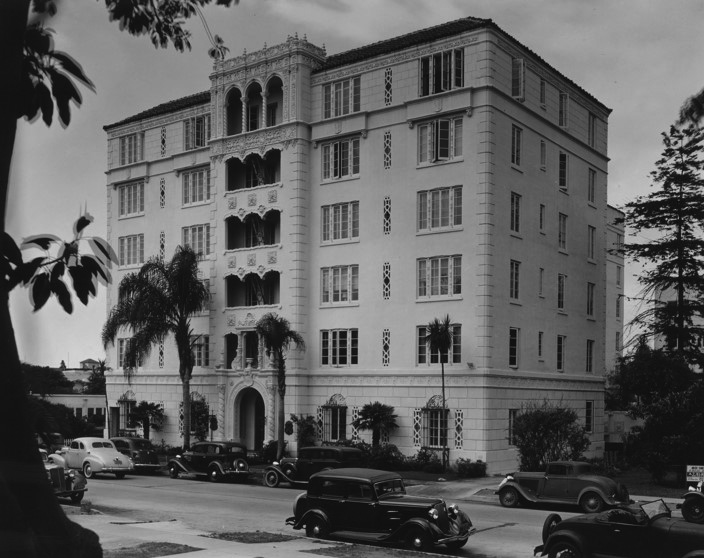 |
|
| (1930s)^^^ - View showing the 6-story La Leyenda Apartments with cars parked in front. The building is ornamented with decorative work. |
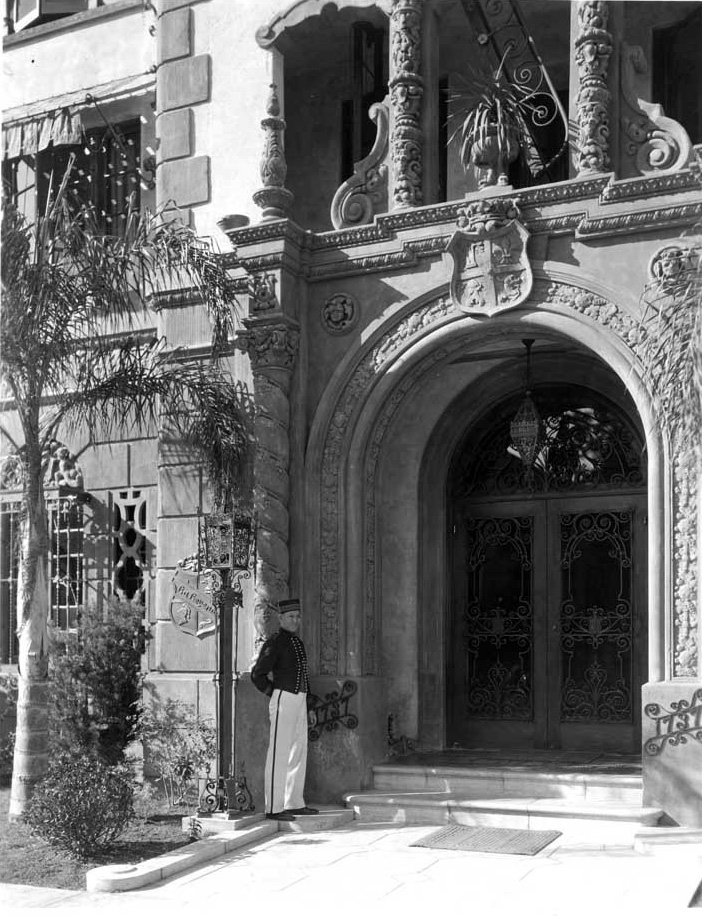 |
|
| (ca. 1929)^^^ – Doorman stands by the front entryway to the La Leyenda Apartments. Note the ornate Churrigueresque stone design. |
Historical Notes The La Leyenda Apartment Building exhibits character-defining features of Spanish Colonial Revival architecture including stucco surfaces which predominate over the openings; low-pitched tile roof; limited number of openings; formal garden; use of decorative ironwork; ceramic tile walls and floors; and Churrigueresque cast stone detailing.^ |
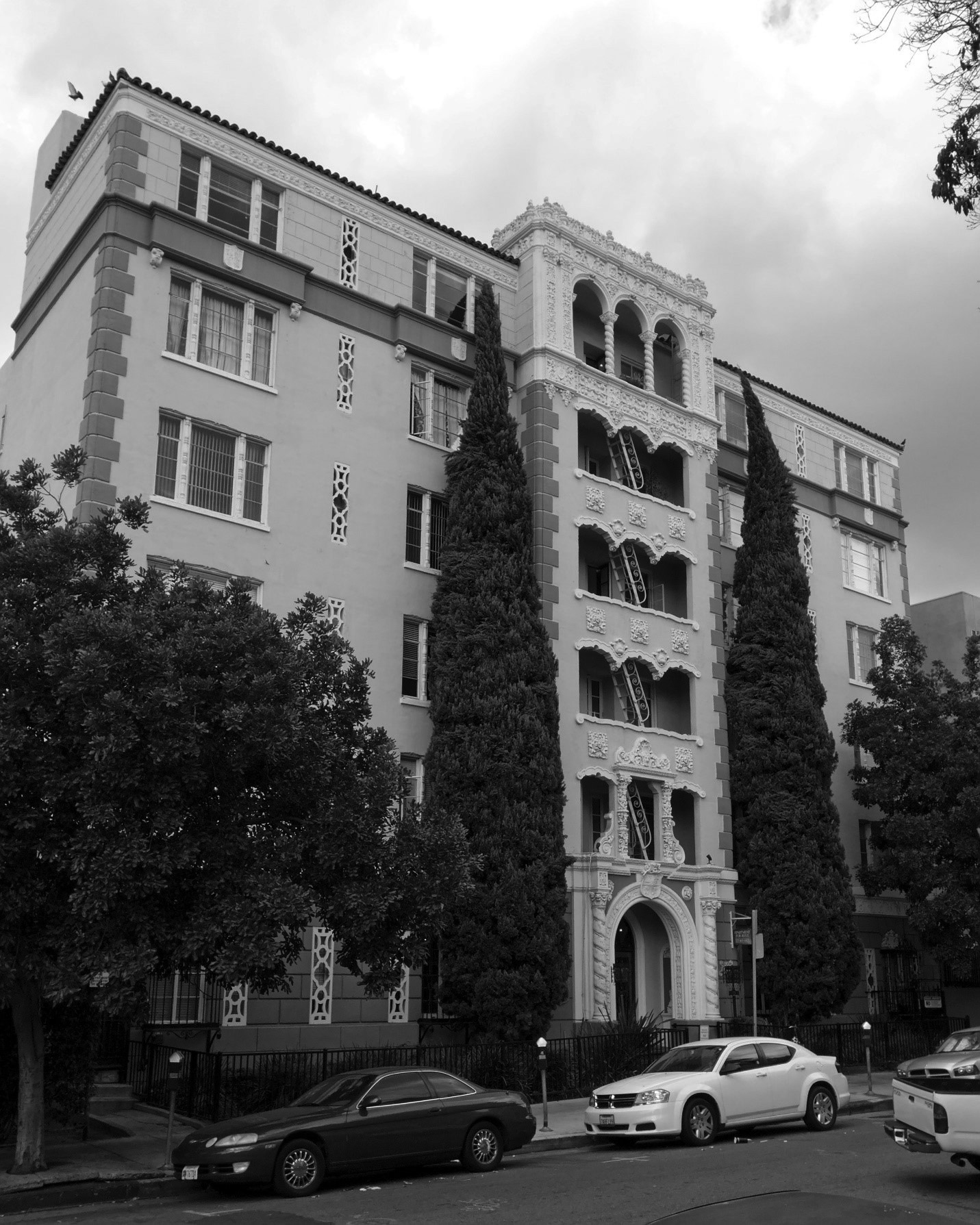 |
|
| (2015)*^ - La Leyenda Apartments as it appears today. Click HERE to see a more contemporary Google Street View. |
Historical Notes In 2005, the La Leyenda Apartment Building at 1735-1737 N. Whitley Avenue was dedicated as Los Angeles Historic-Cultural Monument No. 817. |
 |
|
| (2009)^.^ – Close-up view of the top two floors of the La Leylenda Apartments with its Churrigueresque cast stone detailing. Photo Courtesy: 'Just Above Sunset Photography' |
Marsden Apartments
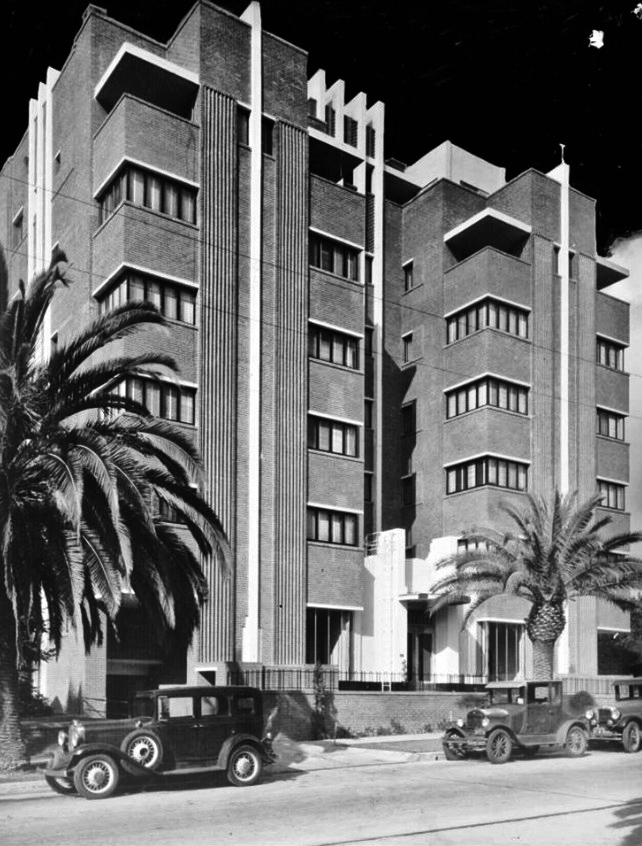 |
|
| (1935)^.^ - View showing the Marsden Apartments located at 1745 N. Gramcery Place in Hollywood. |
Historical Notes The Art-Deco building was designed by architect Frank Green, and was finished in 1935. At the time there were 68-single and 22-double apartments, and a 3-bedroom penthouse. |
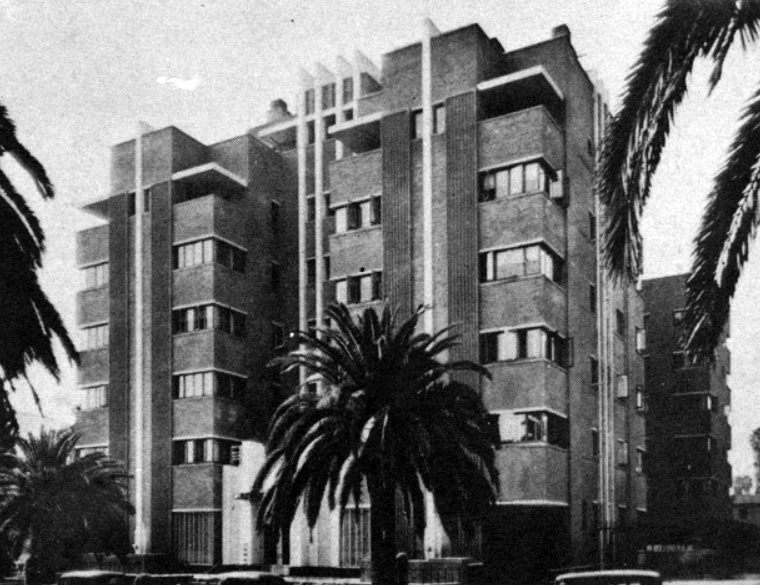 |
|
| (ca. 1935)^*# – Postcard view showing the Marsden Apartments located on N. Gramercy Place, between Fountain Avenue and Hollywood Boulevard. |
 |
|
| (2019)* – View showing the Marsden Apartments, today an Asssisted Living Facility, 1745 Gramercy Place, Hollywood. |
Bancroft Junior High School
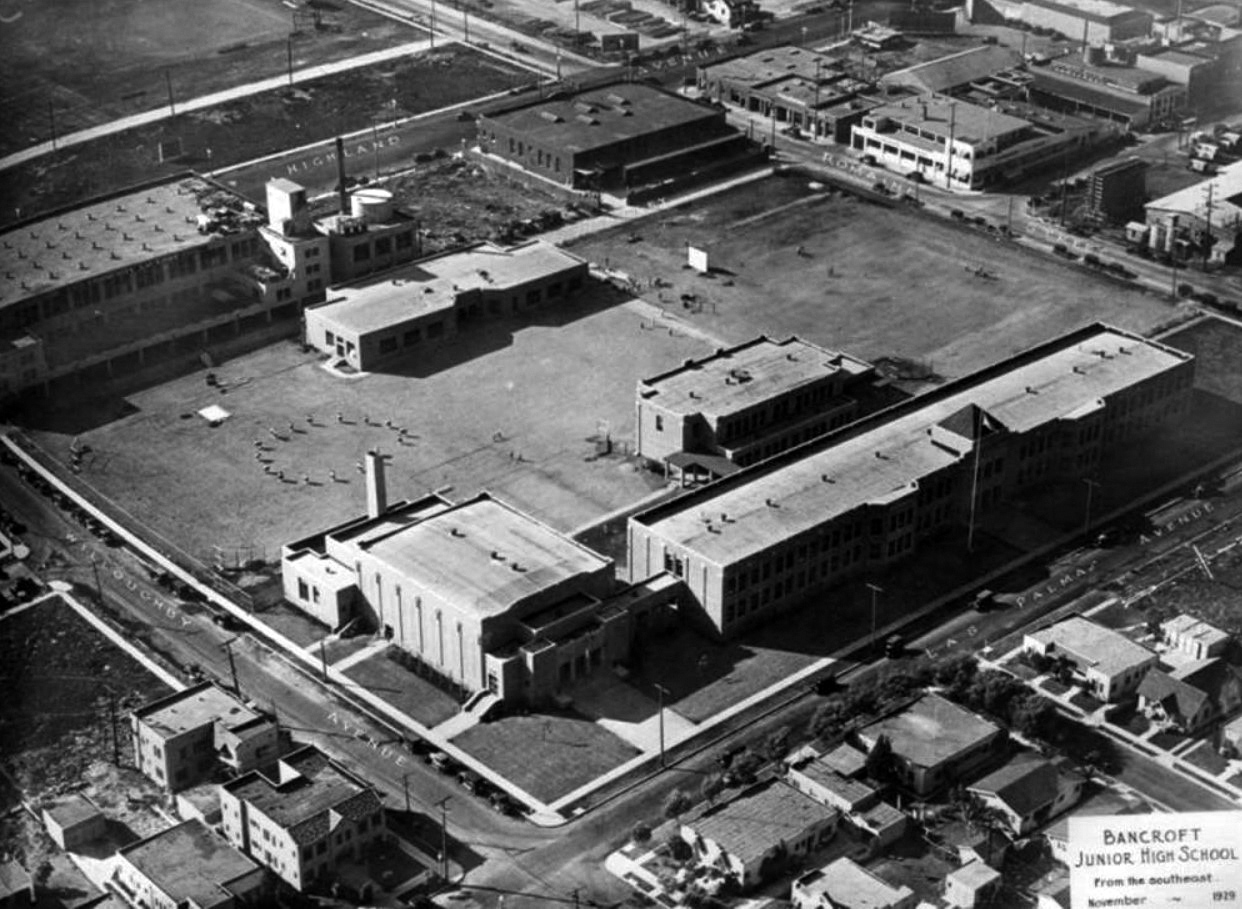 |
|
| (1929)* - Aerial view of a neighborhood of Hollywood showing Bancroft Junior High School (the year it opened), located at 929 N. Las Palmas Avenue, and surrounding residences. Highland Avenue is seen in the background and Las Palmas is identified in the foreground. The school later came to be called Bancroft Middle School. |
Historical Notes Bancroft Middle School opened its doors in 1929 as Hubert Howe Bancroft Junior High School. When it first began, it had 700 students enrolled and was staffed with 16 teachers. Today, the school has grown to 1,400 – double its size – and has 55 teachers on staff. The school was named after Hubert Howe Bancroft (May 5, 1832 – March 2, 1918) who was an American historian and ethnologist. He wrote, published and collected works concerning the western United States, Texas, California, Alaska, Mexico, Central America and British Columbia. He was the first Californian historian.* |
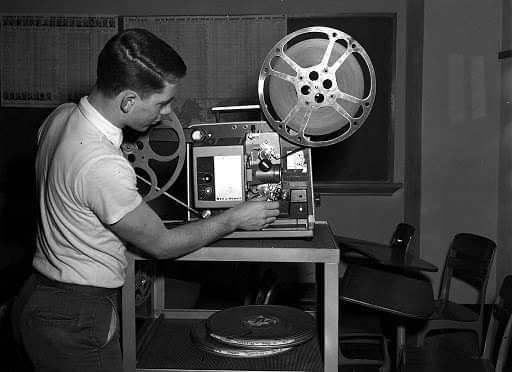 |
|
| (1960s)^ - A student sets up a projector for viewing. AV in junior high school, a great elective. |
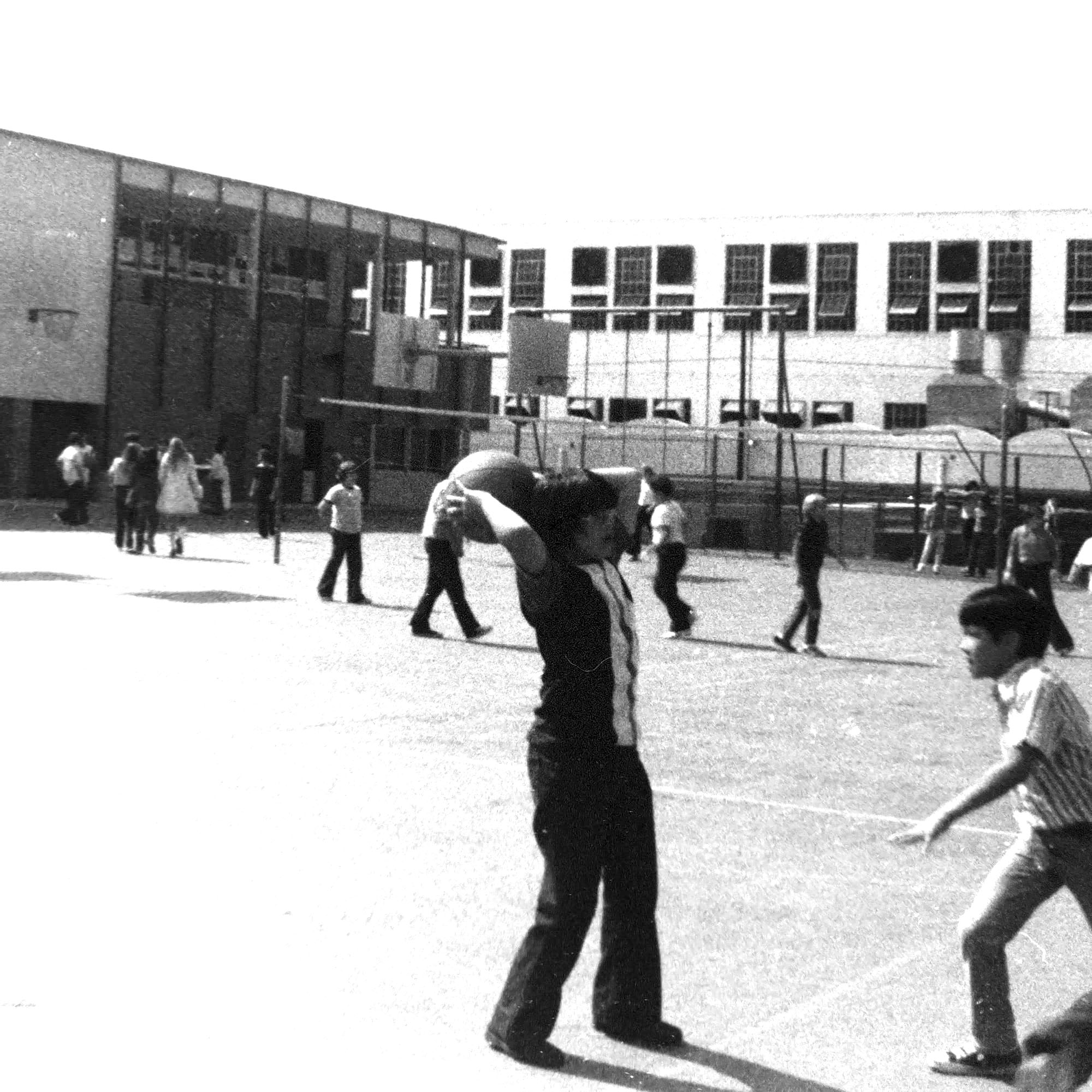 |
|
| (1973)* - The concrete jungle playground at Bancroft Jr. High with the American Linen Supply building seen in the background on the right. Photo by Jeff Katz |
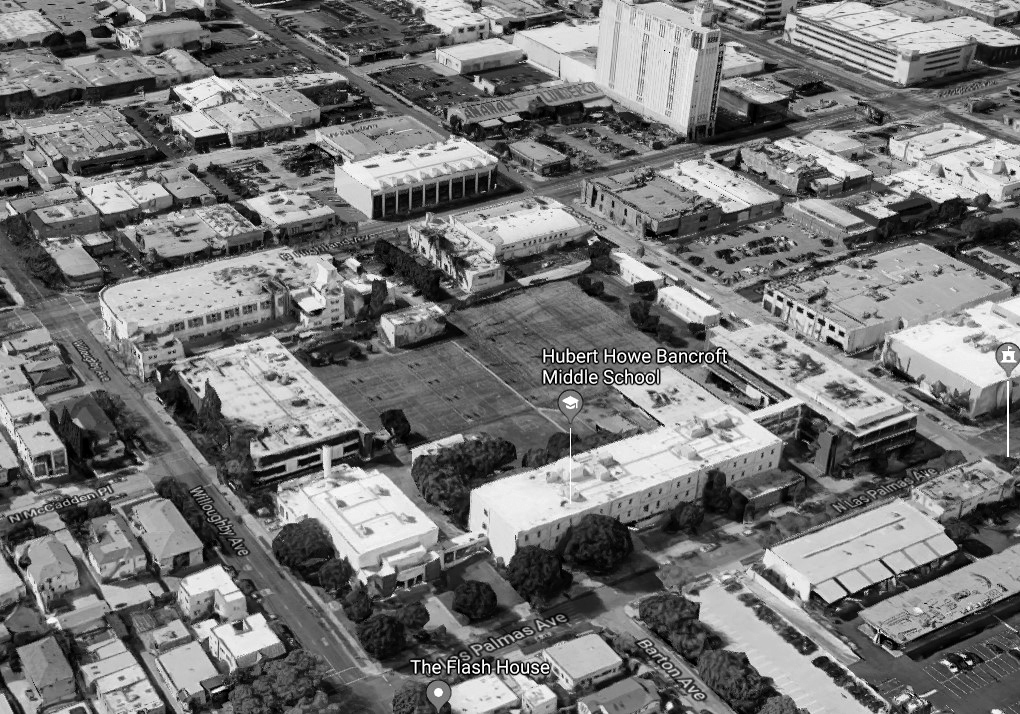 |
|
| (2019)^ – Aerial view looking NW showing Bancroft Middle School as it appears today. The intersection of Las Palmas and Willoughby is at lower-left. The tall building at upper right is the Hollywood Storage Building (built in 1925, 1025 N. Highland Ave). |
Historical Notes In 1981 Bancroft added the performing arts magnet. Beginning with the 1994-95 school year, Bancroft Junior High officially changed its name to Bancroft Middle School and welcomed sixth graders to the school for the first time. Although the school is located in Los Angeles, it services many children from surrounding areas including West Hollywood.* |
Hollywood-Vine Service Station
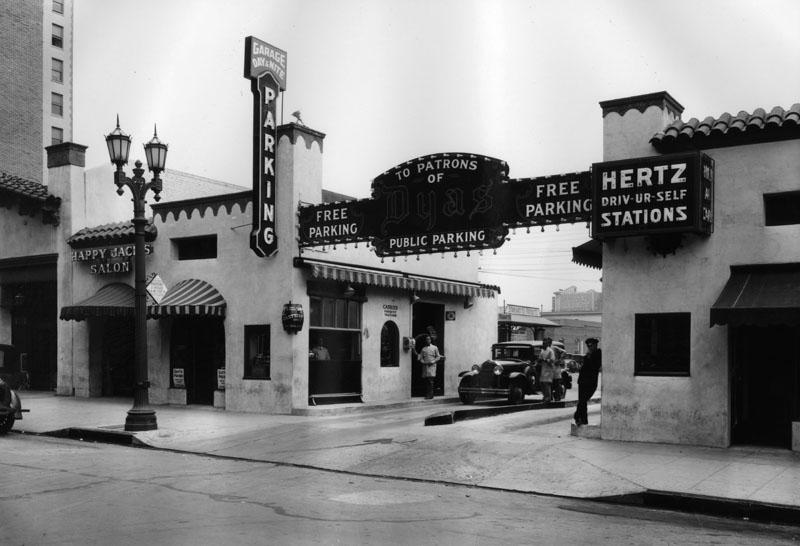 |
|
| (1930)* - The Hollywood-Vine service station and parking garage, with free parking provided for nearby establishments, including Pig 'N Whistle, Dyas Restaurant, and Hertz car rentals. Not only did attendants park customers' car, they also took their laundry for dry-cleaning. |
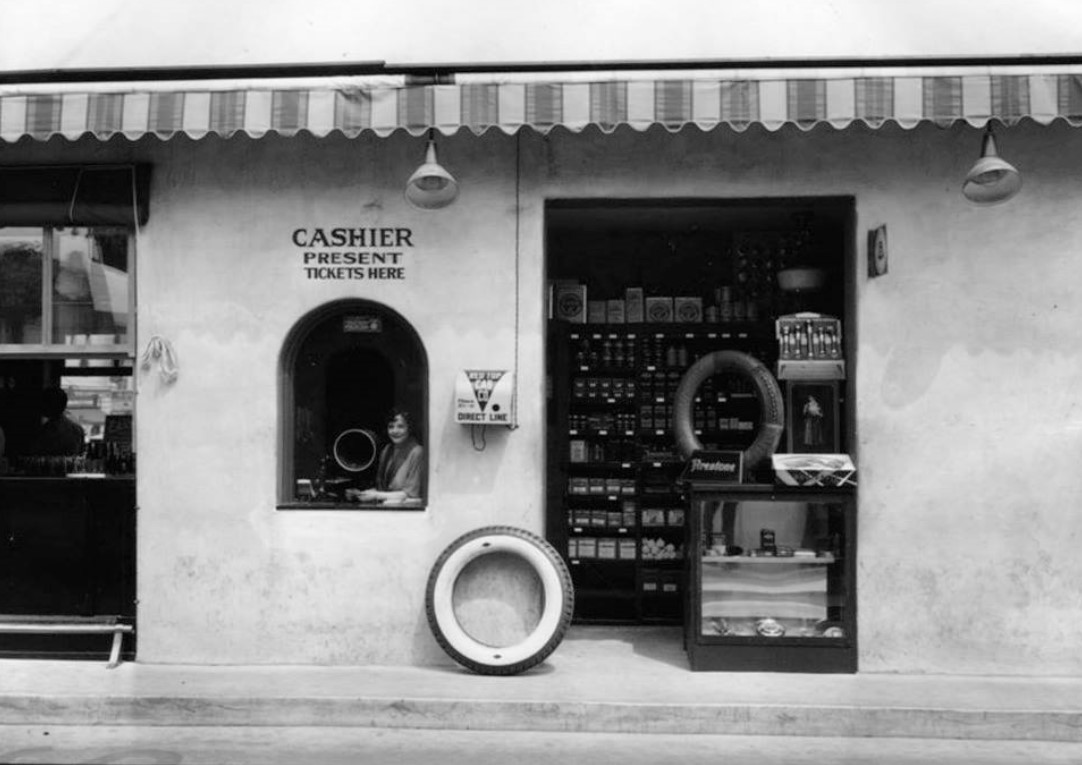 |
|
| (ca. 1930)* - Close-up view of the cashier for the Hollywood-Vine service station and parking garage. This resembles today’s all-in-one gas stations and mini-markets. Click HERE to see more Early Views of LA Gas Stations. |
Pig Stand Drive-in
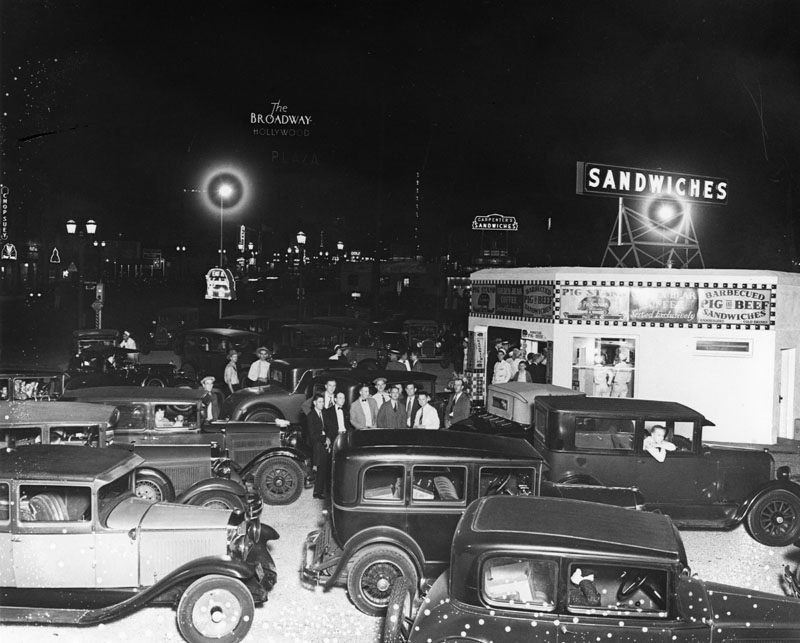 |
|
| (ca. 1930)* - Night view of Pig Stand drive-in restaurant, with customers posing for the photo. The Broadway-Hollywood on Hollywood and Vine is in the background. |
Historical Notes We didn't quite invent the drive-in restaurant in Los Angeles -- the Pig Stand in Dallas beat us by a year -- but we did do more than anyone to perfect the concept and ensure its spread. After all, we were living in the most car-oriented part of the country, and we did set the standard for what was cool.^^# A Dallas entrepreneur named Jessie G. Kirby built the first Pig Stand along a Dallas-Fort Worth Highway in October 1921. It was a hit with hungry drivers, and soon it became a chain. (The slogan: "America's Motor Lunch.") Kirby and his partners made one of the first franchising arrangements in restaurant history, and Pig Stands began cropping up everywhere. By 1934, there were more than 130 Pig Stands in nine states. (Most were in California and Florida.) Meanwhile, the chain kept innovating. Many people say that California's Pig Stand No. 21 became the first drive through restaurant in the world in 1931, and food historians believe that Pig Stand cooks invented deep-fried onion rings and chicken-fried steak sandwiches.*## |
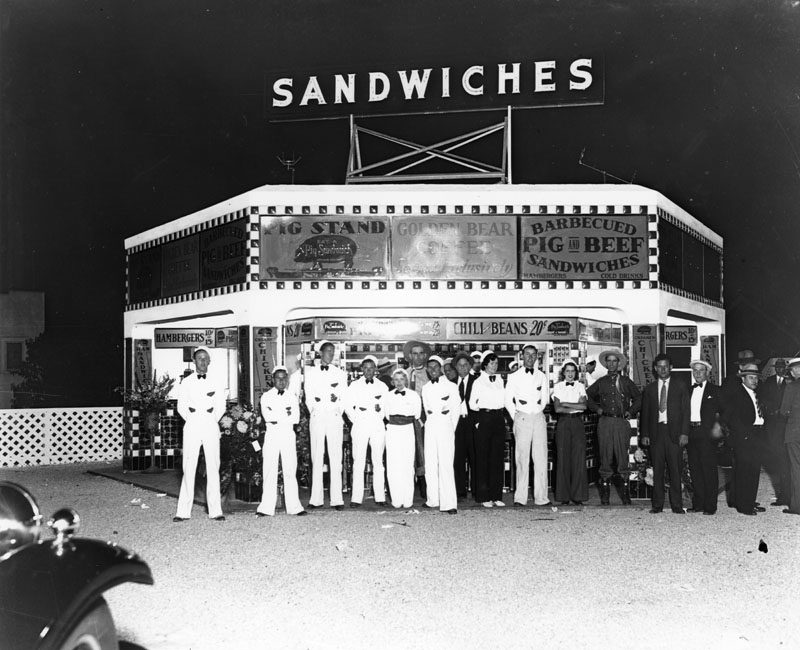 |
|
| (ca. 1930)* - Exterior view of Pig Stand drive-in restaurant, with the carhops posing for the photo. The drive-in was located on the southeast corner of Sunset and Vine. |
Historical Notes Wartime gasoline and food rationing hit the Pig Stands hard, and after the war they struggled to compete with newer, flashier drive-ins. By the end of the 1950s, all of the franchises outside of Texas had closed. By 2005, even the Texas Pig Stands were struggling to survive—only six remained in the whole state—and by the next year they had all disappeared.*## Click HERE to see more Early Views of LA Drive-in Restaurants. |
* * * * * |
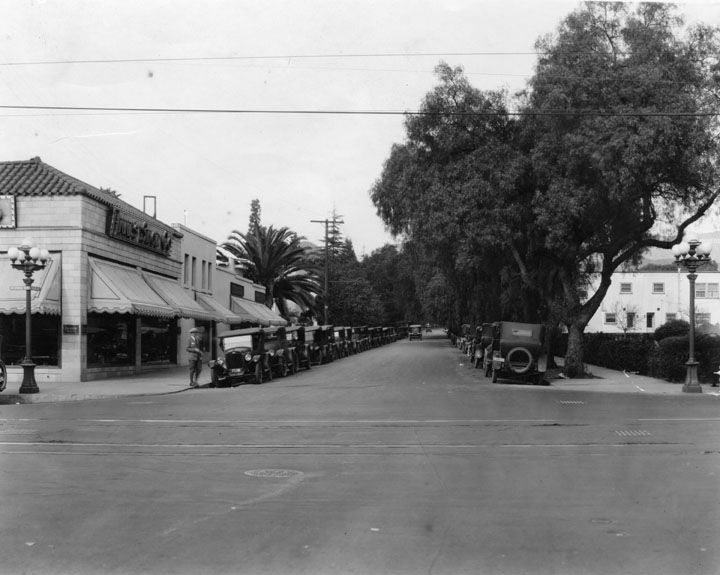 |
|
| (ca. 1930)* - Looking north on Wilcox Ave. at Hollywood Blvd. Cars are lined up at both sides of Wilcox Ave. At the corner is the Innes Shoe Co. |
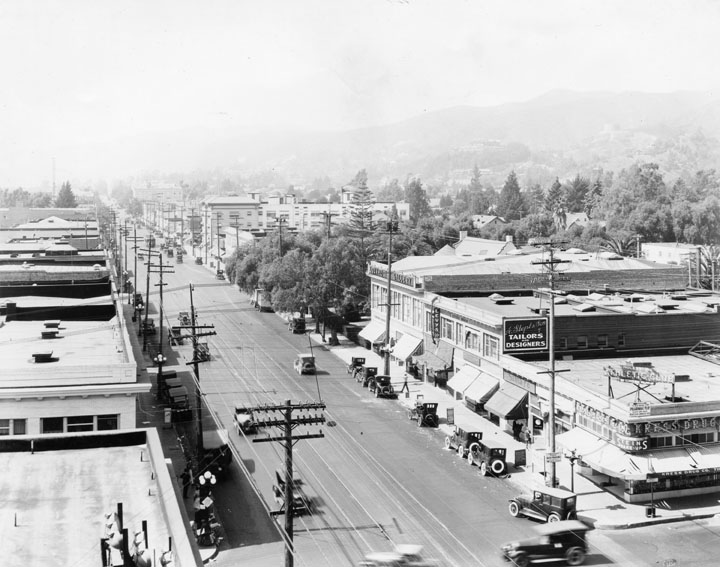 |
|
| (ca. 1930)* - View looking west on Hollywood Boulevard at Cahuenga. Kress Drug Co. is visible in the lower right corner. |
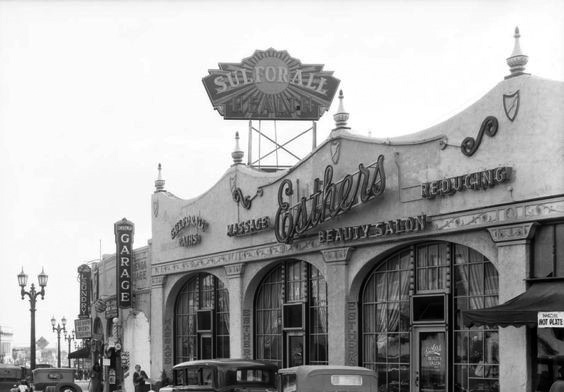 |
|
| (ca. 1930)**## – View showing Esther's Beauty Salon and Baths located at 1769 N. Cahuenga Blvd in Hollywood. Offering 'Messages' and 'Reducing'. Large sign on top of building reads: SULFORALL. Photo courtesy of Martin Turnbull |
Musso and Frank(s) Grill
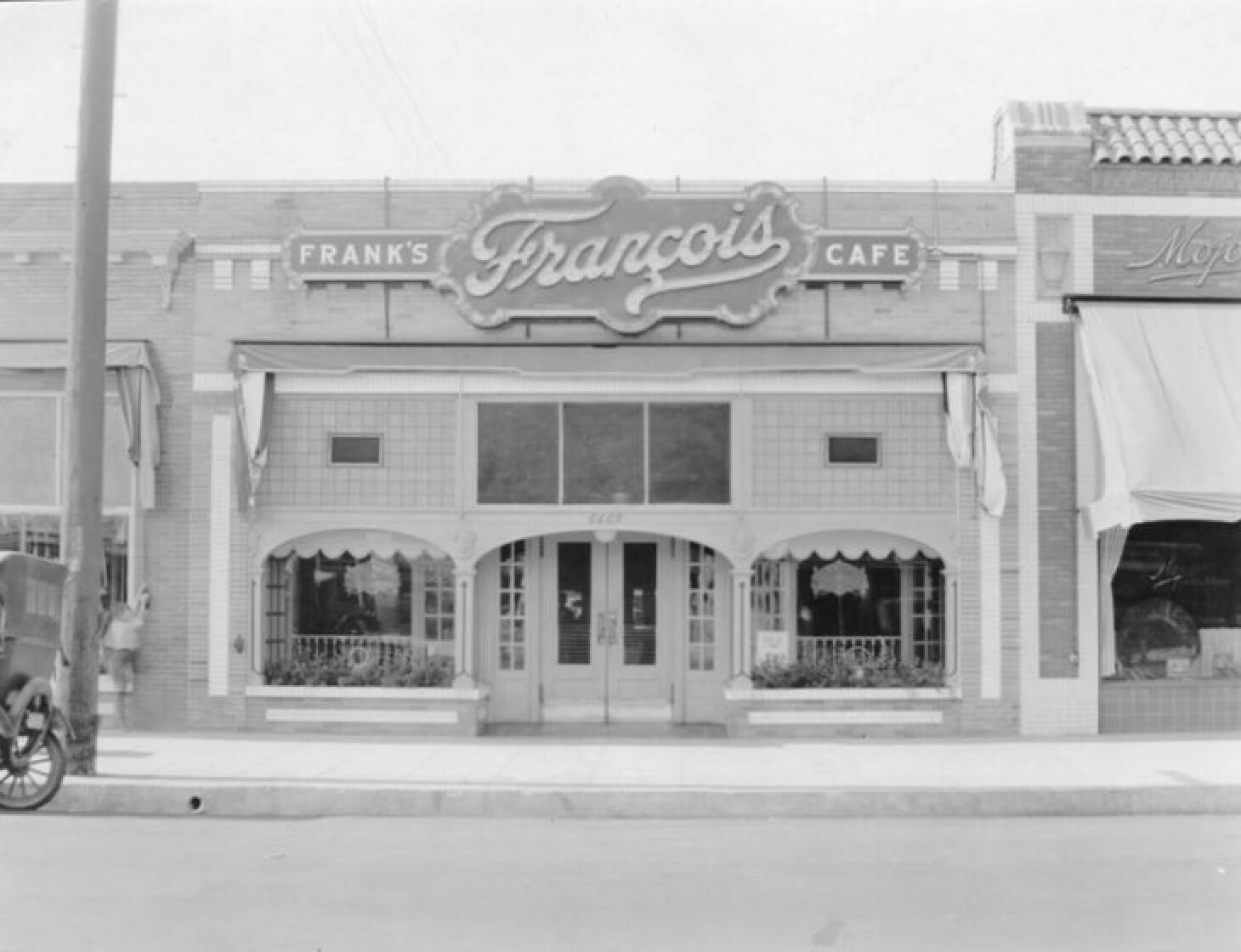 |
|
| (ca. 1920)* – Frank’s Francois Café located at 6669 Hollywood Boulevard. |
Historical Notes The restaurant opened in 1919 in the space just west of where it’s located today (currently Cabo Cantina) at 6669 Hollywood Blvd. as Frank's Cafe by founder Firmin "Frank" Toulet and his father-in-law, Robert Prachacq. |
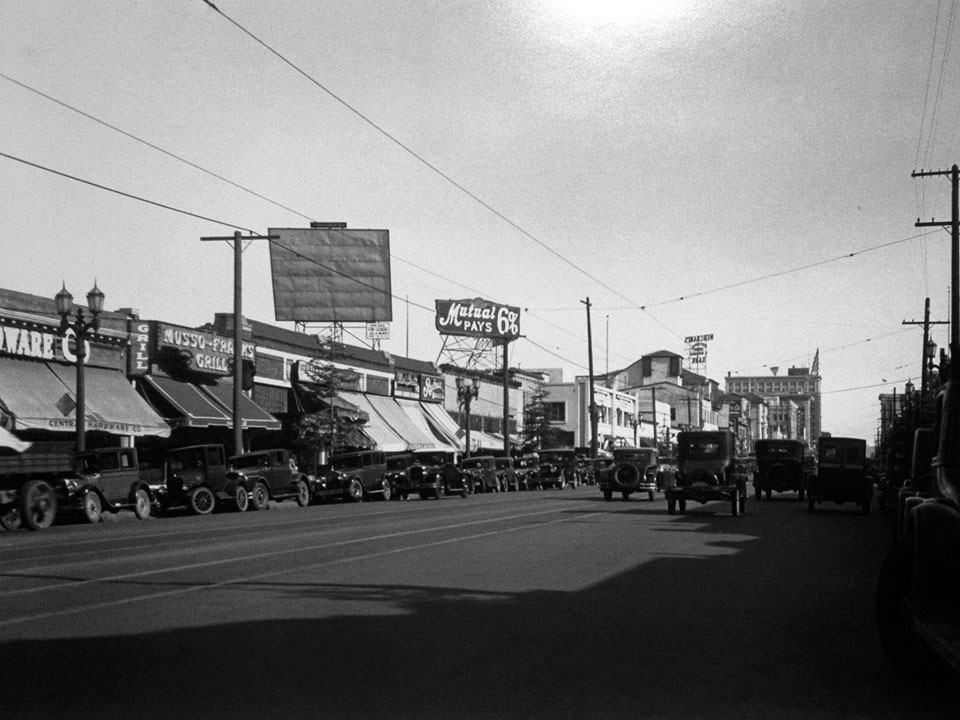 |
|
| (1928)^#^^ – View of Hollywood Boulevard looking east between Las Palmas and Cherokee avenues. At left is the Musso & Franks Grill, oldest restaurant in Hollywood, seen above after it moved one door east to 6667 Hollywood Blvd. |
Historical Notes On September 27, 1919, The Hollywood Citizen ran an announcement about the opening of Frank Toulet’s new restaurant, Frank’s Café at 6669 Hollywood Blvd. In time, Toulet partnered with restaurateur Joseph Musso. The pair sold the restaurant in 1927 to two Italian immigrants, Joseph Carissimi and John Mosso, who years later moved The Musso & Frank Grill next door to 6667 Hollywood Blvd., where it still stands.* |
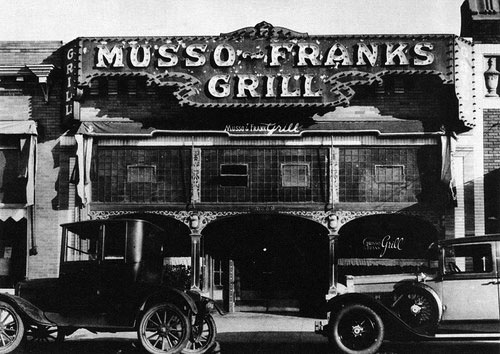 |
|
| (ca. 1930)#*^* - View of Musso and Franks Grill located at 6667 Hollywood Boulevard, between Cherokee and Las Palmas Avenues. |
Historical Notes By the 1930s Musso and Frank was firmly established at the center of Hollywood's cultural life. Stanley Rose's essential bookstore was right next door to the restaurant, and many of the writers of the hard-boiled fiction that he preferred, who hung out in the back room of the bookstore, spent endless hours in the bar of Musso and Frank; e.g. James M. Cain, John Fante (who frequented the restaurant with famed journalist and historian Carey McWilliams), Raymond Chandler, and Nathanael West. Other literary regulars include William Saroyan, Dashiell Hammett, Erskine Caldwell, Dorothy Parker, William Faulkner, F. Scott Fitzgerald, Elliot Paul, and Donald Ogden Stewart. *^ |
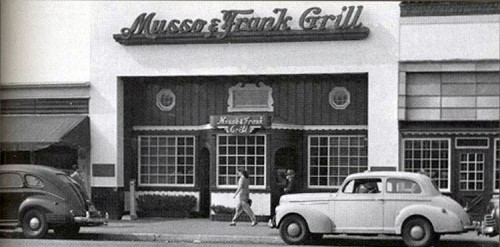 |
|
| (ca. 1940s)*#*^ - View of a woman walking in front of Musso and Frank Grill in Hollywood. |
Historical Notes By the 1940s the restaurant was so firmly identified with the Los Angeles literary scene that aspiring writers, e.g. Charles Bukowski, would drink there in a conscious effort to imitate their role models. Eminent California historian Kevin Starr has said that a list of writers who frequented Musso and Frank resembles "the list of required reading for a sophomore survey of the mid-twentieth-century American novel." *^ |
 |
|
| (ca. 1954)^##* – View showing a Yellow Cab in front of Musso and Frank Grill, 6667 Hollywood Boulevard. |
Historical Notes Musso and Frank has been essential in the social life of the Los Angeles film industry. The restaurant kept a separate back room for its film industry clientele, which included not only screenwriters, but actors, producers and directors as well, including Tom Mix, Charlie Chaplin, Harry Warner and his brother Jack, Greta Garbo, Humphrey Bogart, Marilyn Monroe, Douglas Fairbanks, Mary Pickford, Orson Welles, Rudolph Valentino, and Budd Schulberg.*^ |
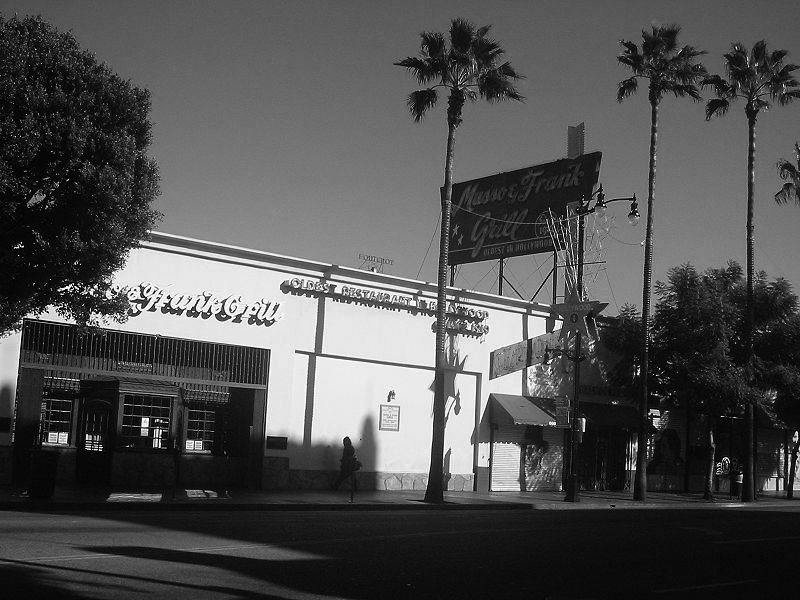 |
|
| (2007)*^ - View of Musso and Frank Grill in Hollywood as seen from across the street. On the roof of the restaurant is the name, plus the lettering: "Since 1919. Oldest in Hollywood". |
Historical Notes Surrounded by the blight of tattoo parlors and cheesy knickknack shops following Hollywood’s decline and tourist trap transformation, Musso & Frank Grill literally has not changed. The waiters have been doing their thing for 25 years, and the booths are probably the same ones that Frank Sinatra, Edward G. Robinson, and Greta Garbo used.#^*^ |
 |
|
| (2016)* – Neon sign reads: Musso & Frank Grill – Oldest in Hollywood – Since 1919. Photo courtesy of Roadside Architecutre |
Historical Notes The current operators of Musso and Frank are the descendants of earlier owners from the 1920’s. Frank Toulet and his family opened the restaurant, Frank’s Cafe in 1919. Later the name changed to Musso-Frank Grill. In 1927, John Mosso and Joseph Carissimi purchased the restaurant. When John Mosso died in 1974, his daughter, Rose, and Joseph Carissimi’s daughter-in-law, Edith, ran the restaurant. Years later, in 2009, the Carissimi family sold their interest to the descendants of John Mosso. Today, John Mosso’s great-grandsons, Mark Echeverria and Jordan Jones are proprietors, while Mark is restaurant manager.* |
* * * * * |
Pantages Theatre
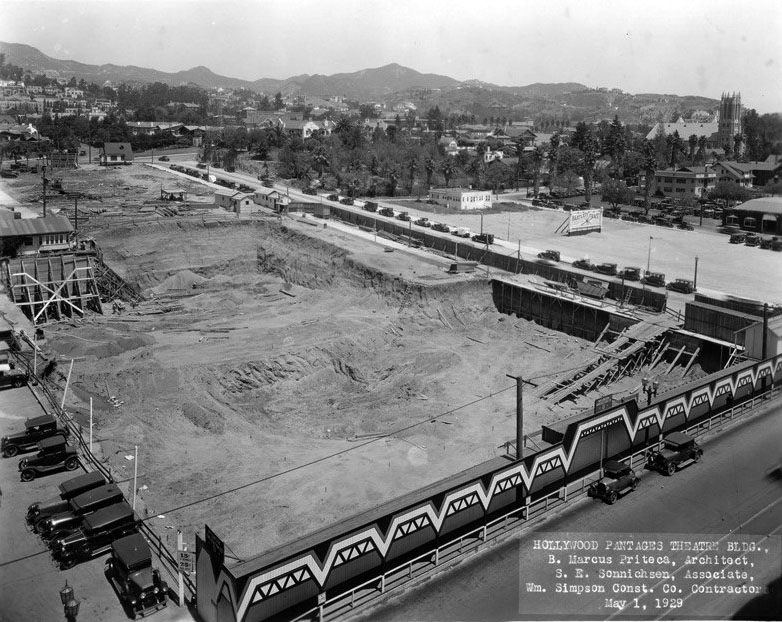 |
|
| (1929)^^^ – View looking northeast showing the construction site for the Hollywood Pantages Theatre, located on the northwest corner of Hollywood Boulevard and Argyle Avenue. |
Historical Notes The tallest peak in the distance is Mt. Hollywood, near where the Griffith Park Observatory would be built in 1933. |
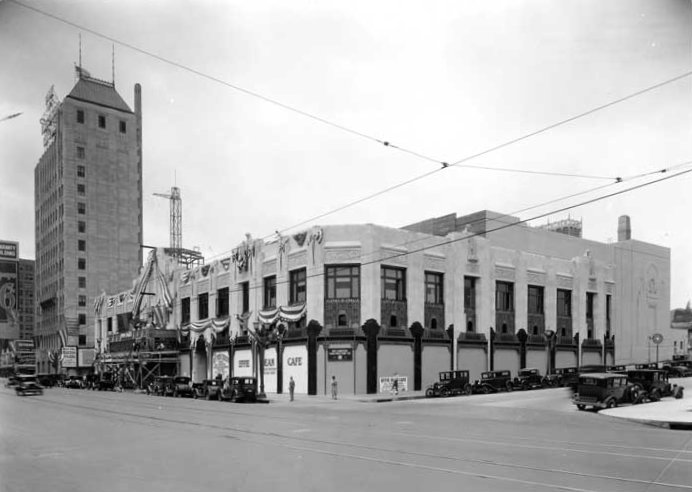 |
|
| (1930)^^^ - View of the Pantages Theater still under construction in 1930, located on the northwest corner of Hollywood Boulevard and Argyle Avenue. The tall building to the west is the Equitable Building, located on the northeast corner of Hollywood and Vine. |
Historical Notes The Pantages Theatre, formerly known as RKO Pantages Theatre was the last theater built by the vaudeville impresario Alexander Pantages. The palatial Art Deco theater opened on June 4, 1930, as part of the Pantages Theatre Circuit.*^ |
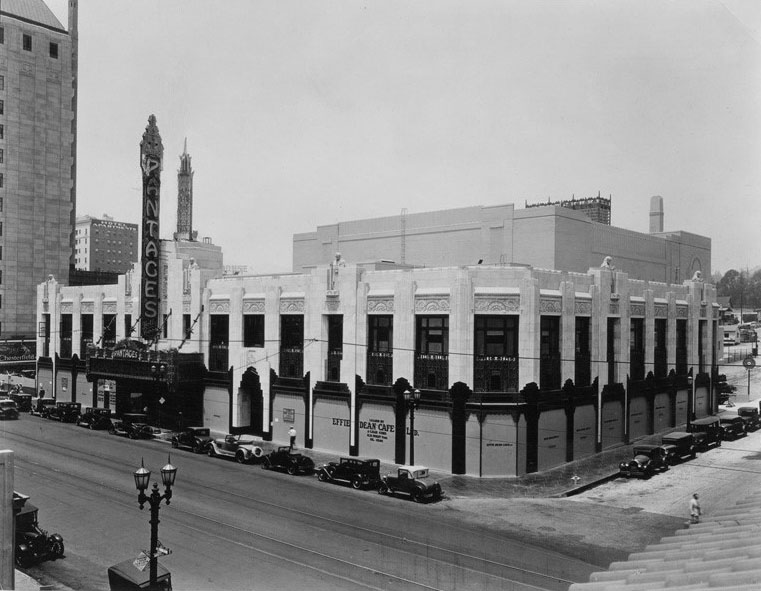 |
|
| (1930)^^^ - View looking at the northwest corner of Hollywod and Argyle showing the newly completed Pantages Theatre. |
Historical Notes The original plans for the Pantages were for a 12-story building: 2 floors dedicated to theater and 10 floors of office space. Completion of the 10 upper floors was halted due to the 1929 stock market crash during construction.*^ |
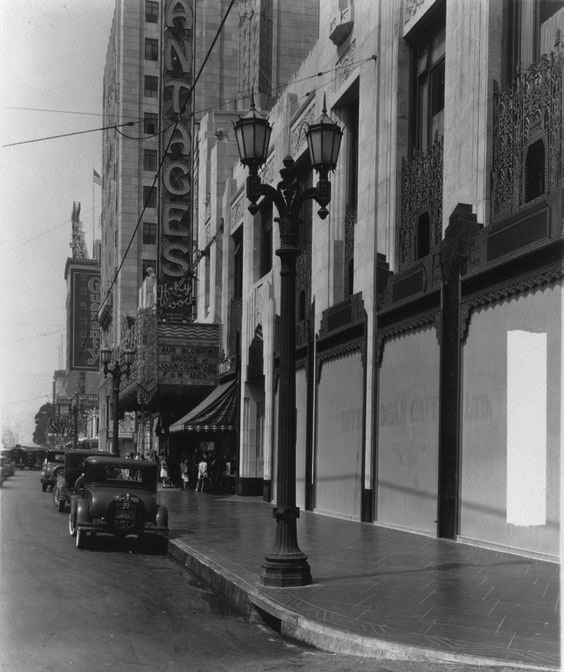 |
|
| (1930s)^v^ - Street view looking west on Hollywood Boulevard from Argyle Avenue showing the Pantages Theatre. |
 |
|
| (1930)#**# – View showing the glitter and lights of the Pantages Theatre on what appears to be opening night. We’re looking southwest at the back of the theatre with cars parked along Argyle Avenue. Note the Art-Deco bas relief designs on the side of the building. |
Historical Notes The Pantages opened on June 4th, 1930 with MGM's “The Floradora Girl” starring Marion Davies. |
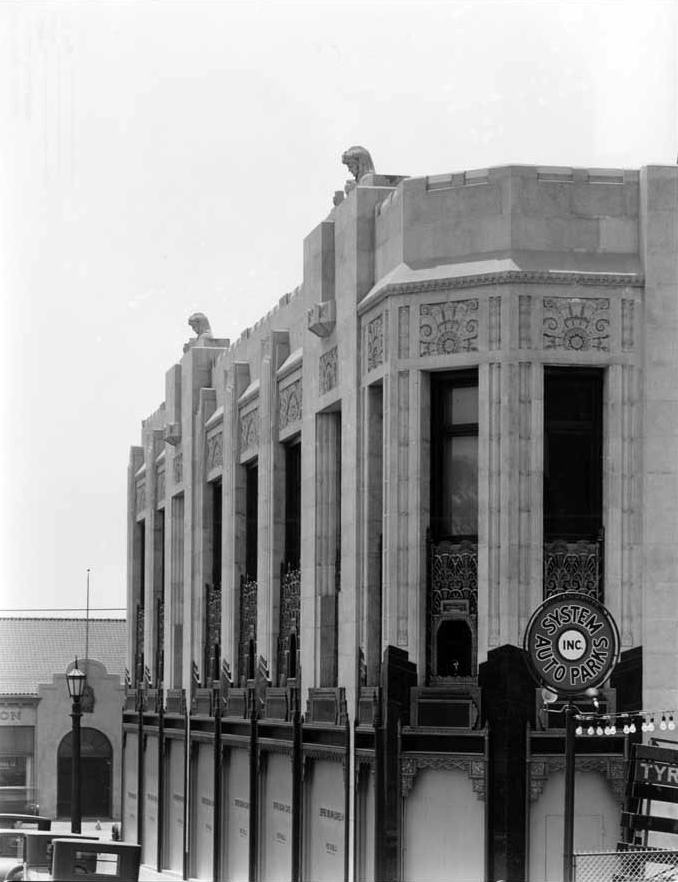 |
|
| (ca. 1930)^^^ – Profile view looking toward Hollywood Boulevard at Argyle Avenue showing some of the Art Deco designs on the side of the Pantages building. Note the statues along the roof line. |
Historical Notes Designed by B. Marcus Priteca at the epitome of the Art Deco era, from sidewalk to stage, the Pantages dazzles theater-goers with chevrons, zigzags, starbrusts, and exotic figures.^ |
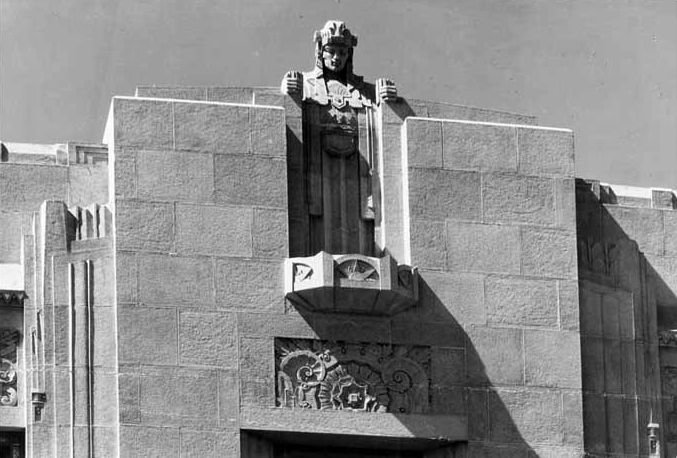 |
|
| (ca. 1930)^^^ - Close-up view of one of the many statues that run along the Pantages’ roof line. They’re of a Mayan man with headdress. |
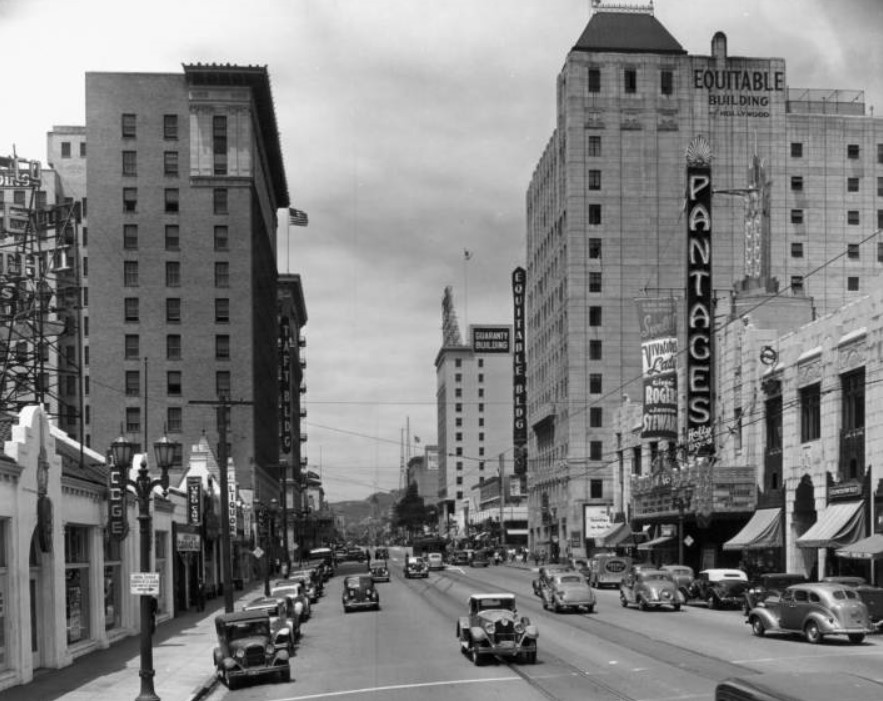 |
|
| (1930s)^^ - View looking west on Hollywood Boulevard showing the Pantages Theatre on the right. One block to the west is the intersection of Hollywood and Vine where three taller buildings stand (Equitable Building, Taft Building, and Broadway-Hollywood Building). |
 |
|
| (1930)* - Exterior view of the Pantages Theatre located at 6233 Hollywood Boulevard shortly after it opened. Click HERE to see contemporary view. |
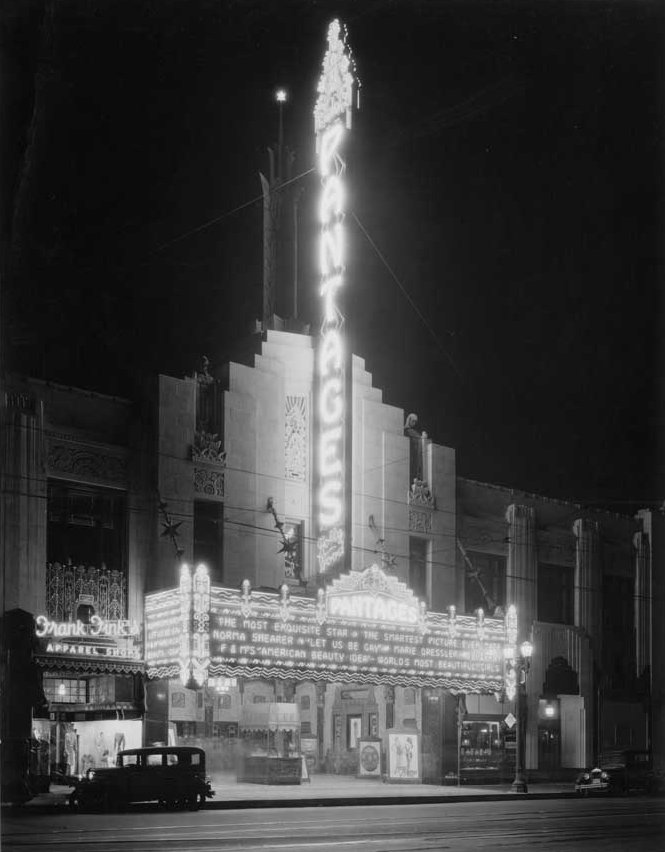 |
|
| (ca. 1930)^*# - Nighttime view of the front entrance to the Pantages Theater. Frank Fink's Apparel Shop is seen on the left. |
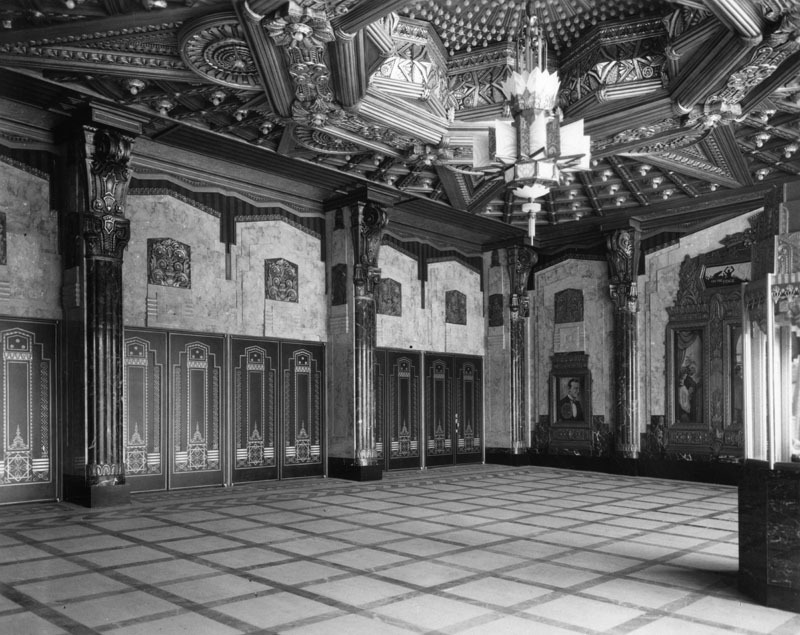 |
|
| (1930)* - View of the foyer at the Pantages Theatre with a close look at the ceiling. |
Historical Notes Alexander Pantages sold the Hollywood landmark in 1932 to Fox West Coast Theaters. In 1949, Howard Hughes acquired the Pantages for his RKO Theatre Circuit and moved his personal offices to the building's second floor. From 1949 through 1959, the theatre hosted the American motion picture industry's annual Academy Award Ceremonies.*^ |
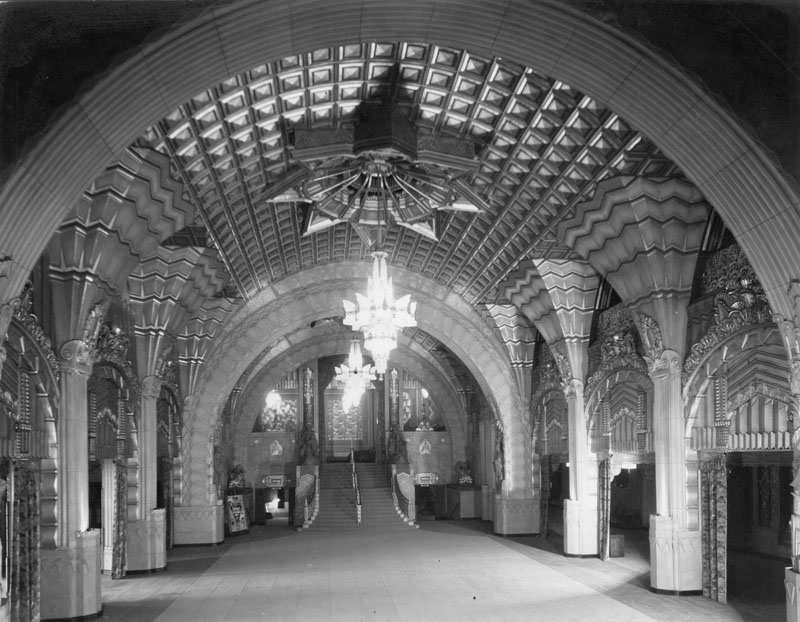 |
|
| (ca. 1930)* - Interior view of the Pantages Theatre. Designed by architect B. Marcus Priteca it is perhaps the most impressive of any Los Angeles theatre. |
Historical Notes The grand lobby is a magnificent poly-chromatic fan-vaulted space, that is 110 feet wide and 60 feet deep. It is decorated in a zigzag geometric design in gold and henna shades. The entire area was illuminated by three huge Moderne frosted glass chandeliers hanging from three star-shaped domes. |
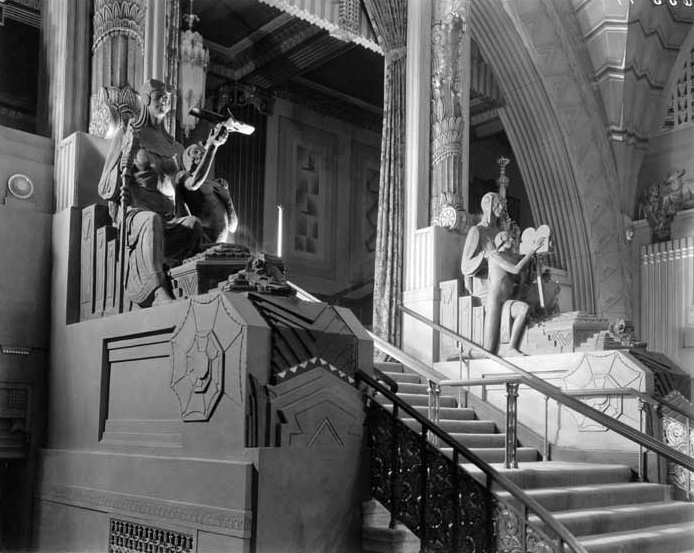 |
|
| (ca. 1930)^*# - View showing one of the two Art-Deco staircases decorated with Art Deco style statues. |
Historical Notes At each end of the grand lobby is a 20 feet wide stairway, lined with vaguely Egyptian and Assyro-Babylonian styled statues, one of which depicts in an Art Deco style, a camera crew filming. |
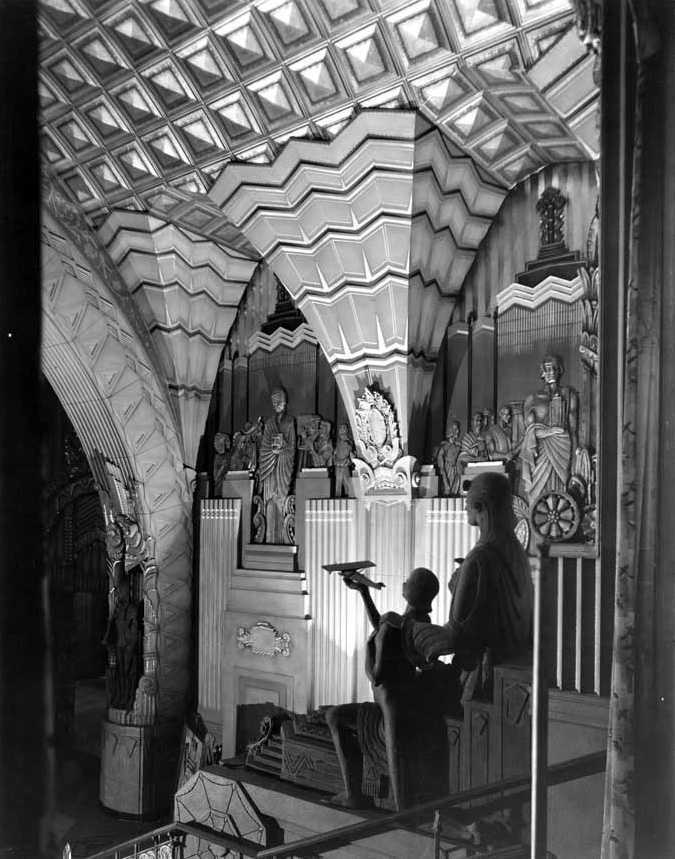 |
|
| (ca. 1930)^*# - View looking down into the grand lobby from top of staircase showing the magnificent zigzag geometric design of the pillars. |
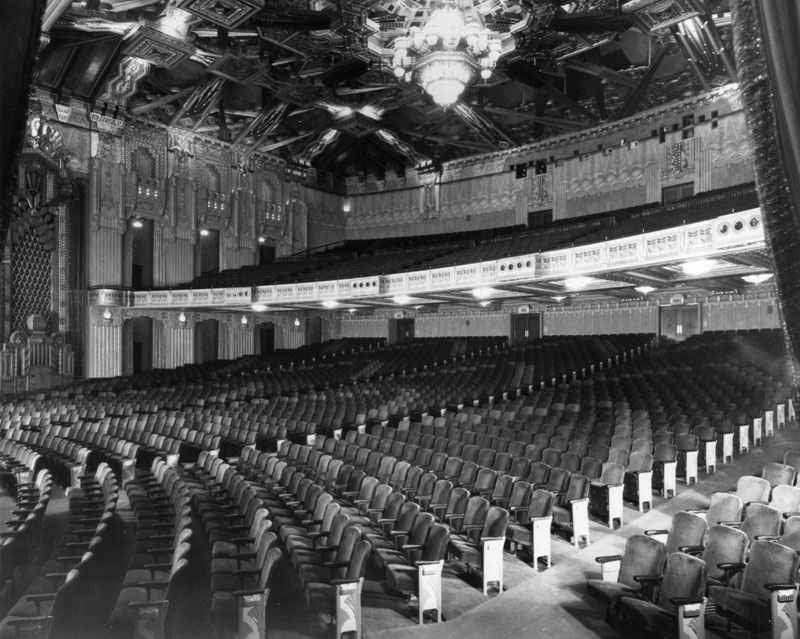 |
|
| (1930)* - View of the auditorium interior of the Pantages Theatre. |
Historical Notes The auditorium was designed to seat 3,212, but it opened with extra legroom and wider seats to give more comfort for its 2,812 patrons.^^# |
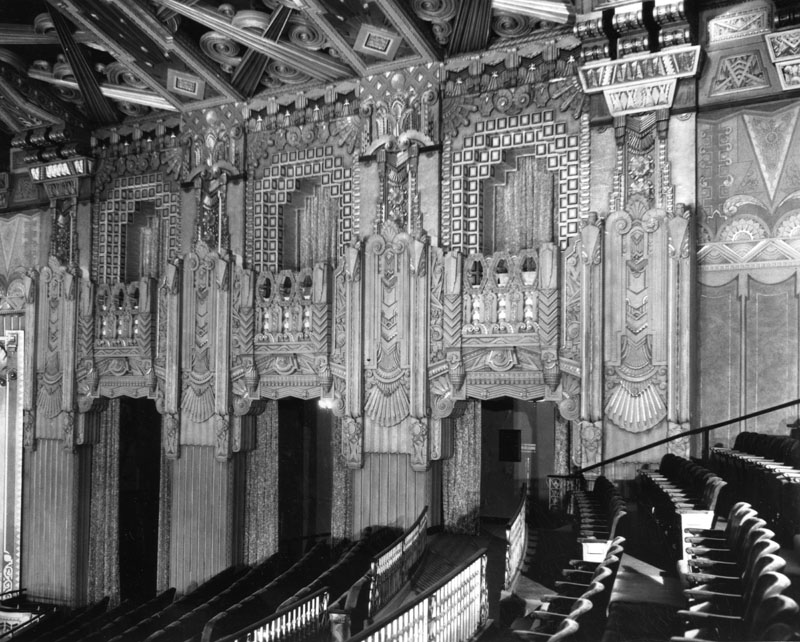 |
|
| (1930)* - A partial view of the balcony seats inside the Pantages Theatre. Note the details of the ornamental Art Deco designs on the wall. |
Historical Notes The crowning beauty of the dazzling Art Deco style decorations which cover almost every inch of the theatre interior, by interior designer/muralist Anthony B. Heinsbergen, is the double ceiling made in a series of ‘busy’ fretwork sunray effects which converge from the center, from which is hung a tremendous frosted glass and bronze chandelier.^^# |
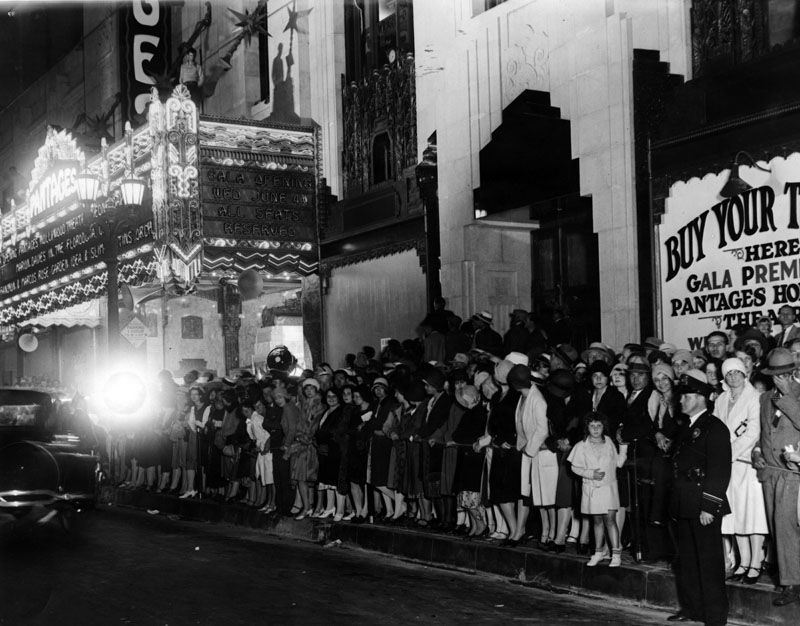 |
|
| (1930)* - Close-up view of fans awaiting the arrival of celebrities attending gala opening premiere of "Florodora Girl", starring Marion Davies. |
Historical Notes The Pantages Theatre was one of the first movie houses to be built after the advent of talking pictures and once boasted the most elaborate sound system in the world. It opened with Marion Davies in “The Floradora Girl” on screen, and “The Rose Garden Idea” a Franchon & Marco stage revue.^^# |
 |
|
| (ca. 1930)* - Night view of the Pantages Theater featuring a Clara Bow movie. |
Historical Notes The Pantages Theater continued to be a major venue for road show movies into the 1970s. From 1965, it was operated by Pacific Theatres. It closed as a movie theater in January, 1977, and re-opened the following month with Bubbling Brown Sugar, the first of the many stage productions that have since become its regular fare.*^ |
 |
|
| (1931)* - The lighted marquee at night of the Pantages Theatre. The main feature is 'Tarnished Lady' with Tallulah Bankhead and Clive Brook. |
Historical Notes Today, the Pantages Theater is operated by an arm of the Nederlander Organization and is one of Los Angeles' leading venues for live theater (the five highest-grossing weeks in L.A.'s theatrical history were all shows at the Pantages). The theatre has recently presented large-scale Broadway musicals such as Disney's The Lion King, which ran at the theatre for over two years, and hosted the long-running Los Angeles production of the Broadway musical Wicked.*^ |
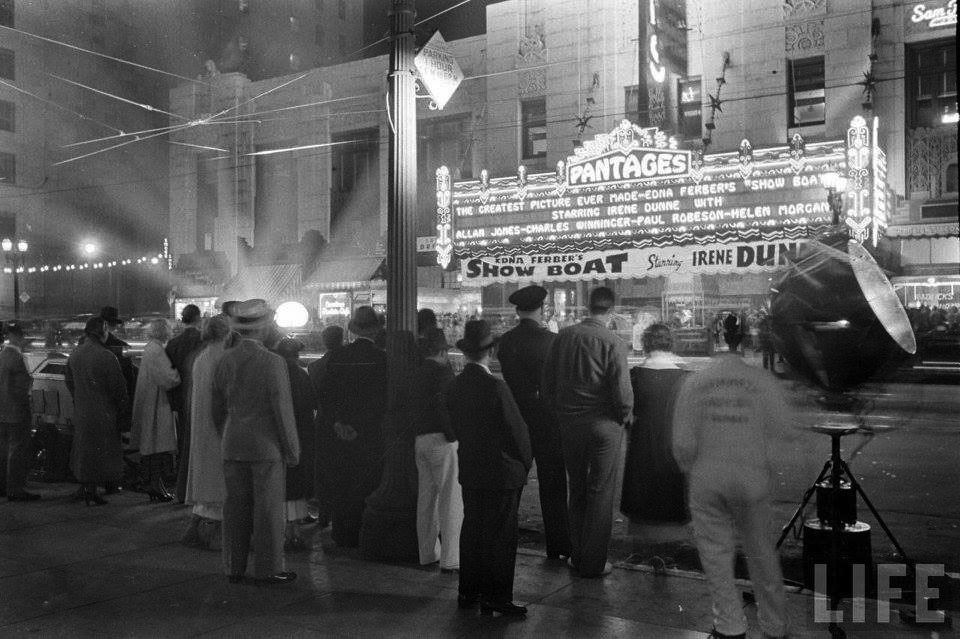 |
|
| (1936)+#+ – Life Magazine photo showing a crowd gathered across Hollywood Boulevard from the Pantages Theatre as Universal Pictures hold a whiz-bang premiere for “Show Boat”. Notice how the marquee claims it is “The Greatest Picture Ever Made”. LIFE Magazine |
Historical Notes Universal Pictures had filmed the part-talkie Show Boat which was released in 1929. Carl Laemmle, head of Universal, had been deeply dissatisfied with that film, and wanted to make an all-sound version of the musical. It was originally scheduled to be made in 1934, but plans to make this version with Russ Columbo as the gambler Gaylord Ravenal fell through when Columbo was killed that year in a shotgun accident, and production of the film was rescheduled. The film, with several members of the original Broadway cast, began principal photography in late 1935 and was released in 1936. In 1996, this version of Show Boat was selected for preservation in the United States National Film Registry by the Library of Congress as being "culturally, historically, or aesthetically significant".*^ |
* * * * * |
N/W Corner of Hollywood and Vine
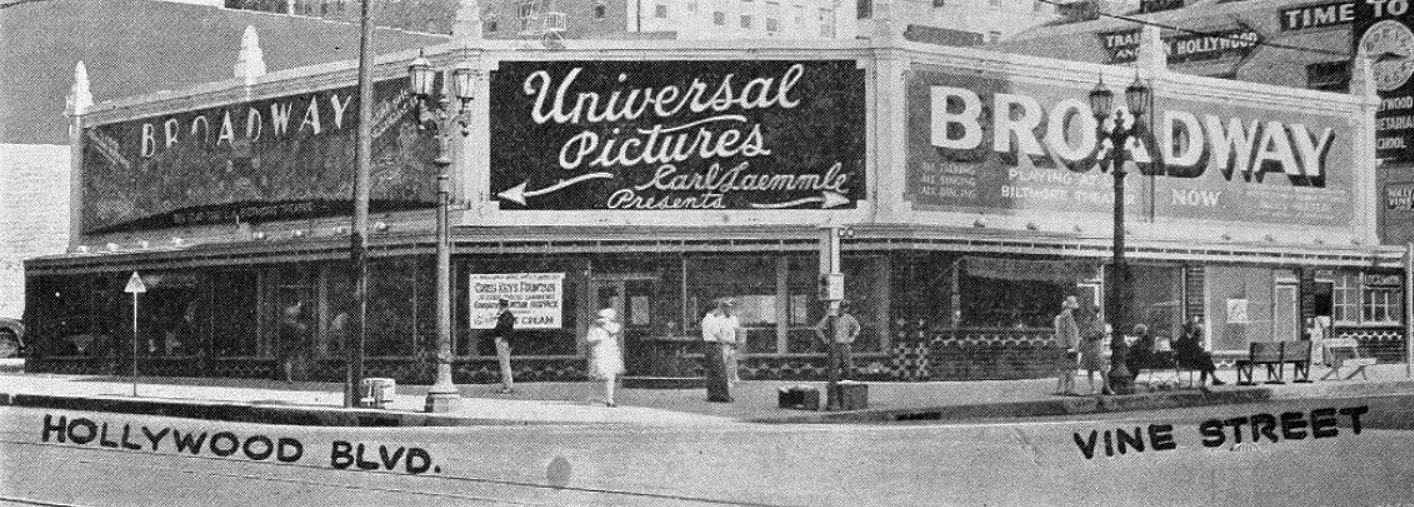 |
|
| (1929)*# – Panoramic view showing the northwest corner of Hollywood and Vine. Signboard on the one-story building reads: Universal Pictures - Carl Laemmle Presents |
Historical Notes In 1915, at the northwest corner of Hollywood and Vine Street sat the home of early Hollywood pioneer and land speculator George Hoover. Hoover was part of the L.A. Pacific Boulevard and Development Company. He was also president of Hollywood's first bank - the Bank of Hollywood and was one of the builders of the fashionable Hollywood Hotel (located at Hollywood and Highland). In 1925 German immigrant and movie maker Carl Laemmle purchased the property from George Hoover for $350,000. Laemmle was president of Universal Pictures Corporation and had a very successful movie studio in the San Fernando Valley. In 1932, Carl Laemmle opened the one story CoCo Tree Café on this corner. In 1940, restaurateur Sidney Hoedemaker of the Pig 'N Whistle - Melody Lane chain, leased the northwest corner Hollywood and Vine transformed it into a Melody Lane Restaurant. This would be followed by Hody's Restaurant in 1954, Howard Johnson's in 1971, and the Brown Derby in the 1980s. The site became a slew of struggling retail and nightclubs such as; Premiere, Jack's Sugar Shack, the Deep, and finally the Basque nightclub. In April 2008 the building went up in flames and the lot has been empty since. #^** |
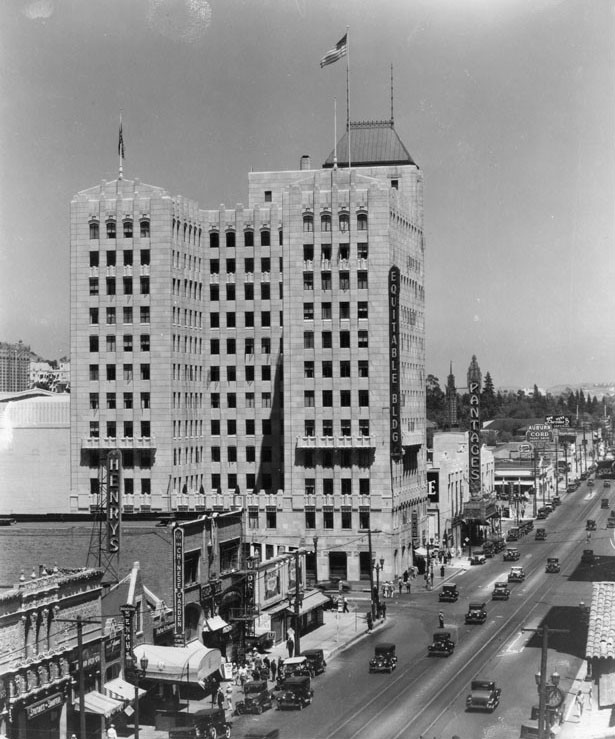 |
|
| (1930)* - View looking west on Hollywood Boulevard showing the Equitable Building and its surrounding area. Pantages Theatre is seen further east. |
Historical Notes Located on the northeast corner of Hollywood and Vine, the 12-story Equitable Building was built in 1929. The Gothic Deco commercial tower was designed by Aleck Curlett.*^ |
Hollywood and Argyle
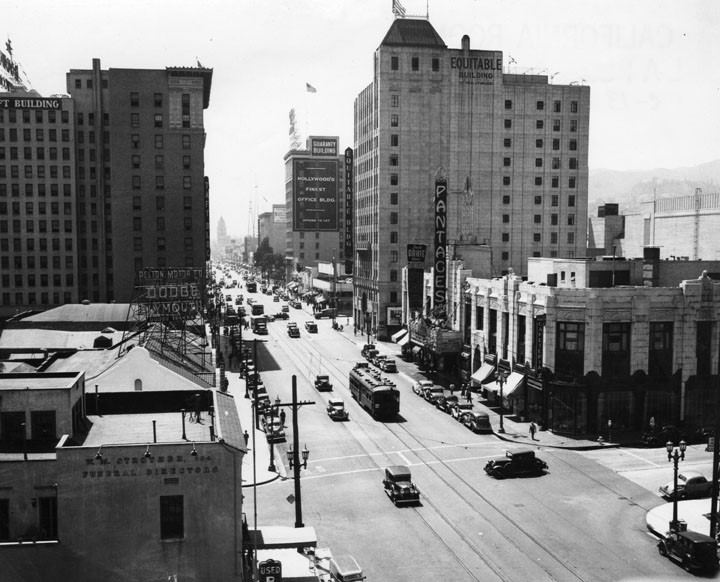 |
|
| (1937)* - Aerial view looking west down Hollywood Boulevard from the intersection with Argyle Avenue. On the left is the Strother Funeral Directors building, and beyond it a Dodge Plymouth motor car dealer, and past that, the Taft Building. Going down the right side of the street we see the Pantages Theatre, and beyond that the Equitable Building and then the Guaranty Building. |
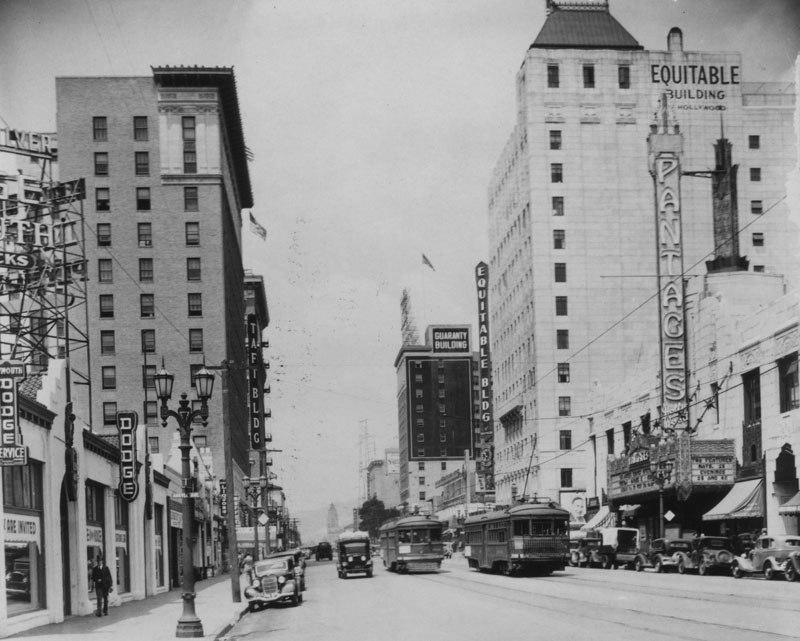 |
|
| (1936)* - View looking west on Hollywood Boulevard showing the Pantages Theatre on the right. One block to the west is the intersection of Hollywood and Vine where three taller buildings stand (Equitable Building, Taft Building, and Broadway-Hollywood Building). |
 |
|
| (1936)^^ - Another view looking west toward the intersection of Hollywood and Vine showing the Pantages Theatre, Equitable Building, Taft Building, and Broadway-Hollywood Building. |
Then and Now
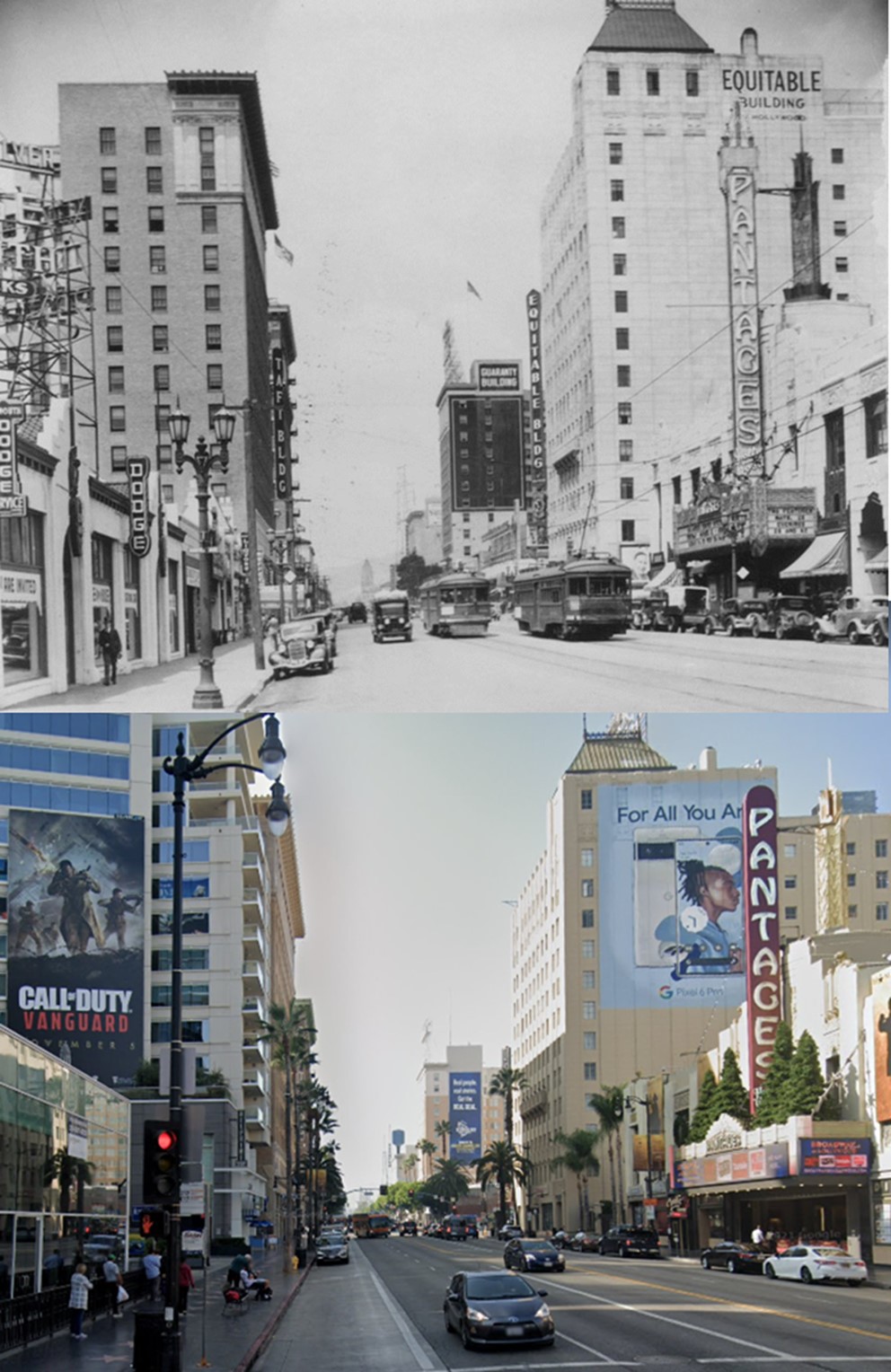 |
|
| (1936 vs. 2022)* - Looking west on Hollywood Boulevard from Argyle Avenue with the Pantages Theatre seen on the right. Note some of the changes…especially the streetcars and streetlights. |
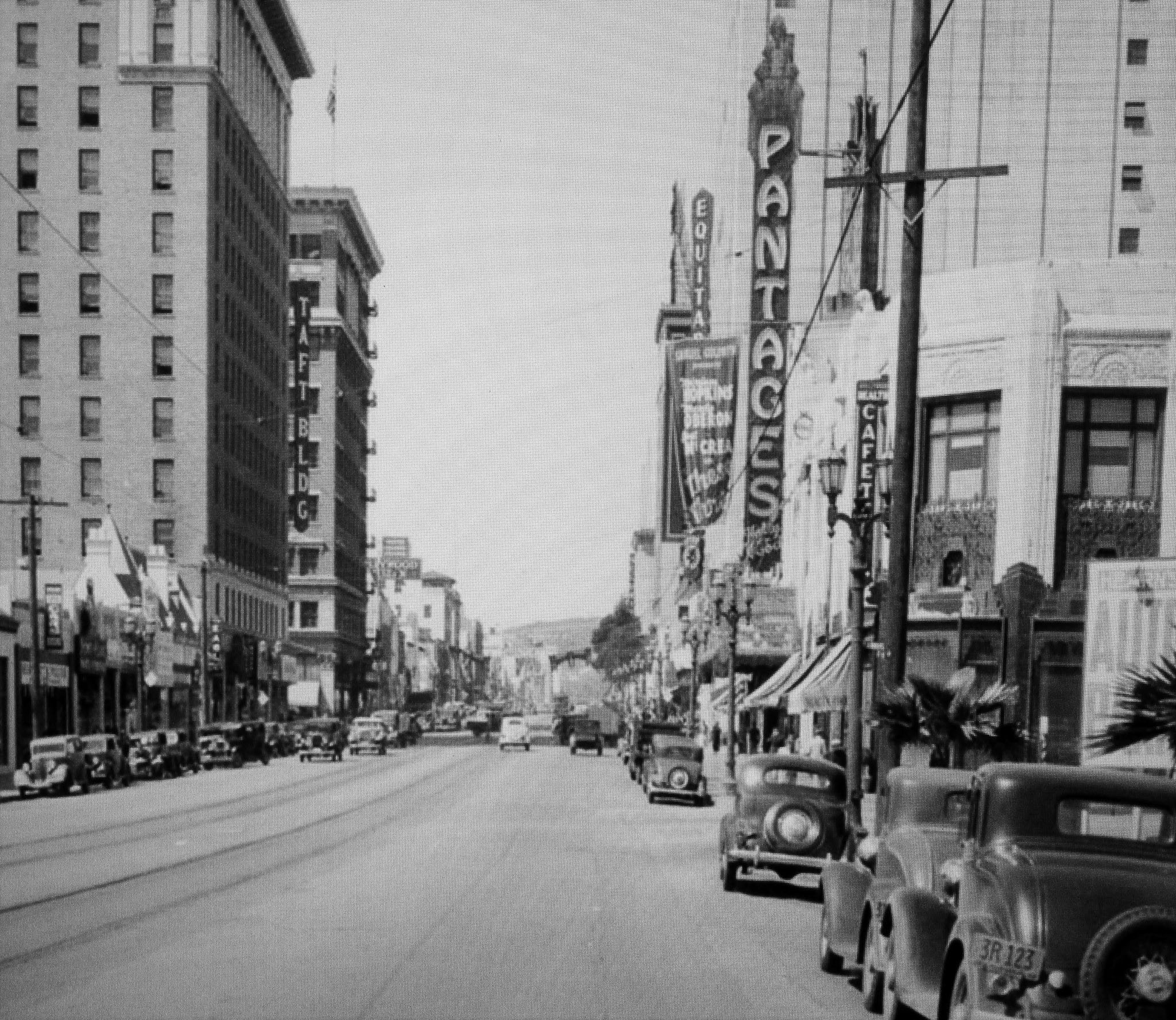 |
|
| (ca. 1936)^*^ – View looking west on Hollywood Boulevard toward Vine Street from near Argyle Avenue. Several iconic buildings and their signs can be seen including: Pantages Theatre, Taft Building, and the Equitable Buildin. |
Vine Street
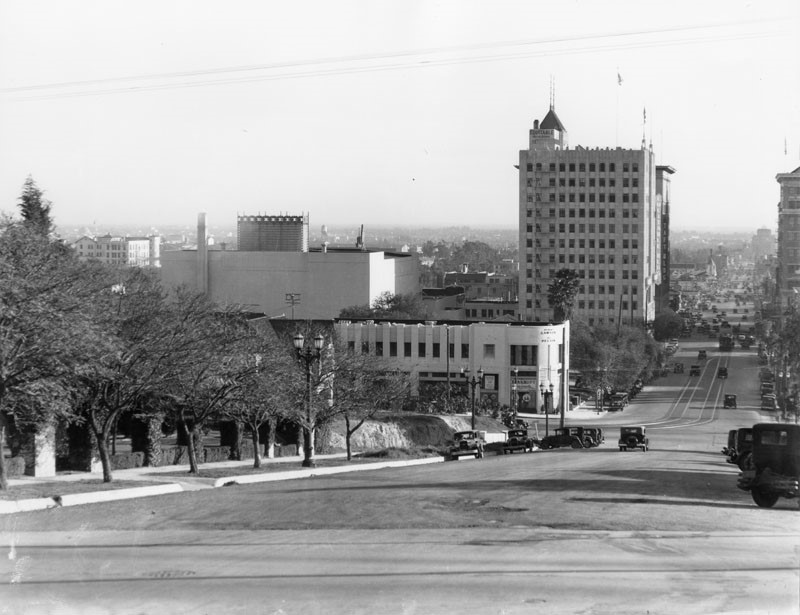 |
|
| (1930s)* - View looking south on Vine Street towards Yucca Street. The Capitol Records Building would not be built for another twenty plus years. It would stand on the east side of Vine between Yucca and the Equitable Building (NE corner of Hollywood and Vine). |
Then and Now
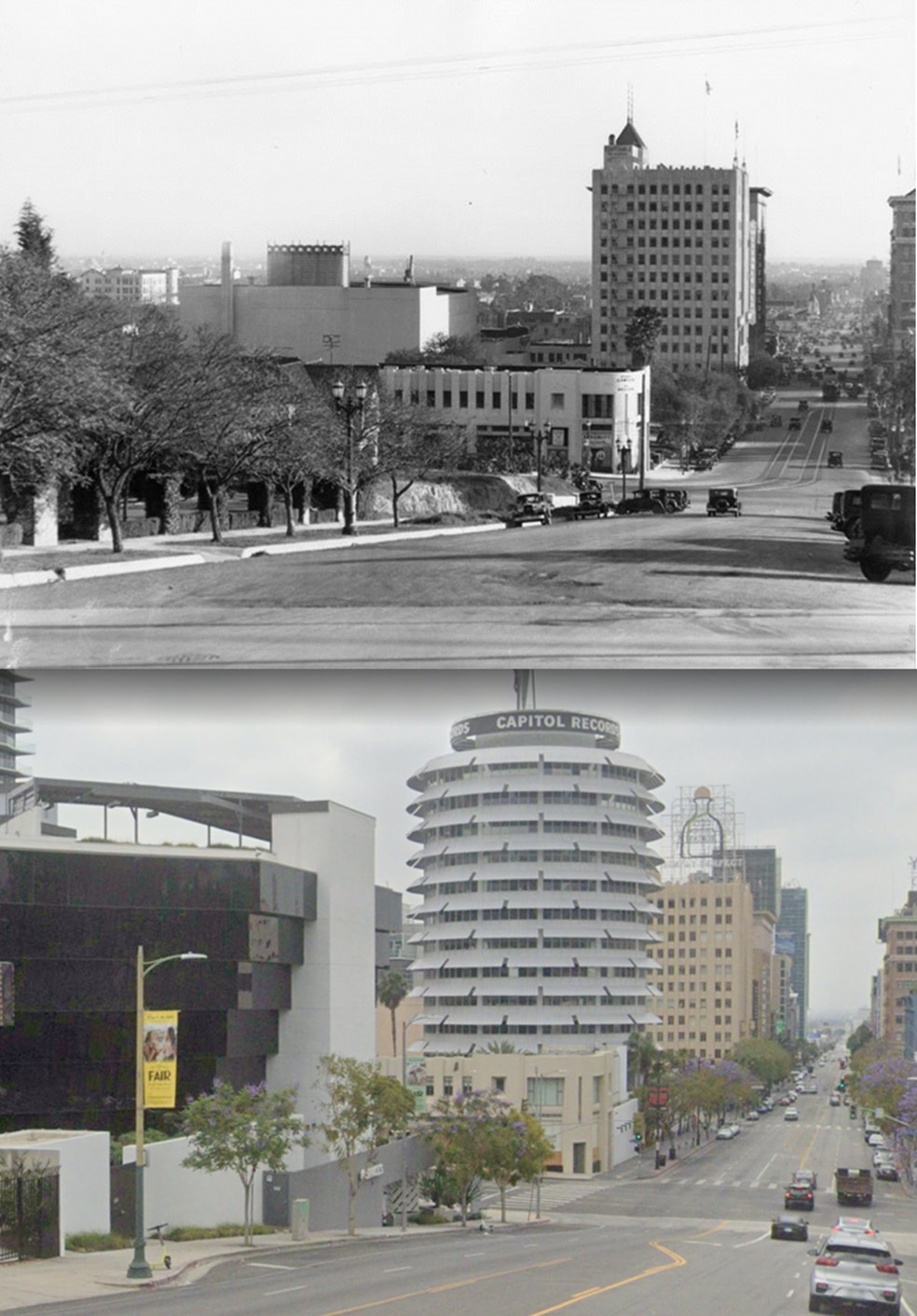 |
|
| (1930s vs. 2022)* – Looking south on Vine Street toward Yucca Street showing the changing Hollywood skyline. The landmark Capitol Records Building was built in 1956. |
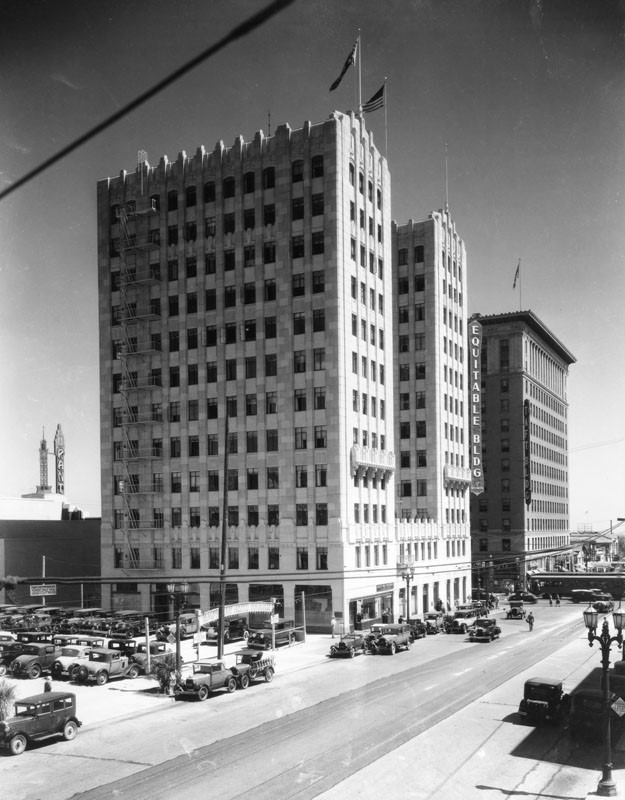 |
|
| (ca. 1930)* - View looking south on Vine Street showing the Equitable Building on the northeast corner of Hollywood and Vine with its large marquee hanging on the edge of the building. At left can be seen the sign of Pantages Theatre (also built in 1930) which stands just east of the Equitable Building and fronts Hollywood Boulevard. The 12-story Taft Building is across the street on the southeast corner. |
Historical Notes The Equitable Building of Hollywood was the second high-rise office building built at the intersection of Hollywood and Vine and would be a symbol of the new money that was being invested in Hollywood. The Taft Building, across the street was the first (built in 1927).+** |
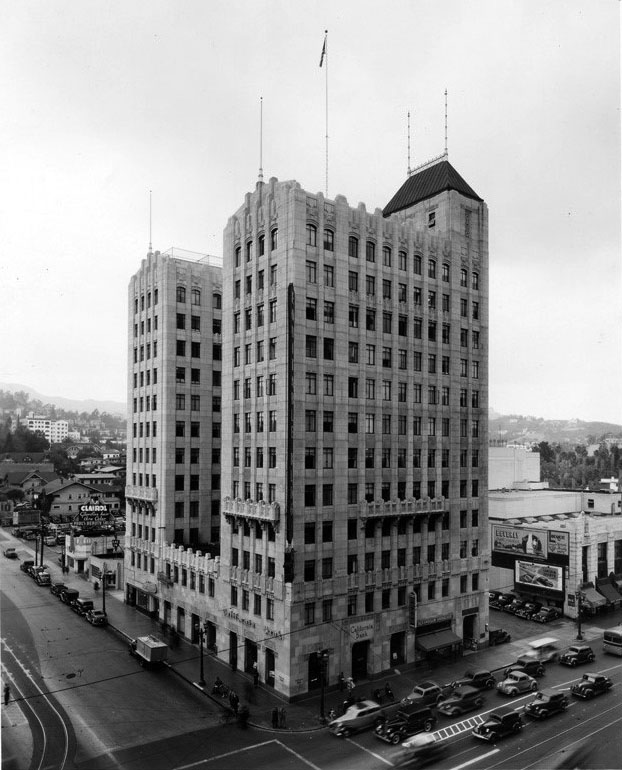 |
|
| (ca. 1937)^^^ - View looking at the northeast corner of Hollywood and Vine showing the 12-story Equitable Building. A portion of the Pantages Theatre is at far right. |
Historical Notes When the Equitable Building was planned in 1927, it would be required to conform to a certain height limit of 150 feet on the NE corner which was for many years the site of a house and later a used auto lot. In 1926 a one-story bank building was built on the site and served the intersection there until the property was cleared for construction in 1929. +** |
* * * * * |
Please Support Our CauseWater and Power Associates, Inc. is a non-profit, public service organization dedicated to preserving historical records and photos. Your generosity allows us to continue to disseminate knowledge of the rich and diverse multicultural history of the greater Los Angeles area; to serve as a resource of historical information; and to assist in the preservation of the city's historic records.
|
More Historical Early Views
Newest Additions
Early LA Buildings and City Views
History of Water and Electricity in Los Angeles
* * * * * |
References and Credits
* LA Public Library Image Archive
^* California Historic Landmark Listing (Los Angeles)
^ California Historical Society Digital Archive
** Retronaut - Hollywoodland Sign
^^^California State Library Image Archive
***The Story of Hollywood by Gregory Paul Williams
**^Table Magazine: LA Observatory
^**Huntington Digital Library Archive
^*#West Hollywood Patch: Bancroft Middle School
^^*Cinema Treasures:Ricardo Montabaln Theater
^^#LA Times: 'Swing in, pig out, drive off'; Hollywood American Legion Post 43; Christie Hotel; Making Waves - Japanese American Photography, 1920-1940
#**This Day in Aviation: Lockheed Vega 1
+**HollywoodHeritage.com: The Equitable Building of Hollywood
+##Los Angeles Conservancy: El Capitan Theatre
#*^Hollywood Chamber of Commerce History
#^*Pinterest.com: Old Hollywood
##^UC Santa Cruz Digital Archive
##+Facebook.com: Los Angeles Railroad Heritage Foundation
*^*MTA Transportation and Research Library Archives
++++Stuff.co.nz: Roosevelt Hotel
**##MartinTurnbill.com: Roos Bros. Clothing Store
^*^*HollywoodHeritage.com: The Muller Family Foundation
^*^#Facebook.com - Bizarre Los Angeles
*^^^Pinterest.com: Hollywood History
*#*^PlantTrout.worldpress: Musso and Frank Grill
^#^^Facebook.com - Vintage LA: Musso & Franks Grill; Hollywood Ranch Market
#^**The Go Go's: N/W Corner of Hollywood and Vine
#**#Facebook.com: Garden of Allah Novels, Martin Turnbull
#*^#Historic Hollywood Theatres: Warner Bros. Hollywood Theatre
#*#*Musso and Frank History: mussoandfrank.com
###^Timeout.com: Ricardo Montalban Theatre
#*^*Hidden Los Angeles: Musso and Frank's Grill
*# Skyscraperage.com. - Griffith Observatory; Muller Bros. Service Station; El Capitan Theater; Hollywood and Vine, 1929; Outpost Sign
*^ Wikipedia: Hollywood; Hollywood Athletic Club; Hollywood Bowl; Grauman's Chinese Theatre; Grauman's Egyptian Theatre; Pantages Theatre (Hollywood); John Hanson Ford Theatre; 20th Century Fox; Samuel Goldwyn.Studio; Barnsdall Art Park; Greek Theatre; Griffith Observatory; Cinerama Dome; Ralphs; Hollywood Palladium; Hollywood and Vine; Hollywood Masonic Temple; Hollywood Pacific Theatre; Max Factor; West Hollywood; Brown Derby; Hollywood Christmas Parade; Mt. Lee; Château Élysée; Hell's Angels (film); Morocco (1930 film); KFWB; Hollywood Playhouse (Avalon Hollywood); RKO Pictures; Musso and Frank Grill; Gene Harlow; Hollyhock House; Hollywood Roosevelt Hotel; Lux Radio Theatre; American Legion; El Capitan Theatre
< Back
Menu
- Home
- Mission
- Museum
- Major Efforts
- Recent Newsletters
- Historical Op Ed Pieces
- Board Officers and Directors
- Mulholland/McCarthy Service Awards
- Positions on Owens Valley and the City of Los Angeles Issues
- Legislative Positions on
Water Issues
- Legislative Positions on
Energy Issues
- Membership
- Contact Us
- Search Index